Quick filters:
Medieval english nobles Stock Photos and Images
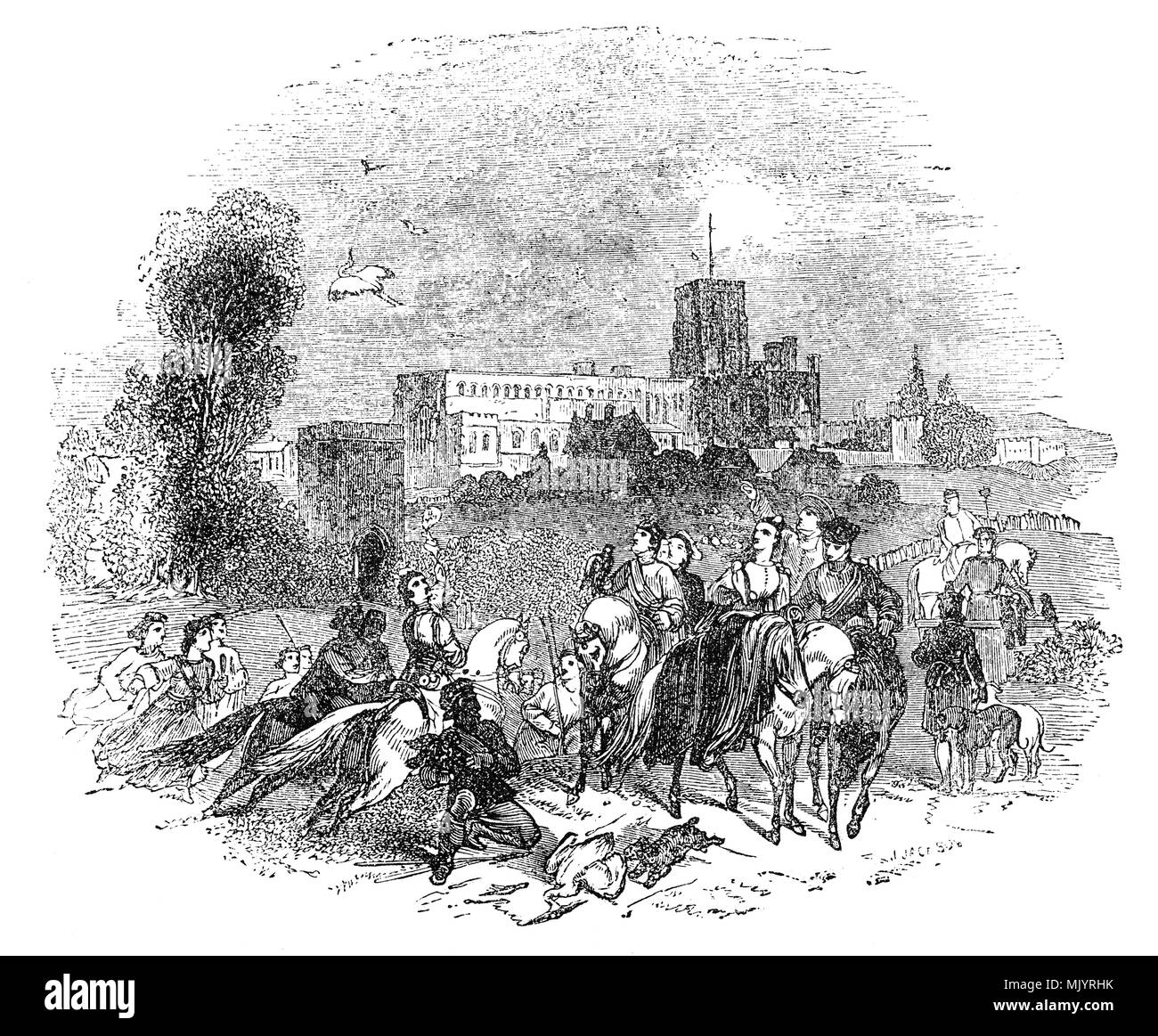 A Medieval Hawking and Hunting scene at St Albans in Hertfordshire. They were favorite pastimes for the Medieval Upper Classes including the Nobles of England and English Royalty. It was referred to as the sport of royalty, because Lower Class Medieval people such as peasants and serfs could not easily afford to train the birds. Falconry provided an opportunity for kings, lords and nobles to host grand hunting parties. Hawks were the most popular choice for hunting birds Stock Photohttps://www.alamy.com/image-license-details/?v=1https://www.alamy.com/a-medieval-hawking-and-hunting-scene-at-st-albans-in-hertfordshire-they-were-favorite-pastimes-for-the-medieval-upper-classes-including-the-nobles-of-england-and-english-royalty-it-was-referred-to-as-the-sport-of-royalty-because-lower-class-medieval-people-such-as-peasants-and-serfs-could-not-easily-afford-to-train-the-birds-falconry-provided-an-opportunity-for-kings-lords-and-nobles-to-host-grand-hunting-parties-hawks-were-the-most-popular-choice-for-hunting-birds-image183778719.html
A Medieval Hawking and Hunting scene at St Albans in Hertfordshire. They were favorite pastimes for the Medieval Upper Classes including the Nobles of England and English Royalty. It was referred to as the sport of royalty, because Lower Class Medieval people such as peasants and serfs could not easily afford to train the birds. Falconry provided an opportunity for kings, lords and nobles to host grand hunting parties. Hawks were the most popular choice for hunting birds Stock Photohttps://www.alamy.com/image-license-details/?v=1https://www.alamy.com/a-medieval-hawking-and-hunting-scene-at-st-albans-in-hertfordshire-they-were-favorite-pastimes-for-the-medieval-upper-classes-including-the-nobles-of-england-and-english-royalty-it-was-referred-to-as-the-sport-of-royalty-because-lower-class-medieval-people-such-as-peasants-and-serfs-could-not-easily-afford-to-train-the-birds-falconry-provided-an-opportunity-for-kings-lords-and-nobles-to-host-grand-hunting-parties-hawks-were-the-most-popular-choice-for-hunting-birds-image183778719.htmlRMMJYRHK–A Medieval Hawking and Hunting scene at St Albans in Hertfordshire. They were favorite pastimes for the Medieval Upper Classes including the Nobles of England and English Royalty. It was referred to as the sport of royalty, because Lower Class Medieval people such as peasants and serfs could not easily afford to train the birds. Falconry provided an opportunity for kings, lords and nobles to host grand hunting parties. Hawks were the most popular choice for hunting birds
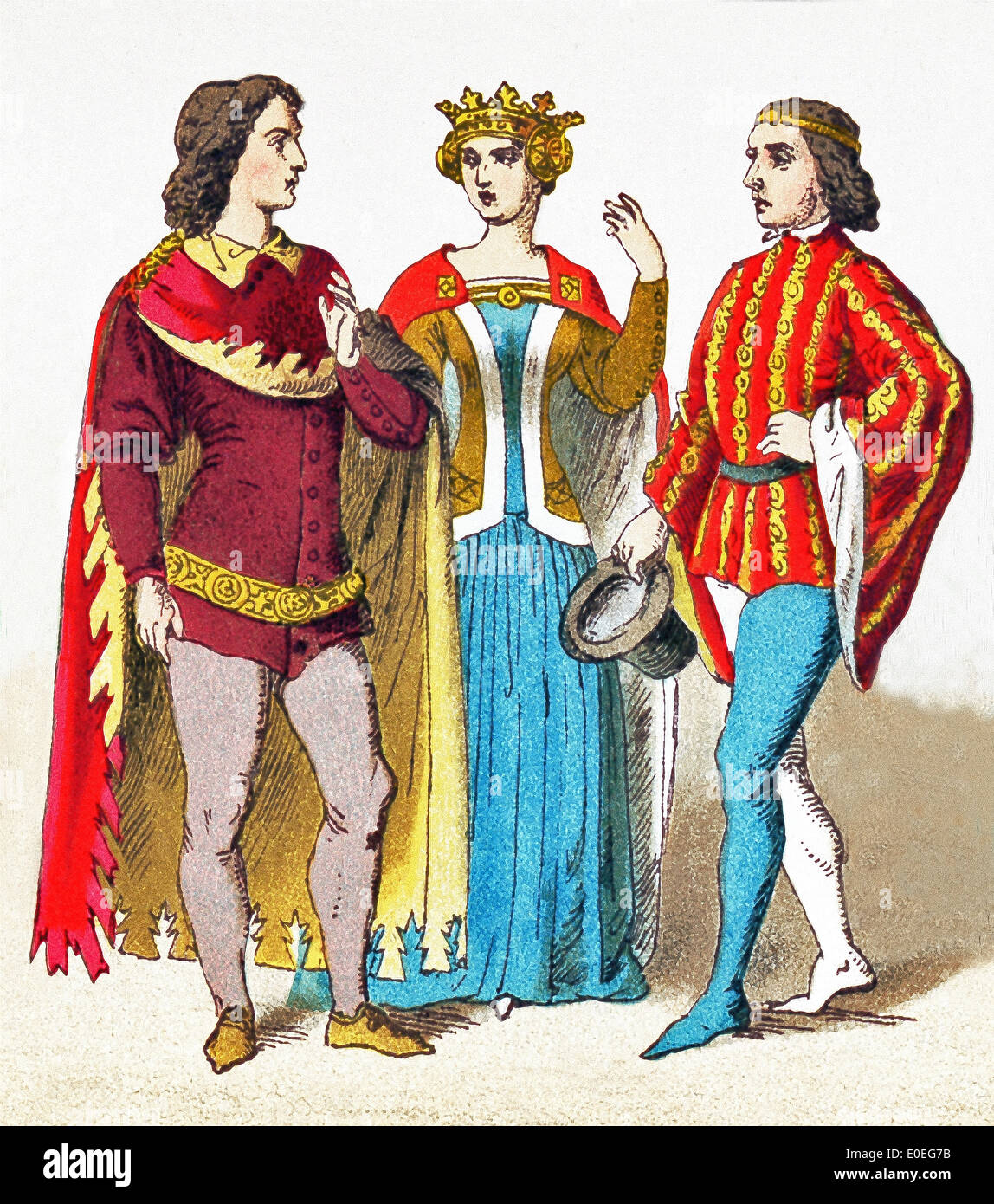 The English people represented here are: two people belonging to the court in the 1300s and a man of rank in 1377. Stock Photohttps://www.alamy.com/image-license-details/?v=1https://www.alamy.com/the-english-people-represented-here-are-two-people-belonging-to-the-image69161551.html
The English people represented here are: two people belonging to the court in the 1300s and a man of rank in 1377. Stock Photohttps://www.alamy.com/image-license-details/?v=1https://www.alamy.com/the-english-people-represented-here-are-two-people-belonging-to-the-image69161551.htmlRME0EG7B–The English people represented here are: two people belonging to the court in the 1300s and a man of rank in 1377.
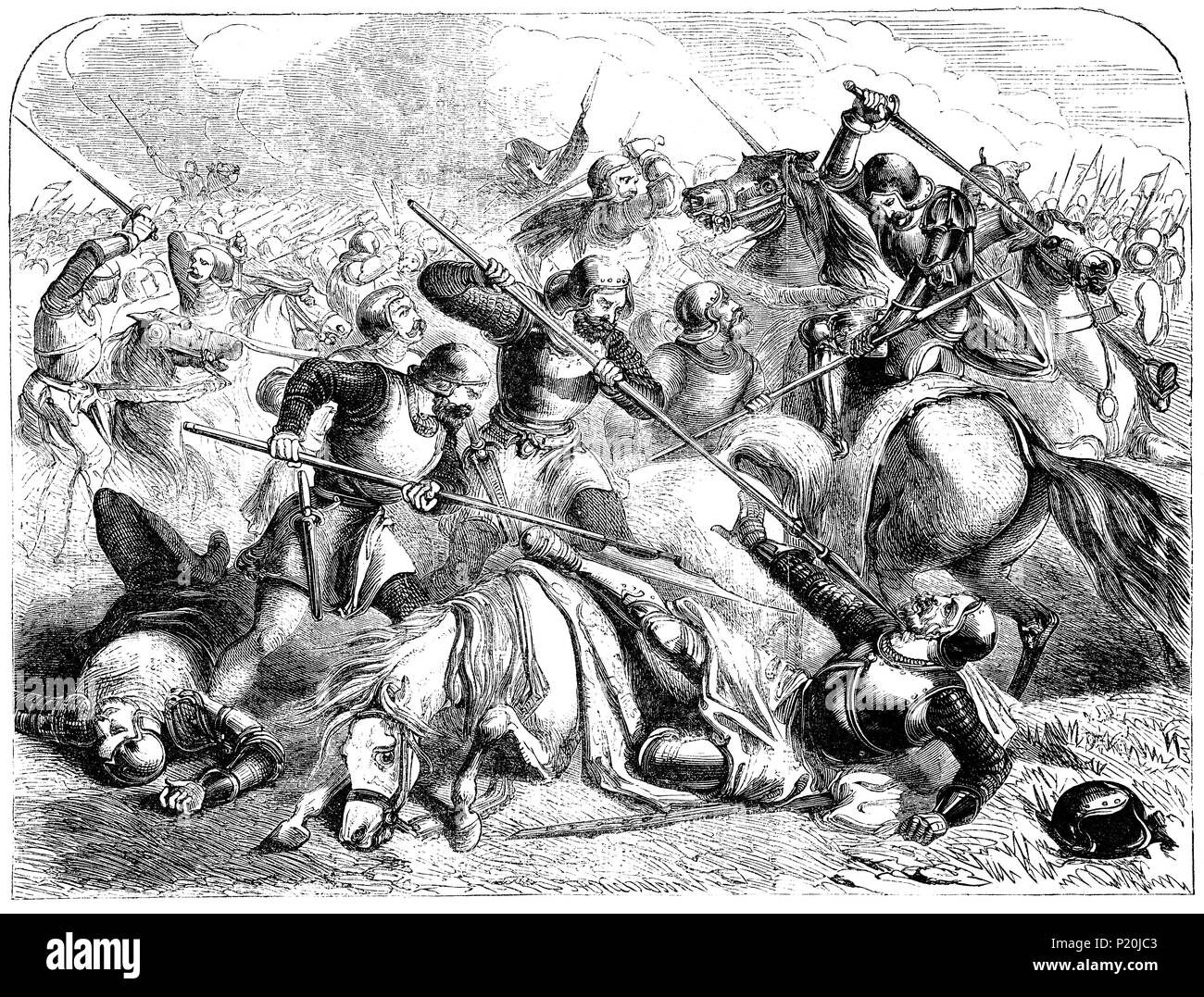 The Death of John Talbot, 2nd Earl of Shrewsbury, (1417-1460) was an English nobleman and soldier who died during the Battle of Northampton, fought on 10 July 1460 near the River Nene, Northamptonshire. It was a major battle of the Wars of the Roses and the first in which artillery was used in England. The opposing forces were an army led by nobles loyal to King Henry VI of the House of Lancaster, on one side, and the victorious Yorkist army of Edward, Earl of March and Warwick the Kingmaker on the other. Stock Photohttps://www.alamy.com/image-license-details/?v=1https://www.alamy.com/the-death-of-john-talbot-2nd-earl-of-shrewsbury-1417-1460-was-an-english-nobleman-and-soldier-who-died-during-the-battle-of-northampton-fought-on-10-july-1460-near-the-river-nene-northamptonshire-it-was-a-major-battle-of-the-wars-of-the-roses-and-the-first-in-which-artillery-was-used-in-england-the-opposing-forces-were-an-army-led-by-nobles-loyal-to-king-henry-vi-of-the-house-of-lancaster-on-one-side-and-the-victorious-yorkist-army-of-edward-earl-of-march-and-warwick-the-kingmaker-on-the-other-image207768179.html
The Death of John Talbot, 2nd Earl of Shrewsbury, (1417-1460) was an English nobleman and soldier who died during the Battle of Northampton, fought on 10 July 1460 near the River Nene, Northamptonshire. It was a major battle of the Wars of the Roses and the first in which artillery was used in England. The opposing forces were an army led by nobles loyal to King Henry VI of the House of Lancaster, on one side, and the victorious Yorkist army of Edward, Earl of March and Warwick the Kingmaker on the other. Stock Photohttps://www.alamy.com/image-license-details/?v=1https://www.alamy.com/the-death-of-john-talbot-2nd-earl-of-shrewsbury-1417-1460-was-an-english-nobleman-and-soldier-who-died-during-the-battle-of-northampton-fought-on-10-july-1460-near-the-river-nene-northamptonshire-it-was-a-major-battle-of-the-wars-of-the-roses-and-the-first-in-which-artillery-was-used-in-england-the-opposing-forces-were-an-army-led-by-nobles-loyal-to-king-henry-vi-of-the-house-of-lancaster-on-one-side-and-the-victorious-yorkist-army-of-edward-earl-of-march-and-warwick-the-kingmaker-on-the-other-image207768179.htmlRMP20JC3–The Death of John Talbot, 2nd Earl of Shrewsbury, (1417-1460) was an English nobleman and soldier who died during the Battle of Northampton, fought on 10 July 1460 near the River Nene, Northamptonshire. It was a major battle of the Wars of the Roses and the first in which artillery was used in England. The opposing forces were an army led by nobles loyal to King Henry VI of the House of Lancaster, on one side, and the victorious Yorkist army of Edward, Earl of March and Warwick the Kingmaker on the other.
 Halftone of an English banquet in the 11th century. From a set of school posters for history and social studies c 1930 Stock Photohttps://www.alamy.com/image-license-details/?v=1https://www.alamy.com/halftone-of-an-english-banquet-in-the-11th-century-from-a-set-of-school-posters-for-history-and-social-studies-c-1930-image369363462.html
Halftone of an English banquet in the 11th century. From a set of school posters for history and social studies c 1930 Stock Photohttps://www.alamy.com/image-license-details/?v=1https://www.alamy.com/halftone-of-an-english-banquet-in-the-11th-century-from-a-set-of-school-posters-for-history-and-social-studies-c-1930-image369363462.htmlRM2CCWXT6–Halftone of an English banquet in the 11th century. From a set of school posters for history and social studies c 1930
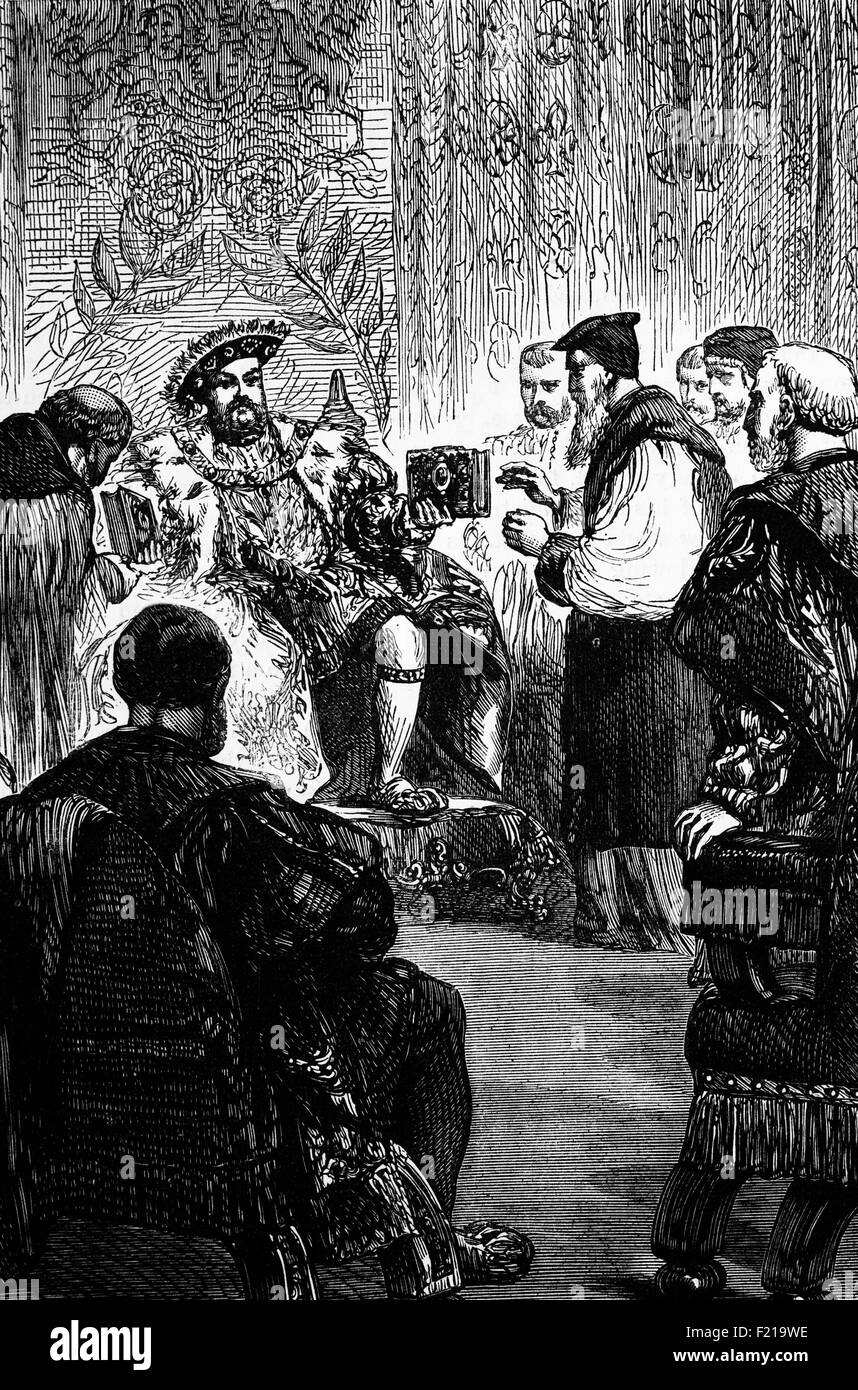 King Henry VIII delivering the Great Bible to his Lords in 1539. It was the first edition of the Bible in English and authorised by King Henry VIII of England to be read aloud in the church services of the Church of England. The Great Bible was prepared by Myles Coverdale, working under commission of Thomas, Lord Cromwell. The English translationbecame a formidable prop for his new-found religious order. Stock Photohttps://www.alamy.com/image-license-details/?v=1https://www.alamy.com/stock-photo-king-henry-viii-delivering-the-great-bible-to-his-lords-in-1539-it-87310874.html
King Henry VIII delivering the Great Bible to his Lords in 1539. It was the first edition of the Bible in English and authorised by King Henry VIII of England to be read aloud in the church services of the Church of England. The Great Bible was prepared by Myles Coverdale, working under commission of Thomas, Lord Cromwell. The English translationbecame a formidable prop for his new-found religious order. Stock Photohttps://www.alamy.com/image-license-details/?v=1https://www.alamy.com/stock-photo-king-henry-viii-delivering-the-great-bible-to-his-lords-in-1539-it-87310874.htmlRMF219WE–King Henry VIII delivering the Great Bible to his Lords in 1539. It was the first edition of the Bible in English and authorised by King Henry VIII of England to be read aloud in the church services of the Church of England. The Great Bible was prepared by Myles Coverdale, working under commission of Thomas, Lord Cromwell. The English translationbecame a formidable prop for his new-found religious order.
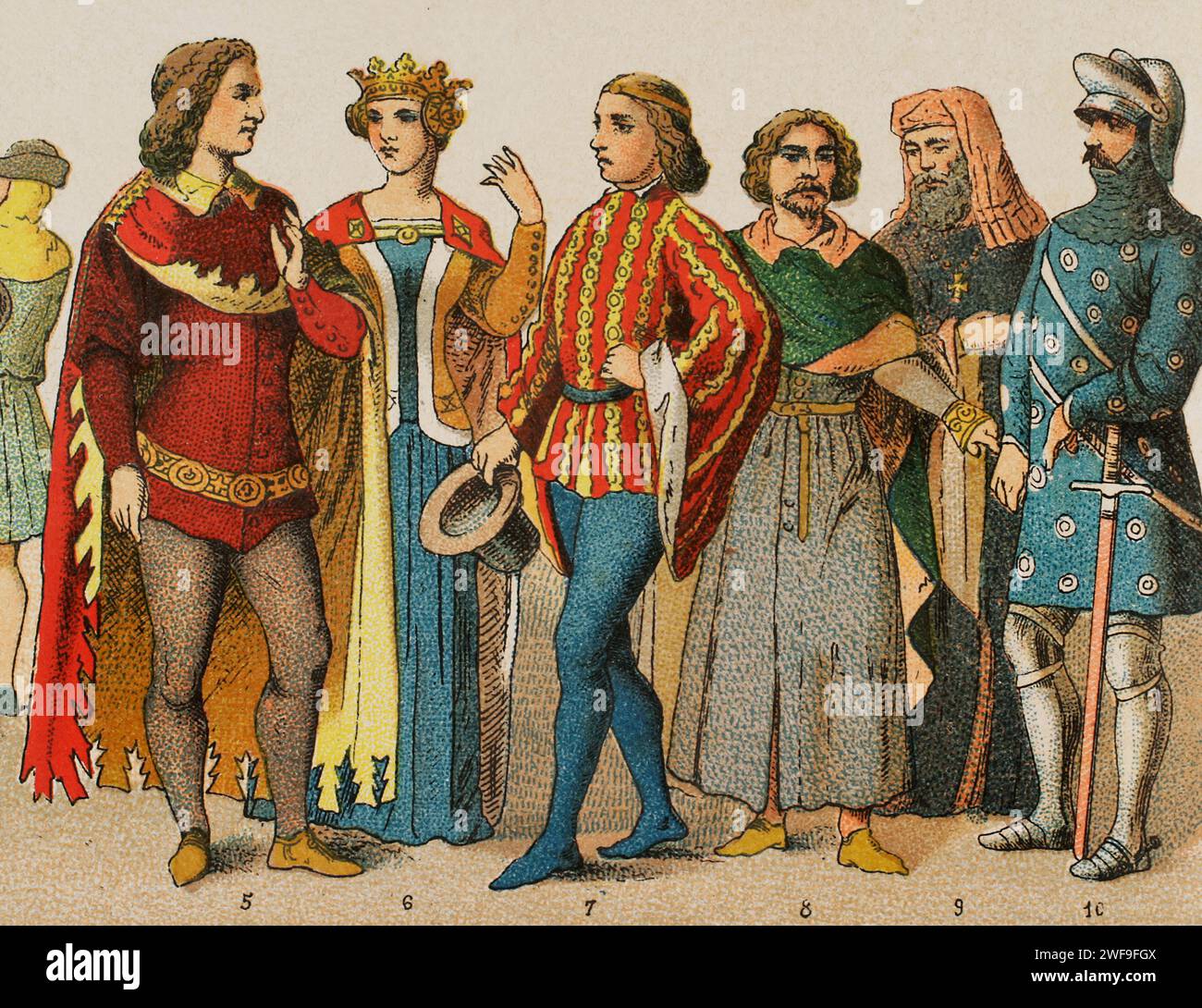 History of England. 1300-1400. From left to right, 5-6: court dresses, 7: knight, 8: citizen (ordinary people), 9: lord, 10: knight, 1377. Chromolithography. Detail. 'Historia Universal', by César Cantú. Volume VI, 1885. Stock Photohttps://www.alamy.com/image-license-details/?v=1https://www.alamy.com/history-of-england-1300-1400-from-left-to-right-5-6-court-dresses-7-knight-8-citizen-ordinary-people-9-lord-10-knight-1377-chromolithography-detail-historia-universal-by-csar-cant-volume-vi-1885-image594582154.html
History of England. 1300-1400. From left to right, 5-6: court dresses, 7: knight, 8: citizen (ordinary people), 9: lord, 10: knight, 1377. Chromolithography. Detail. 'Historia Universal', by César Cantú. Volume VI, 1885. Stock Photohttps://www.alamy.com/image-license-details/?v=1https://www.alamy.com/history-of-england-1300-1400-from-left-to-right-5-6-court-dresses-7-knight-8-citizen-ordinary-people-9-lord-10-knight-1377-chromolithography-detail-historia-universal-by-csar-cant-volume-vi-1885-image594582154.htmlRM2WF9FGX–History of England. 1300-1400. From left to right, 5-6: court dresses, 7: knight, 8: citizen (ordinary people), 9: lord, 10: knight, 1377. Chromolithography. Detail. 'Historia Universal', by César Cantú. Volume VI, 1885.
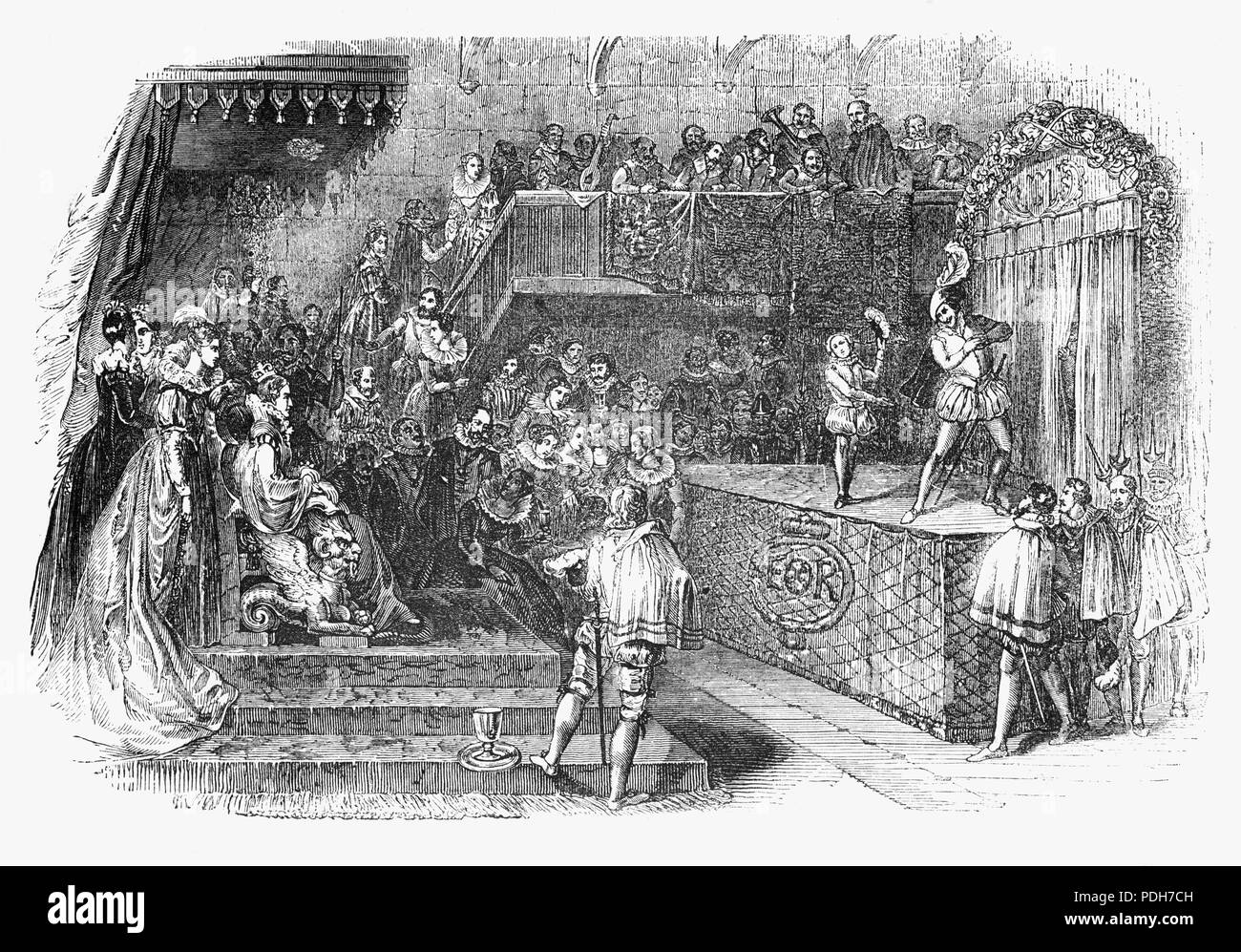 Queen Elizabeth I watching a play. Under Elizabeth, the drama was a unified expression as far as social class was concerned: the Court watched the same plays the commoners saw in the public playhouses. English Renaissance theatre—also known as early modern English theatre and Elizabethan theatre—refers to the theatre of England between 1562 and 1642 written by William Shakespeare, Christopher Marlowe and Ben Jonson. Stock Photohttps://www.alamy.com/image-license-details/?v=1https://www.alamy.com/queen-elizabeth-i-watching-a-play-under-elizabeth-the-drama-was-a-unified-expression-as-far-as-social-class-was-concerned-the-court-watched-the-same-plays-the-commoners-saw-in-the-public-playhouses-english-renaissance-theatrealso-known-as-early-modern-english-theatre-and-elizabethan-theatrerefers-to-the-theatre-of-england-between-1562-and-1642-written-by-william-shakespeare-christopher-marlowe-and-ben-jonson-image214893969.html
Queen Elizabeth I watching a play. Under Elizabeth, the drama was a unified expression as far as social class was concerned: the Court watched the same plays the commoners saw in the public playhouses. English Renaissance theatre—also known as early modern English theatre and Elizabethan theatre—refers to the theatre of England between 1562 and 1642 written by William Shakespeare, Christopher Marlowe and Ben Jonson. Stock Photohttps://www.alamy.com/image-license-details/?v=1https://www.alamy.com/queen-elizabeth-i-watching-a-play-under-elizabeth-the-drama-was-a-unified-expression-as-far-as-social-class-was-concerned-the-court-watched-the-same-plays-the-commoners-saw-in-the-public-playhouses-english-renaissance-theatrealso-known-as-early-modern-english-theatre-and-elizabethan-theatrerefers-to-the-theatre-of-england-between-1562-and-1642-written-by-william-shakespeare-christopher-marlowe-and-ben-jonson-image214893969.htmlRMPDH7CH–Queen Elizabeth I watching a play. Under Elizabeth, the drama was a unified expression as far as social class was concerned: the Court watched the same plays the commoners saw in the public playhouses. English Renaissance theatre—also known as early modern English theatre and Elizabethan theatre—refers to the theatre of England between 1562 and 1642 written by William Shakespeare, Christopher Marlowe and Ben Jonson.
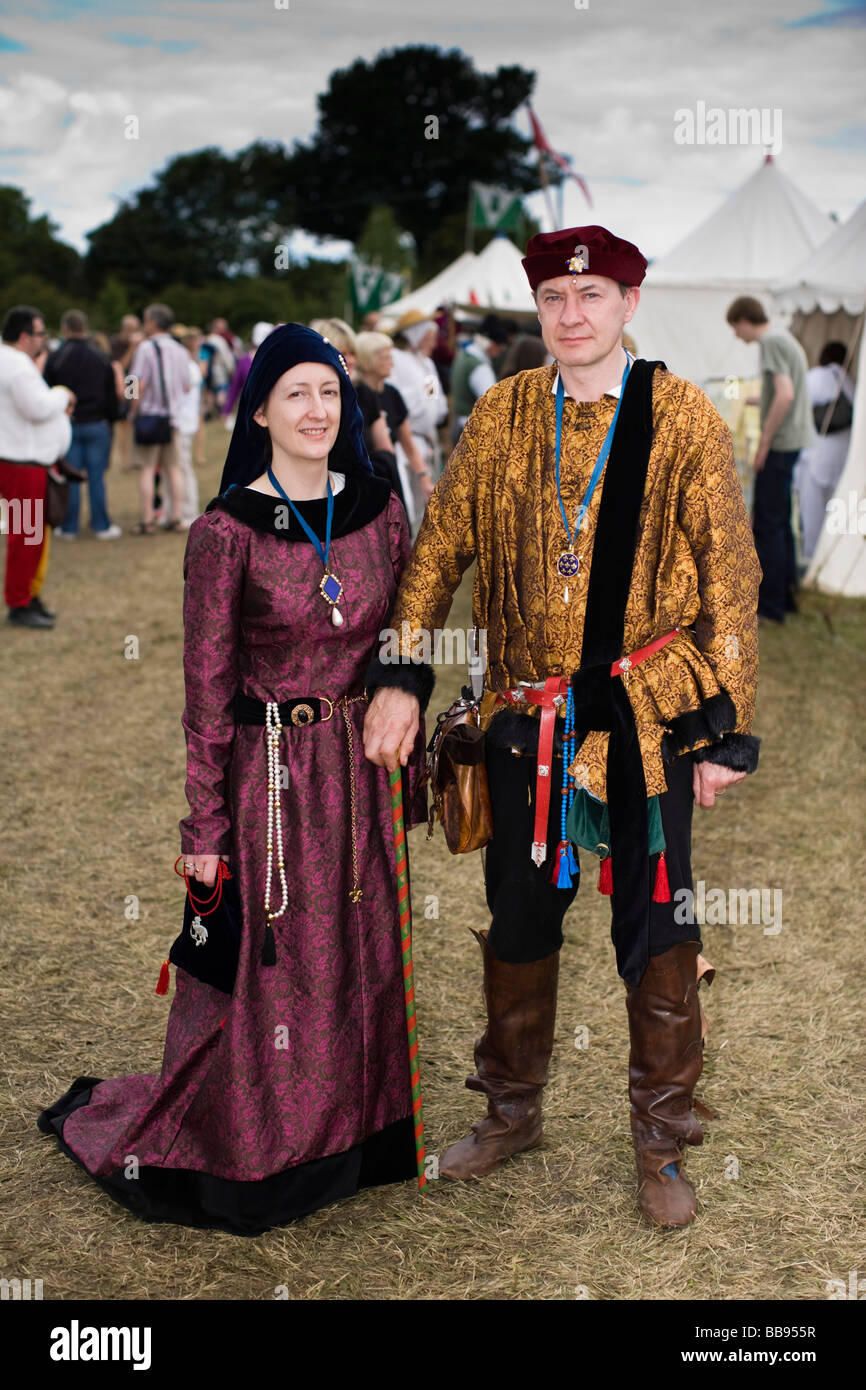 A couple the medieval costume of nobles at Tewkesbury Medieval Festival 2008 Stock Photohttps://www.alamy.com/image-license-details/?v=1https://www.alamy.com/stock-photo-a-couple-the-medieval-costume-of-nobles-at-tewkesbury-medieval-festival-24173235.html
A couple the medieval costume of nobles at Tewkesbury Medieval Festival 2008 Stock Photohttps://www.alamy.com/image-license-details/?v=1https://www.alamy.com/stock-photo-a-couple-the-medieval-costume-of-nobles-at-tewkesbury-medieval-festival-24173235.htmlRMBB955R–A couple the medieval costume of nobles at Tewkesbury Medieval Festival 2008
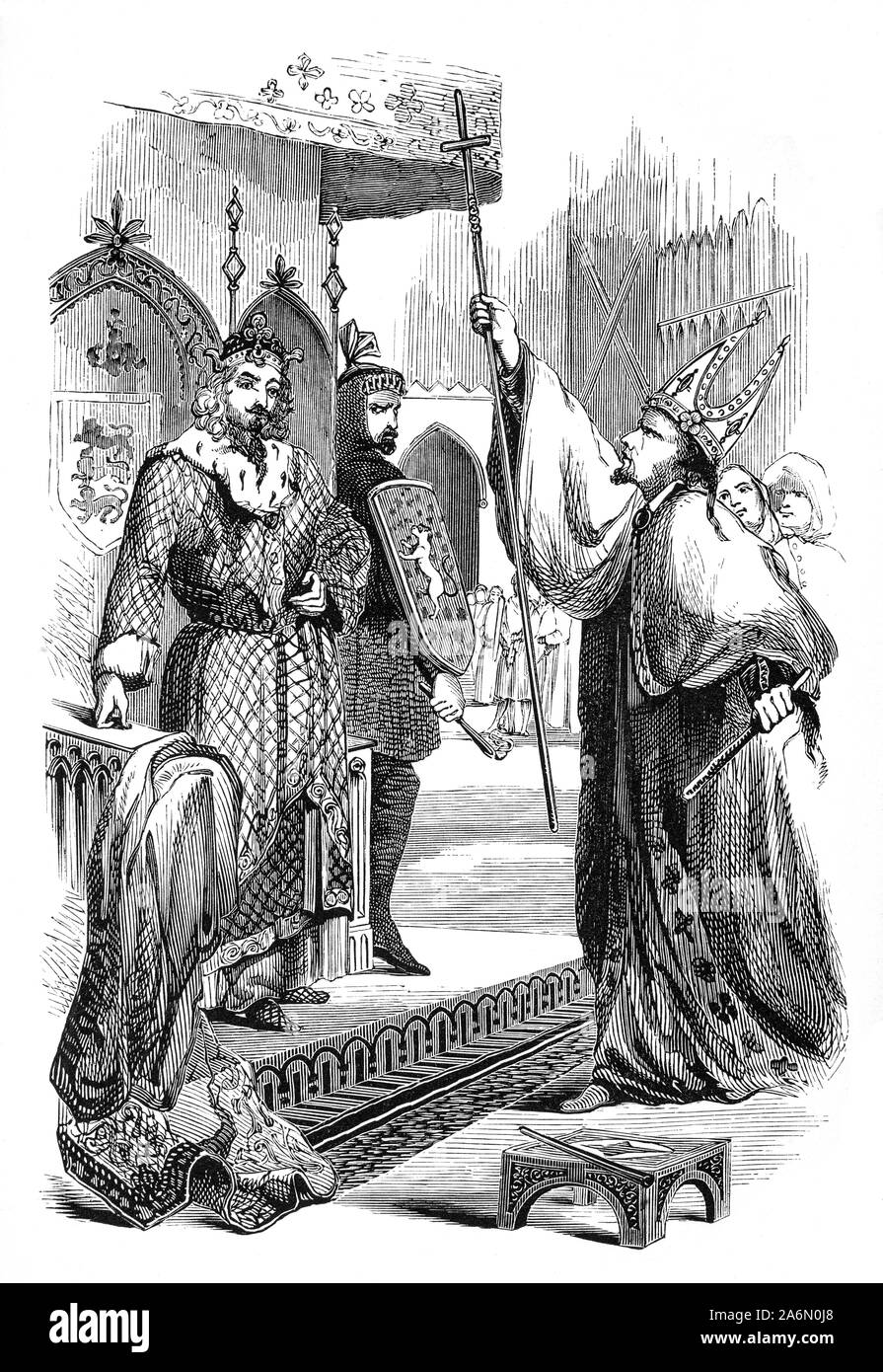 Henry II swearing to observe the Charter of Liberties, also called the Coronation Charter, a written proclamation by Henry I of England, issued upon his accession to the throne in 1100. It sought to bind the King to certain laws regarding the treatment of nobles, church officials, and individuals. Stock Photohttps://www.alamy.com/image-license-details/?v=1https://www.alamy.com/henry-ii-swearing-to-observe-the-charter-of-liberties-also-called-the-coronation-charter-a-written-proclamation-by-henry-i-of-england-issued-upon-his-accession-to-the-throne-in-1100-it-sought-to-bind-the-king-to-certain-laws-regarding-the-treatment-of-nobles-church-officials-and-individuals-image331146432.html
Henry II swearing to observe the Charter of Liberties, also called the Coronation Charter, a written proclamation by Henry I of England, issued upon his accession to the throne in 1100. It sought to bind the King to certain laws regarding the treatment of nobles, church officials, and individuals. Stock Photohttps://www.alamy.com/image-license-details/?v=1https://www.alamy.com/henry-ii-swearing-to-observe-the-charter-of-liberties-also-called-the-coronation-charter-a-written-proclamation-by-henry-i-of-england-issued-upon-his-accession-to-the-throne-in-1100-it-sought-to-bind-the-king-to-certain-laws-regarding-the-treatment-of-nobles-church-officials-and-individuals-image331146432.htmlRM2A6N0J8–Henry II swearing to observe the Charter of Liberties, also called the Coronation Charter, a written proclamation by Henry I of England, issued upon his accession to the throne in 1100. It sought to bind the King to certain laws regarding the treatment of nobles, church officials, and individuals.
 The Battle of Tewkesbury, as illustrated in the Ghent manuscript. The Battle of Tewkesbury, which took place on 4 May 1471, was one of the most decisive battles of the Wars of the Roses in England. King Edward IV and his forces loyal to the House of York completely defeated those of the rival House of Lancaster. The Lancastrian heir to the throne, Edward of Westminster, Prince of Wales, and many prominent Lancastrian nobles were killed during the battle or executed. The Lancastrian king, Henry VI, who was a prisoner in the Tower of London, died shortly after the battle 1483. Stock Photohttps://www.alamy.com/image-license-details/?v=1https://www.alamy.com/the-battle-of-tewkesbury-as-illustrated-in-the-ghent-manuscript-the-battle-of-tewkesbury-which-took-place-on-4-may-1471-was-one-of-the-most-decisive-battles-of-the-wars-of-the-roses-in-england-king-edward-iv-and-his-forces-loyal-to-the-house-of-york-completely-defeated-those-of-the-rival-house-of-lancaster-the-lancastrian-heir-to-the-throne-edward-of-westminster-prince-of-wales-and-many-prominent-lancastrian-nobles-were-killed-during-the-battle-or-executed-the-lancastrian-king-henry-vi-who-was-a-prisoner-in-the-tower-of-london-died-shortly-after-the-battle-1483-image634317329.html
The Battle of Tewkesbury, as illustrated in the Ghent manuscript. The Battle of Tewkesbury, which took place on 4 May 1471, was one of the most decisive battles of the Wars of the Roses in England. King Edward IV and his forces loyal to the House of York completely defeated those of the rival House of Lancaster. The Lancastrian heir to the throne, Edward of Westminster, Prince of Wales, and many prominent Lancastrian nobles were killed during the battle or executed. The Lancastrian king, Henry VI, who was a prisoner in the Tower of London, died shortly after the battle 1483. Stock Photohttps://www.alamy.com/image-license-details/?v=1https://www.alamy.com/the-battle-of-tewkesbury-as-illustrated-in-the-ghent-manuscript-the-battle-of-tewkesbury-which-took-place-on-4-may-1471-was-one-of-the-most-decisive-battles-of-the-wars-of-the-roses-in-england-king-edward-iv-and-his-forces-loyal-to-the-house-of-york-completely-defeated-those-of-the-rival-house-of-lancaster-the-lancastrian-heir-to-the-throne-edward-of-westminster-prince-of-wales-and-many-prominent-lancastrian-nobles-were-killed-during-the-battle-or-executed-the-lancastrian-king-henry-vi-who-was-a-prisoner-in-the-tower-of-london-died-shortly-after-the-battle-1483-image634317329.htmlRM2YRYJ69–The Battle of Tewkesbury, as illustrated in the Ghent manuscript. The Battle of Tewkesbury, which took place on 4 May 1471, was one of the most decisive battles of the Wars of the Roses in England. King Edward IV and his forces loyal to the House of York completely defeated those of the rival House of Lancaster. The Lancastrian heir to the throne, Edward of Westminster, Prince of Wales, and many prominent Lancastrian nobles were killed during the battle or executed. The Lancastrian king, Henry VI, who was a prisoner in the Tower of London, died shortly after the battle 1483.
 The Councils of Clovesho or Clofesho were a series of synods attended by Anglo-Saxon kings, bishops, abbots and nobles in the 8th and 9th centuries. They took place at an unknown location in the Kingdom of Mercia after a csnon was passed that future yearly synods were to be held in the place which is called Clofeshoch'. The councils had the character of the Witenagemot, an assembly of the ruling class whose primary function was to advise the king. Stock Photohttps://www.alamy.com/image-license-details/?v=1https://www.alamy.com/the-councils-of-clovesho-or-clofesho-were-a-series-of-synods-attended-by-anglo-saxon-kings-bishops-abbots-and-nobles-in-the-8th-and-9th-centuries-they-took-place-at-an-unknown-location-in-the-kingdom-of-mercia-after-a-csnon-was-passed-that-future-yearly-synods-were-to-be-held-in-the-place-which-is-called-clofeshoch-the-councils-had-the-character-of-the-witenagemot-an-assembly-of-the-ruling-class-whose-primary-function-was-to-advise-the-king-image185094518.html
The Councils of Clovesho or Clofesho were a series of synods attended by Anglo-Saxon kings, bishops, abbots and nobles in the 8th and 9th centuries. They took place at an unknown location in the Kingdom of Mercia after a csnon was passed that future yearly synods were to be held in the place which is called Clofeshoch'. The councils had the character of the Witenagemot, an assembly of the ruling class whose primary function was to advise the king. Stock Photohttps://www.alamy.com/image-license-details/?v=1https://www.alamy.com/the-councils-of-clovesho-or-clofesho-were-a-series-of-synods-attended-by-anglo-saxon-kings-bishops-abbots-and-nobles-in-the-8th-and-9th-centuries-they-took-place-at-an-unknown-location-in-the-kingdom-of-mercia-after-a-csnon-was-passed-that-future-yearly-synods-were-to-be-held-in-the-place-which-is-called-clofeshoch-the-councils-had-the-character-of-the-witenagemot-an-assembly-of-the-ruling-class-whose-primary-function-was-to-advise-the-king-image185094518.htmlRMMN3NXE–The Councils of Clovesho or Clofesho were a series of synods attended by Anglo-Saxon kings, bishops, abbots and nobles in the 8th and 9th centuries. They took place at an unknown location in the Kingdom of Mercia after a csnon was passed that future yearly synods were to be held in the place which is called Clofeshoch'. The councils had the character of the Witenagemot, an assembly of the ruling class whose primary function was to advise the king.
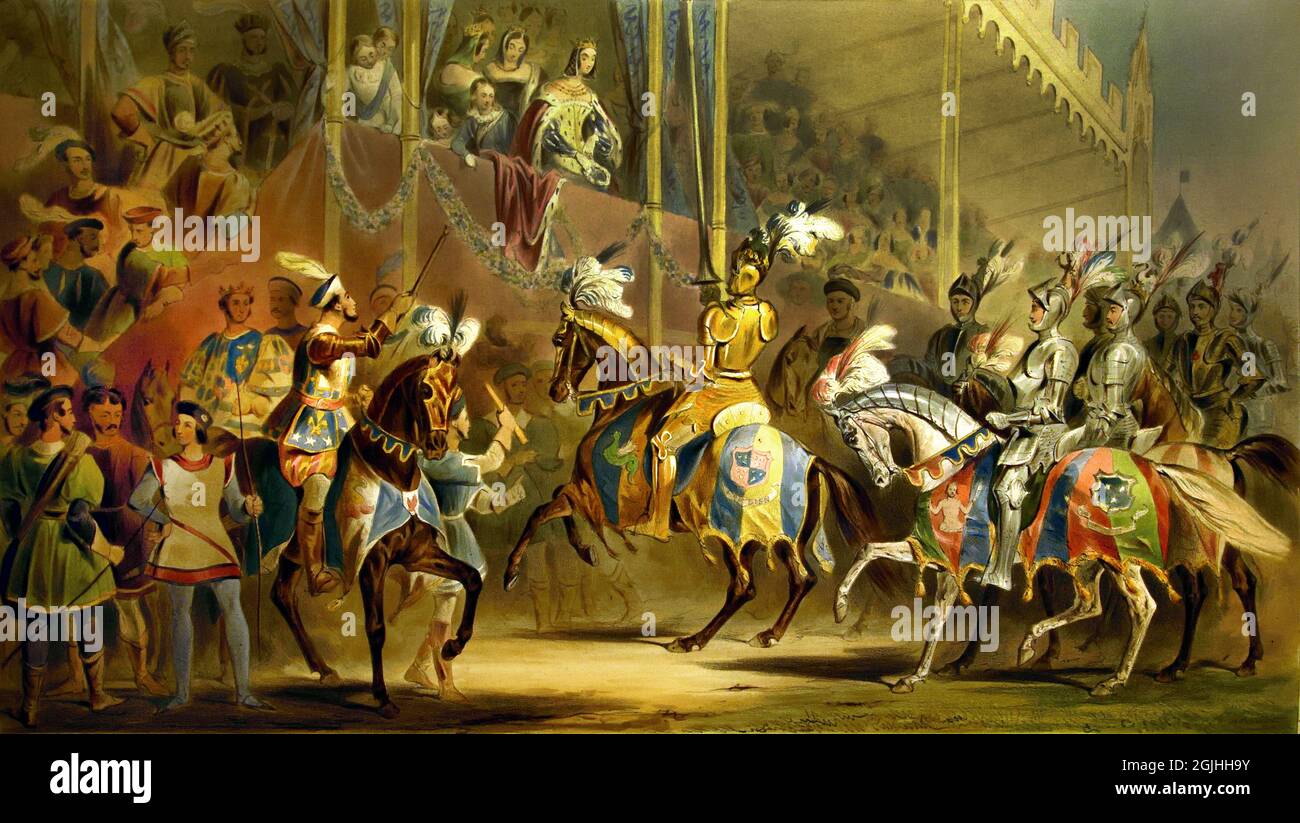 The Presentation of the Knight from the Eglinton Tournament, 1843 London by Karl Loeillet Hartwig after James Henry Nixon, England, English. Stock Photohttps://www.alamy.com/image-license-details/?v=1https://www.alamy.com/the-presentation-of-the-knight-from-the-eglinton-tournament-1843-london-by-karl-loeillet-hartwig-after-james-henry-nixon-england-english-image441709799.html
The Presentation of the Knight from the Eglinton Tournament, 1843 London by Karl Loeillet Hartwig after James Henry Nixon, England, English. Stock Photohttps://www.alamy.com/image-license-details/?v=1https://www.alamy.com/the-presentation-of-the-knight-from-the-eglinton-tournament-1843-london-by-karl-loeillet-hartwig-after-james-henry-nixon-england-english-image441709799.htmlRM2GJHH9Y–The Presentation of the Knight from the Eglinton Tournament, 1843 London by Karl Loeillet Hartwig after James Henry Nixon, England, English.
 A harvest feast at a round table in Anglo Saxon 8th Century England. Stock Photohttps://www.alamy.com/image-license-details/?v=1https://www.alamy.com/stock-image-a-harvest-feast-at-a-round-table-in-anglo-saxon-8th-century-england-165453291.html
A harvest feast at a round table in Anglo Saxon 8th Century England. Stock Photohttps://www.alamy.com/image-license-details/?v=1https://www.alamy.com/stock-image-a-harvest-feast-at-a-round-table-in-anglo-saxon-8th-century-england-165453291.htmlRMKH51A3–A harvest feast at a round table in Anglo Saxon 8th Century England.
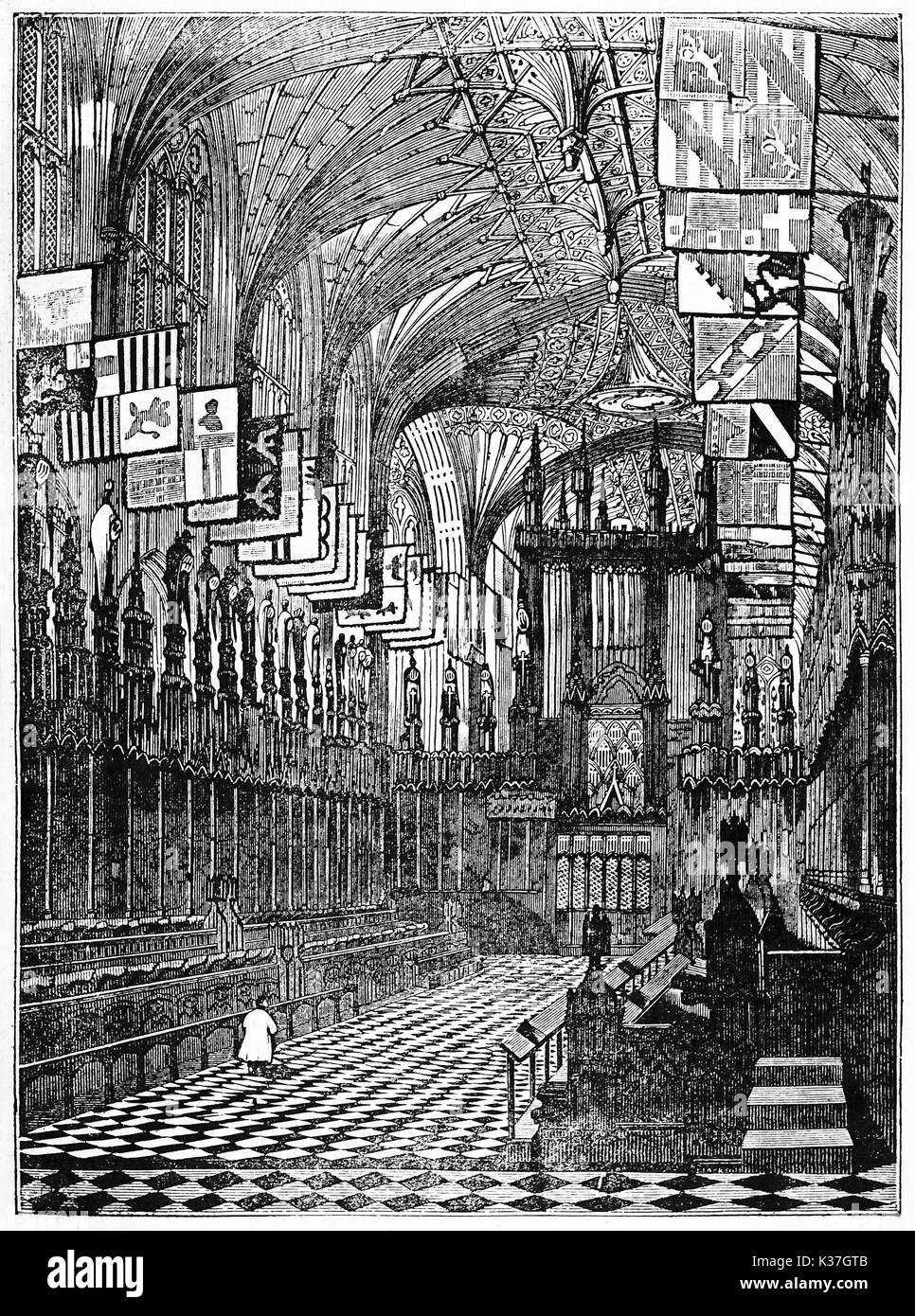 Majestic view of Windsor castle chapel interior with several nobles flags placed on the arched roof. Old Illustration by unidentified author published on magasin Pittoresque Paris 1834. Stock Photohttps://www.alamy.com/image-license-details/?v=1https://www.alamy.com/majestic-view-of-windsor-castle-chapel-interior-with-several-nobles-image156904171.html
Majestic view of Windsor castle chapel interior with several nobles flags placed on the arched roof. Old Illustration by unidentified author published on magasin Pittoresque Paris 1834. Stock Photohttps://www.alamy.com/image-license-details/?v=1https://www.alamy.com/majestic-view-of-windsor-castle-chapel-interior-with-several-nobles-image156904171.htmlRFK37GTB–Majestic view of Windsor castle chapel interior with several nobles flags placed on the arched roof. Old Illustration by unidentified author published on magasin Pittoresque Paris 1834.
 A late 19th Century illustration of Philip VI (1293-1350), called the Fortunate, the first King of France from the House of Valois, receiving King Edward III of England. Philip's reign from 1328 until his death in 1350 was dominated by the consequences of a succession dispute. When King Charles IV of France died in 1328, the nearest male relative was his nephew King Edward III, but the French nobility preferred Charles's paternal cousin Philip. At first, Edward accepted Philip's succession, but he pressed his claim to the throne of France with Philip, resulting in the Hundred Years' War. Stock Photohttps://www.alamy.com/image-license-details/?v=1https://www.alamy.com/a-late-19th-century-illustration-of-philip-vi-1293-1350-called-the-fortunate-the-first-king-of-france-from-the-house-of-valois-receiving-king-edward-iii-of-england-philips-reign-from-1328-until-his-death-in-1350-was-dominated-by-the-consequences-of-a-succession-dispute-when-king-charles-iv-of-france-died-in-1328-the-nearest-male-relative-was-his-nephew-king-edward-iii-but-the-french-nobility-preferred-charless-paternal-cousin-philip-at-first-edward-accepted-philips-succession-but-he-pressed-his-claim-to-the-throne-of-france-with-philip-resulting-in-the-hundred-years-war-image451886857.html
A late 19th Century illustration of Philip VI (1293-1350), called the Fortunate, the first King of France from the House of Valois, receiving King Edward III of England. Philip's reign from 1328 until his death in 1350 was dominated by the consequences of a succession dispute. When King Charles IV of France died in 1328, the nearest male relative was his nephew King Edward III, but the French nobility preferred Charles's paternal cousin Philip. At first, Edward accepted Philip's succession, but he pressed his claim to the throne of France with Philip, resulting in the Hundred Years' War. Stock Photohttps://www.alamy.com/image-license-details/?v=1https://www.alamy.com/a-late-19th-century-illustration-of-philip-vi-1293-1350-called-the-fortunate-the-first-king-of-france-from-the-house-of-valois-receiving-king-edward-iii-of-england-philips-reign-from-1328-until-his-death-in-1350-was-dominated-by-the-consequences-of-a-succession-dispute-when-king-charles-iv-of-france-died-in-1328-the-nearest-male-relative-was-his-nephew-king-edward-iii-but-the-french-nobility-preferred-charless-paternal-cousin-philip-at-first-edward-accepted-philips-succession-but-he-pressed-his-claim-to-the-throne-of-france-with-philip-resulting-in-the-hundred-years-war-image451886857.htmlRM2H75689–A late 19th Century illustration of Philip VI (1293-1350), called the Fortunate, the first King of France from the House of Valois, receiving King Edward III of England. Philip's reign from 1328 until his death in 1350 was dominated by the consequences of a succession dispute. When King Charles IV of France died in 1328, the nearest male relative was his nephew King Edward III, but the French nobility preferred Charles's paternal cousin Philip. At first, Edward accepted Philip's succession, but he pressed his claim to the throne of France with Philip, resulting in the Hundred Years' War.
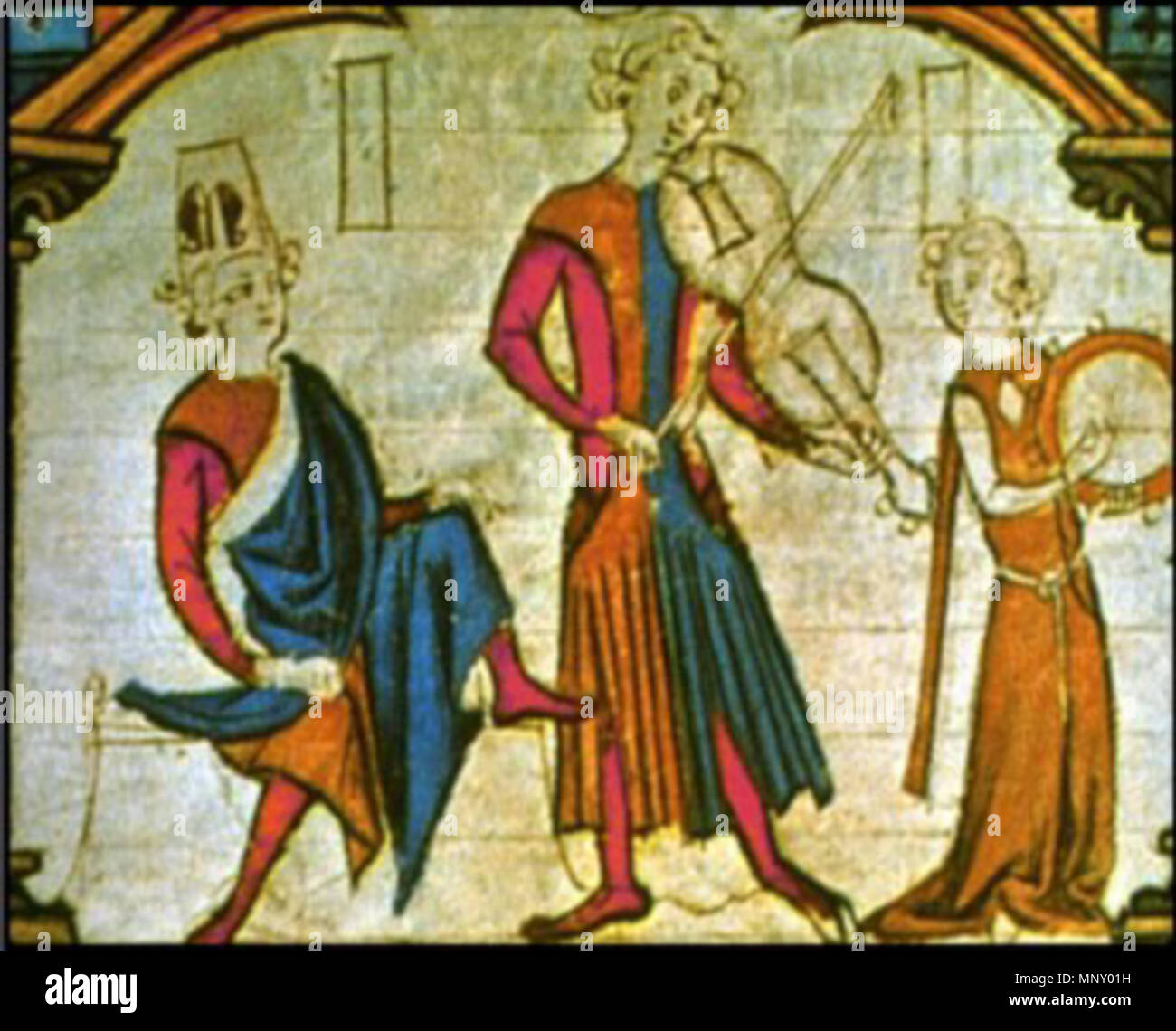 . English: Medieval musicians Ελληνικά: Τροβαδούροι Musicians Playing a Viola and a Tambourine, from the 'Chansonnier des Nobles' . Unknown 1206 Trob Stock Photohttps://www.alamy.com/image-license-details/?v=1https://www.alamy.com/english-medieval-musicians-musicians-playing-a-viola-and-a-tambourine-from-the-chansonnier-des-nobles-unknown-1206-trob-image185604205.html
. English: Medieval musicians Ελληνικά: Τροβαδούροι Musicians Playing a Viola and a Tambourine, from the 'Chansonnier des Nobles' . Unknown 1206 Trob Stock Photohttps://www.alamy.com/image-license-details/?v=1https://www.alamy.com/english-medieval-musicians-musicians-playing-a-viola-and-a-tambourine-from-the-chansonnier-des-nobles-unknown-1206-trob-image185604205.htmlRMMNY01H–. English: Medieval musicians Ελληνικά: Τροβαδούροι Musicians Playing a Viola and a Tambourine, from the 'Chansonnier des Nobles' . Unknown 1206 Trob
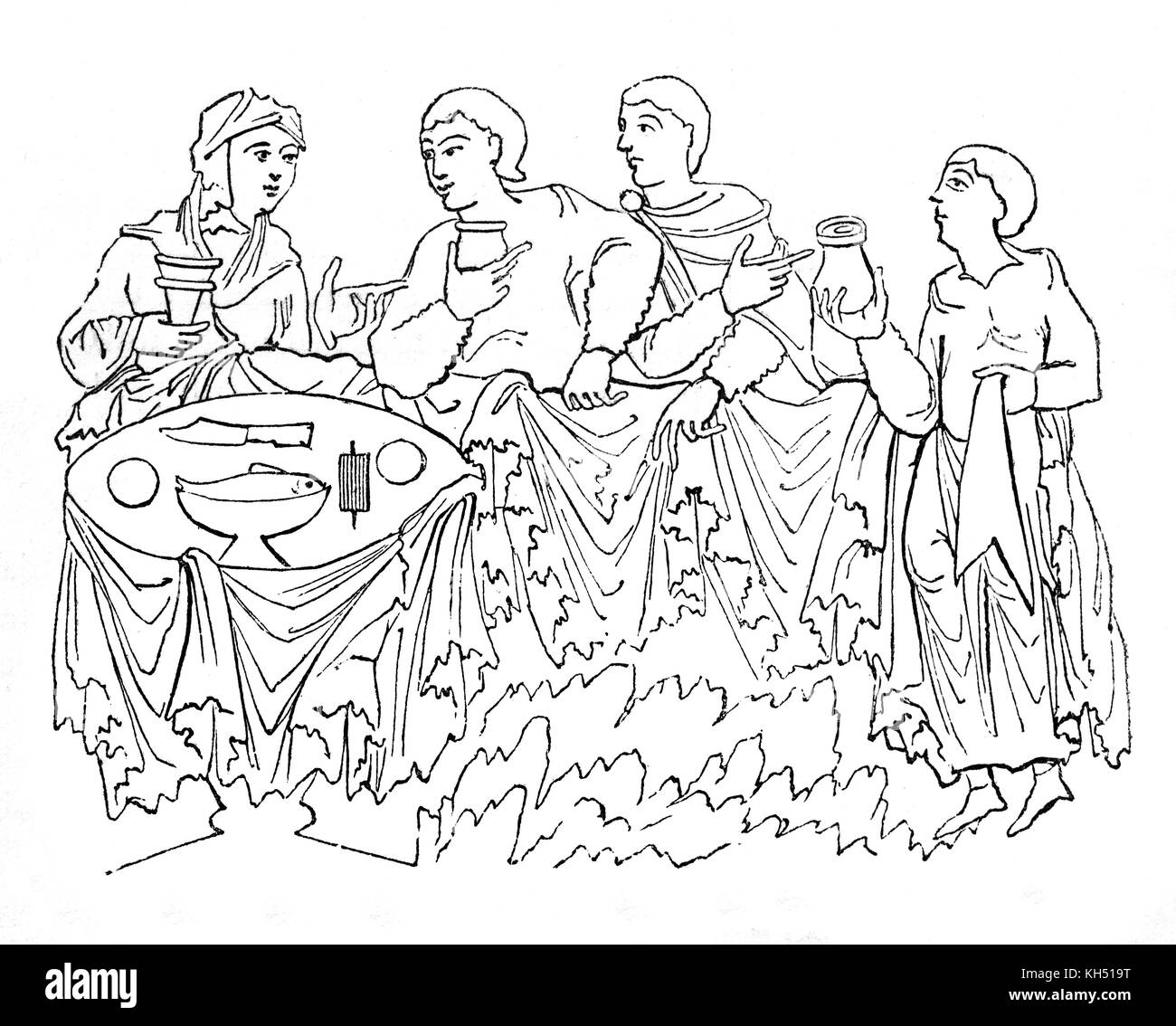 A cartoon of an Anglo Saxons drinking wine or mead and pledging (or toasting) in 8th Century England Stock Photohttps://www.alamy.com/image-license-details/?v=1https://www.alamy.com/stock-image-a-cartoon-of-an-anglo-saxons-drinking-wine-or-mead-and-pledging-or-165453284.html
A cartoon of an Anglo Saxons drinking wine or mead and pledging (or toasting) in 8th Century England Stock Photohttps://www.alamy.com/image-license-details/?v=1https://www.alamy.com/stock-image-a-cartoon-of-an-anglo-saxons-drinking-wine-or-mead-and-pledging-or-165453284.htmlRMKH519T–A cartoon of an Anglo Saxons drinking wine or mead and pledging (or toasting) in 8th Century England
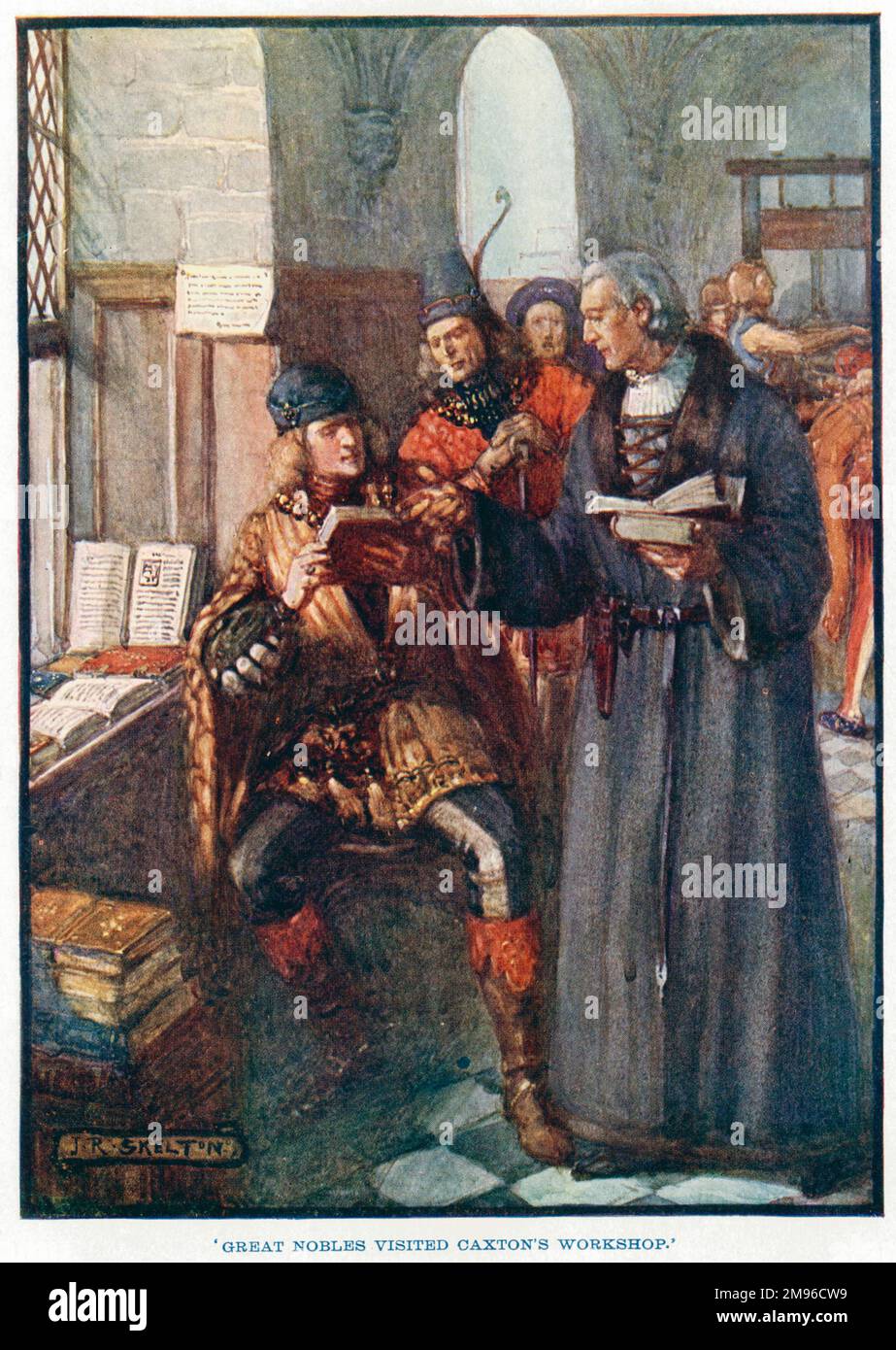 'Great nobles visited Caxton's workshop.' William Caxton (c.1422-1492), English merchant and printer, the first to introduce the printing press to England and the first English seller of printed books, is visited in his workshop by noblemen keen to look at his books. Stock Photohttps://www.alamy.com/image-license-details/?v=1https://www.alamy.com/great-nobles-visited-caxtons-workshop-william-caxton-c1422-1492-english-merchant-and-printer-the-first-to-introduce-the-printing-press-to-england-and-the-first-english-seller-of-printed-books-is-visited-in-his-workshop-by-noblemen-keen-to-look-at-his-books-image504774405.html
'Great nobles visited Caxton's workshop.' William Caxton (c.1422-1492), English merchant and printer, the first to introduce the printing press to England and the first English seller of printed books, is visited in his workshop by noblemen keen to look at his books. Stock Photohttps://www.alamy.com/image-license-details/?v=1https://www.alamy.com/great-nobles-visited-caxtons-workshop-william-caxton-c1422-1492-english-merchant-and-printer-the-first-to-introduce-the-printing-press-to-england-and-the-first-english-seller-of-printed-books-is-visited-in-his-workshop-by-noblemen-keen-to-look-at-his-books-image504774405.htmlRM2M96CW9–'Great nobles visited Caxton's workshop.' William Caxton (c.1422-1492), English merchant and printer, the first to introduce the printing press to England and the first English seller of printed books, is visited in his workshop by noblemen keen to look at his books.
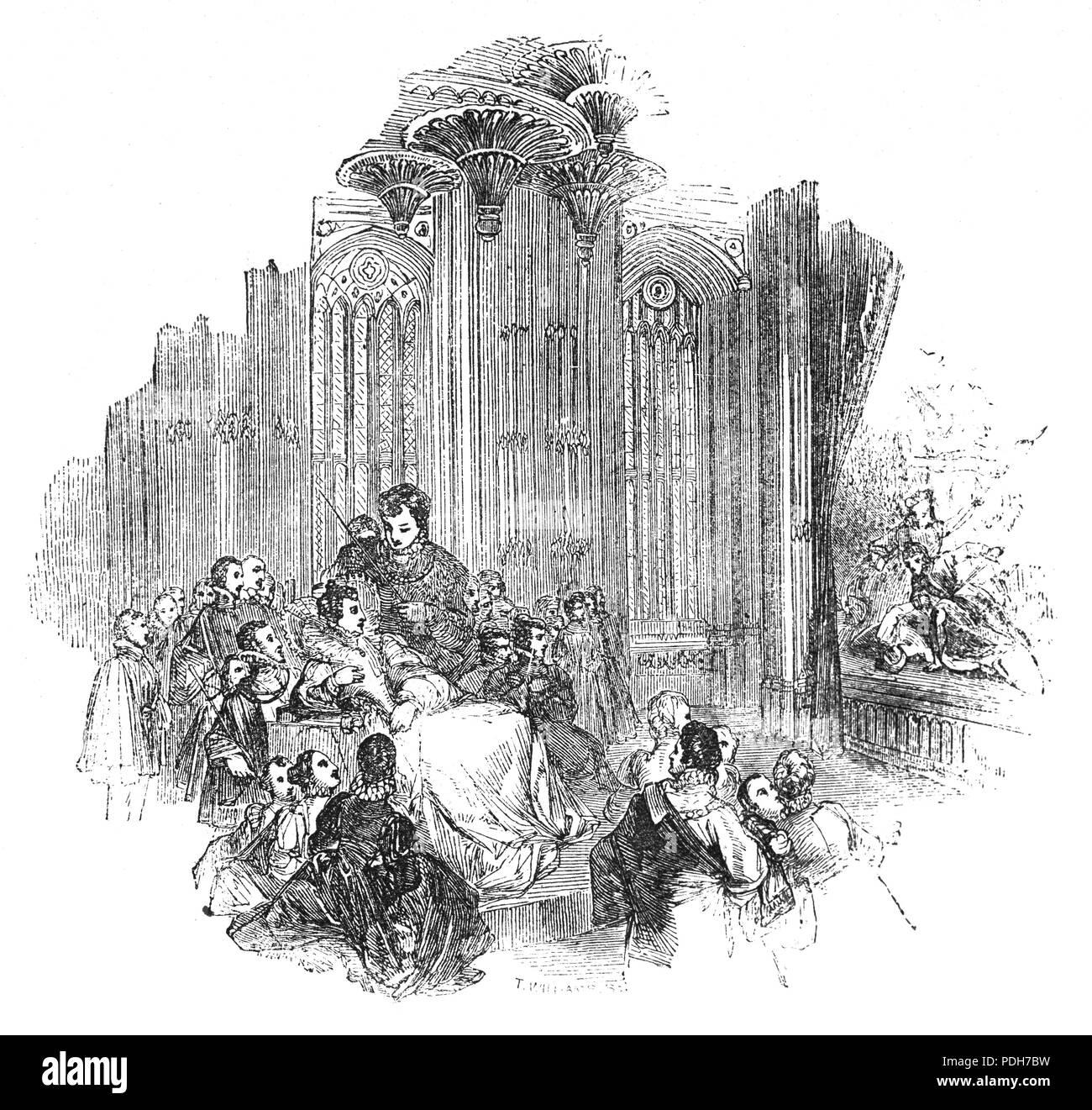 Queen Elizabeth I watching the Misfortunes of Arthur, a play by the 16th-century English dramatist Thomas Hughes. Written in 1587, it was performed at Greenwich before the Queen on February 28, 1588. The play is based on the Arthurian legend, specifically the story of Mordred's treachery and King Arthur's death as told in Geoffrey of Monmouth's Historia Regum Britanniae. Stock Photohttps://www.alamy.com/image-license-details/?v=1https://www.alamy.com/queen-elizabeth-i-watching-the-misfortunes-of-arthur-a-play-by-the-16th-century-english-dramatist-thomas-hughes-written-in-1587-it-was-performed-at-greenwich-before-the-queen-on-february-28-1588-the-play-is-based-on-the-arthurian-legend-specifically-the-story-of-mordreds-treachery-and-king-arthurs-death-as-told-in-geoffrey-of-monmouths-historia-regum-britanniae-image214893949.html
Queen Elizabeth I watching the Misfortunes of Arthur, a play by the 16th-century English dramatist Thomas Hughes. Written in 1587, it was performed at Greenwich before the Queen on February 28, 1588. The play is based on the Arthurian legend, specifically the story of Mordred's treachery and King Arthur's death as told in Geoffrey of Monmouth's Historia Regum Britanniae. Stock Photohttps://www.alamy.com/image-license-details/?v=1https://www.alamy.com/queen-elizabeth-i-watching-the-misfortunes-of-arthur-a-play-by-the-16th-century-english-dramatist-thomas-hughes-written-in-1587-it-was-performed-at-greenwich-before-the-queen-on-february-28-1588-the-play-is-based-on-the-arthurian-legend-specifically-the-story-of-mordreds-treachery-and-king-arthurs-death-as-told-in-geoffrey-of-monmouths-historia-regum-britanniae-image214893949.htmlRMPDH7BW–Queen Elizabeth I watching the Misfortunes of Arthur, a play by the 16th-century English dramatist Thomas Hughes. Written in 1587, it was performed at Greenwich before the Queen on February 28, 1588. The play is based on the Arthurian legend, specifically the story of Mordred's treachery and King Arthur's death as told in Geoffrey of Monmouth's Historia Regum Britanniae.
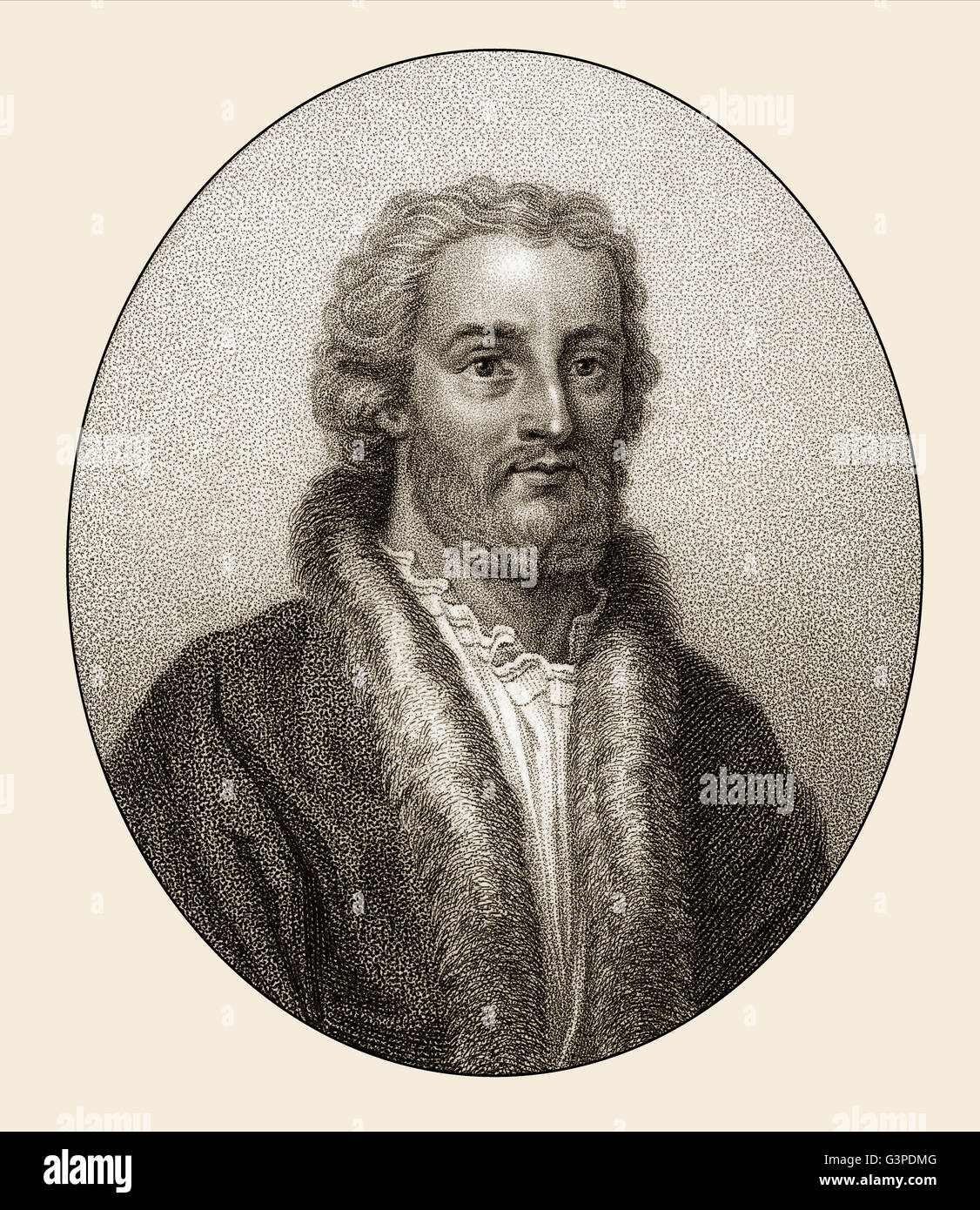 Sir John Oldcastle, died 1417, an English Lollard leader Stock Photohttps://www.alamy.com/image-license-details/?v=1https://www.alamy.com/stock-photo-sir-john-oldcastle-died-1417-an-english-lollard-leader-105599888.html
Sir John Oldcastle, died 1417, an English Lollard leader Stock Photohttps://www.alamy.com/image-license-details/?v=1https://www.alamy.com/stock-photo-sir-john-oldcastle-died-1417-an-english-lollard-leader-105599888.htmlRMG3PDMG–Sir John Oldcastle, died 1417, an English Lollard leader
 English Nobles and Soldiers 1500-1600 Stock Photohttps://www.alamy.com/image-license-details/?v=1https://www.alamy.com/stock-photo-english-nobles-and-soldiers-1500-1600-23860989.html
English Nobles and Soldiers 1500-1600 Stock Photohttps://www.alamy.com/image-license-details/?v=1https://www.alamy.com/stock-photo-english-nobles-and-soldiers-1500-1600-23860989.htmlRFBAPXX5–English Nobles and Soldiers 1500-1600
 History of England. 1300-1400. From left to right, 1: warrior, 2: crossbowman, 1376. 3: warrior, 4: ordinary people dress, 5-6: court dresses, 7: knight, 8: citizen (ordinary people), 9: lord, 10: knight, 1377. Chromolithography. 'Historia Universal', by Cesar Cantu. Volume VI, 1885. Stock Photohttps://www.alamy.com/image-license-details/?v=1https://www.alamy.com/history-of-england-1300-1400-from-left-to-right-1-warrior-2-crossbowman-1376-3-warrior-4-ordinary-people-dress-5-6-court-dresses-7-knight-8-citizen-ordinary-people-9-lord-10-knight-1377-chromolithography-historia-universal-by-cesar-cantu-volume-vi-1885-image608948804.html
History of England. 1300-1400. From left to right, 1: warrior, 2: crossbowman, 1376. 3: warrior, 4: ordinary people dress, 5-6: court dresses, 7: knight, 8: citizen (ordinary people), 9: lord, 10: knight, 1377. Chromolithography. 'Historia Universal', by Cesar Cantu. Volume VI, 1885. Stock Photohttps://www.alamy.com/image-license-details/?v=1https://www.alamy.com/history-of-england-1300-1400-from-left-to-right-1-warrior-2-crossbowman-1376-3-warrior-4-ordinary-people-dress-5-6-court-dresses-7-knight-8-citizen-ordinary-people-9-lord-10-knight-1377-chromolithography-historia-universal-by-cesar-cantu-volume-vi-1885-image608948804.htmlRM2XAM0BG–History of England. 1300-1400. From left to right, 1: warrior, 2: crossbowman, 1376. 3: warrior, 4: ordinary people dress, 5-6: court dresses, 7: knight, 8: citizen (ordinary people), 9: lord, 10: knight, 1377. Chromolithography. 'Historia Universal', by Cesar Cantu. Volume VI, 1885.
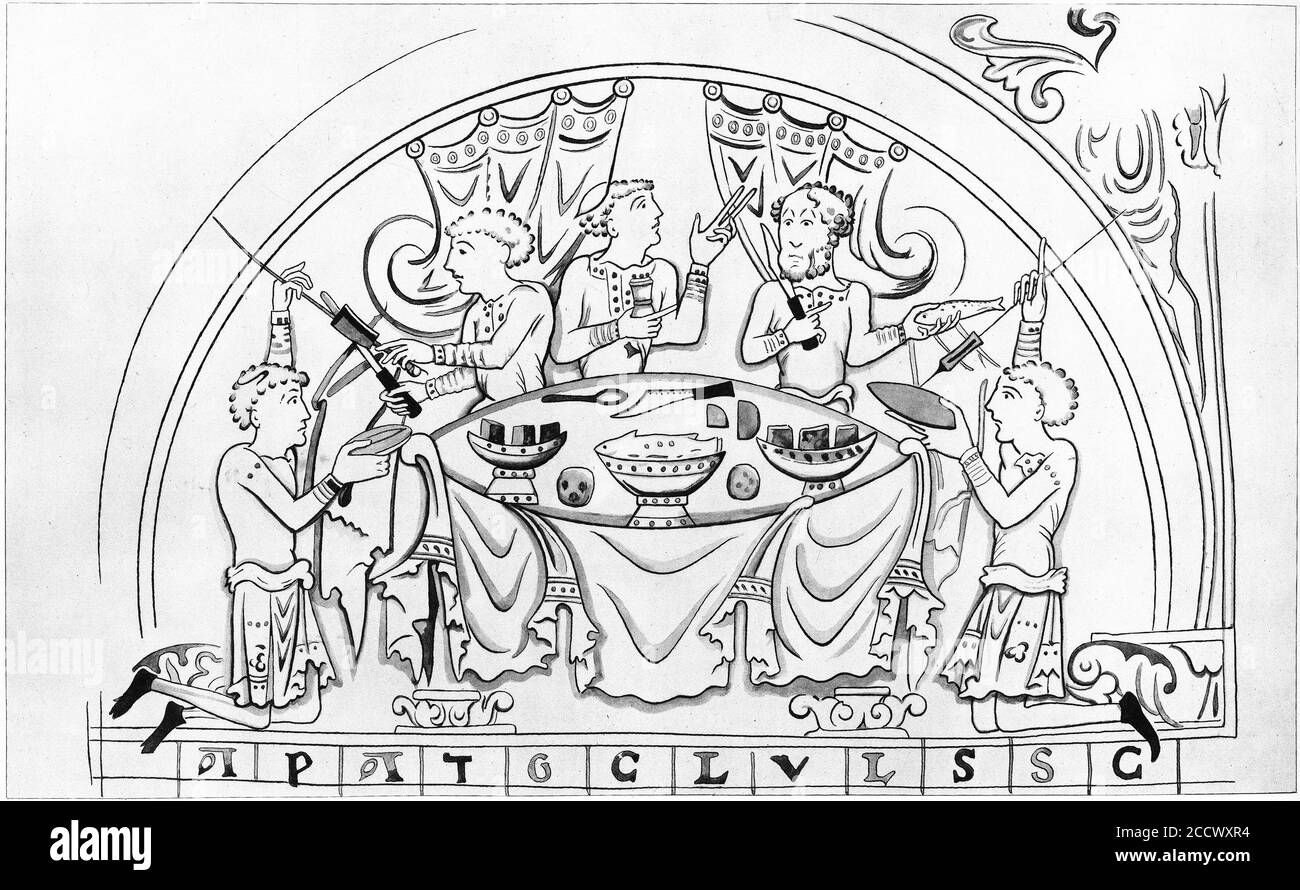 Halftone of an English banquet in the 11th century. From a set of school posters for history and social studies c 1930 Stock Photohttps://www.alamy.com/image-license-details/?v=1https://www.alamy.com/halftone-of-an-english-banquet-in-the-11th-century-from-a-set-of-school-posters-for-history-and-social-studies-c-1930-image369363432.html
Halftone of an English banquet in the 11th century. From a set of school posters for history and social studies c 1930 Stock Photohttps://www.alamy.com/image-license-details/?v=1https://www.alamy.com/halftone-of-an-english-banquet-in-the-11th-century-from-a-set-of-school-posters-for-history-and-social-studies-c-1930-image369363432.htmlRM2CCWXR4–Halftone of an English banquet in the 11th century. From a set of school posters for history and social studies c 1930
 Portrait of Jane Georgiana Seymour, Duchess of Somerset when Lady Seymour. In medieval costume as the Queen of Beauty, with crown over headdress, fur-lined cape over bejeweled robe. Steel stipple engraving by William Henry Mote after an illustration by John Hayter from Charles Heaths English Pearls, or Portraits for the Boudoir, Tilt and Bogue, London, 1843. Stock Photohttps://www.alamy.com/image-license-details/?v=1https://www.alamy.com/portrait-of-jane-georgiana-seymour-duchess-of-somerset-when-lady-seymour-in-medieval-costume-as-the-queen-of-beauty-with-crown-over-headdress-fur-lined-cape-over-bejeweled-robe-steel-stipple-engraving-by-william-henry-mote-after-an-illustration-by-john-hayter-from-charles-heaths-english-pearls-or-portraits-for-the-boudoir-tilt-and-bogue-london-1843-image359062641.html
Portrait of Jane Georgiana Seymour, Duchess of Somerset when Lady Seymour. In medieval costume as the Queen of Beauty, with crown over headdress, fur-lined cape over bejeweled robe. Steel stipple engraving by William Henry Mote after an illustration by John Hayter from Charles Heaths English Pearls, or Portraits for the Boudoir, Tilt and Bogue, London, 1843. Stock Photohttps://www.alamy.com/image-license-details/?v=1https://www.alamy.com/portrait-of-jane-georgiana-seymour-duchess-of-somerset-when-lady-seymour-in-medieval-costume-as-the-queen-of-beauty-with-crown-over-headdress-fur-lined-cape-over-bejeweled-robe-steel-stipple-engraving-by-william-henry-mote-after-an-illustration-by-john-hayter-from-charles-heaths-english-pearls-or-portraits-for-the-boudoir-tilt-and-bogue-london-1843-image359062641.htmlRM2BT4M1N–Portrait of Jane Georgiana Seymour, Duchess of Somerset when Lady Seymour. In medieval costume as the Queen of Beauty, with crown over headdress, fur-lined cape over bejeweled robe. Steel stipple engraving by William Henry Mote after an illustration by John Hayter from Charles Heaths English Pearls, or Portraits for the Boudoir, Tilt and Bogue, London, 1843.
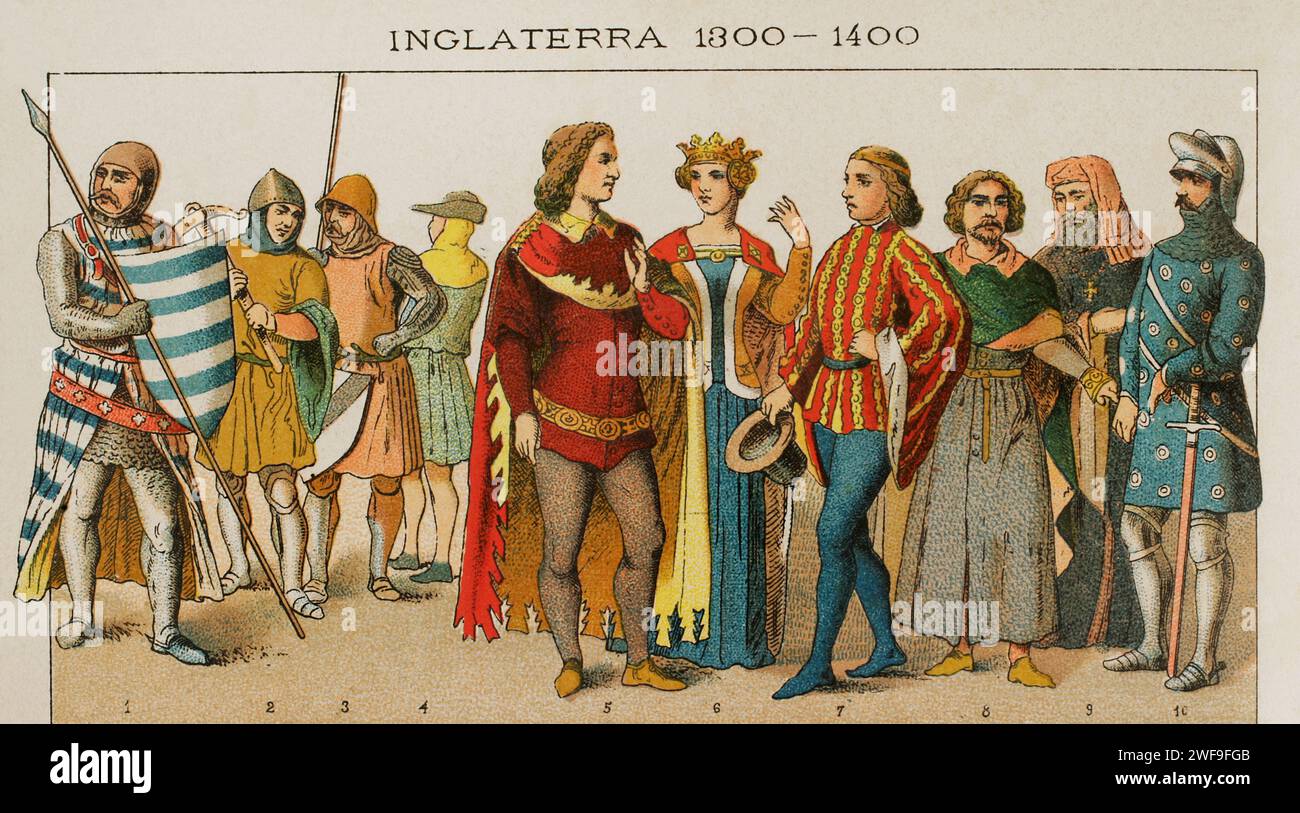 History of England. 1300-1400. From left to right, 1: warrior, 2: crossbowman, 1376. 3: warrior, 4: ordinary people dress, 5-6: court dresses, 7: knight, 8: citizen (ordinary people), 9: lord, 10: knight, 1377. Chromolithography. 'Historia Universal', by César Cantú. Volume VI, 1885. Stock Photohttps://www.alamy.com/image-license-details/?v=1https://www.alamy.com/history-of-england-1300-1400-from-left-to-right-1-warrior-2-crossbowman-1376-3-warrior-4-ordinary-people-dress-5-6-court-dresses-7-knight-8-citizen-ordinary-people-9-lord-10-knight-1377-chromolithography-historia-universal-by-csar-cant-volume-vi-1885-image594582139.html
History of England. 1300-1400. From left to right, 1: warrior, 2: crossbowman, 1376. 3: warrior, 4: ordinary people dress, 5-6: court dresses, 7: knight, 8: citizen (ordinary people), 9: lord, 10: knight, 1377. Chromolithography. 'Historia Universal', by César Cantú. Volume VI, 1885. Stock Photohttps://www.alamy.com/image-license-details/?v=1https://www.alamy.com/history-of-england-1300-1400-from-left-to-right-1-warrior-2-crossbowman-1376-3-warrior-4-ordinary-people-dress-5-6-court-dresses-7-knight-8-citizen-ordinary-people-9-lord-10-knight-1377-chromolithography-historia-universal-by-csar-cant-volume-vi-1885-image594582139.htmlRM2WF9FGB–History of England. 1300-1400. From left to right, 1: warrior, 2: crossbowman, 1376. 3: warrior, 4: ordinary people dress, 5-6: court dresses, 7: knight, 8: citizen (ordinary people), 9: lord, 10: knight, 1377. Chromolithography. 'Historia Universal', by César Cantú. Volume VI, 1885.
 Engraving of an un-named medieval king with his son Stock Photohttps://www.alamy.com/image-license-details/?v=1https://www.alamy.com/engraving-of-an-un-named-medieval-king-with-his-son-image610857613.html
Engraving of an un-named medieval king with his son Stock Photohttps://www.alamy.com/image-license-details/?v=1https://www.alamy.com/engraving-of-an-un-named-medieval-king-with-his-son-image610857613.htmlRM2XDPY39–Engraving of an un-named medieval king with his son
 Robert's father advising with his nobles Stock Photohttps://www.alamy.com/image-license-details/?v=1https://www.alamy.com/stock-photo-roberts-father-advising-with-his-nobles-36874628.html
Robert's father advising with his nobles Stock Photohttps://www.alamy.com/image-license-details/?v=1https://www.alamy.com/stock-photo-roberts-father-advising-with-his-nobles-36874628.htmlRMC3YNY0–Robert's father advising with his nobles
 Costume of Dutch and English nobles, 1586. Army commanders Justinus van Nassau 154 and Philip of Hohenlohe-Neuenstein in suit of armour 155, and English diplomats Sir Henry Norris 156 and Sir Andrew Bellestown 157. Handcoloured lithograph by Pieter Willem Marius Trap after an illustration by Gerardus Johannes Bos in Maskerade, Leiden 1870, (Masquerade by Leiden Students 1870), a historical re-enactment of the visit by Robert Lord Dudley, Baron von Denbigh, Earl of Leicester, and others to Leiden University in 1586, published by Jac. Hazenberg Cornsz, Leiden, 1870. Stock Photohttps://www.alamy.com/image-license-details/?v=1https://www.alamy.com/costume-of-dutch-and-english-nobles-1586-army-commanders-justinus-van-nassau-154-and-philip-of-hohenlohe-neuenstein-in-suit-of-armour-155-and-english-diplomats-sir-henry-norris-156-and-sir-andrew-bellestown-157-handcoloured-lithograph-by-pieter-willem-marius-trap-after-an-illustration-by-gerardus-johannes-bos-in-maskerade-leiden-1870-masquerade-by-leiden-students-1870-a-historical-re-enactment-of-the-visit-by-robert-lord-dudley-baron-von-denbigh-earl-of-leicester-and-others-to-leiden-university-in-1586-published-by-jac-hazenberg-cornsz-leiden-1870-image595202214.html
Costume of Dutch and English nobles, 1586. Army commanders Justinus van Nassau 154 and Philip of Hohenlohe-Neuenstein in suit of armour 155, and English diplomats Sir Henry Norris 156 and Sir Andrew Bellestown 157. Handcoloured lithograph by Pieter Willem Marius Trap after an illustration by Gerardus Johannes Bos in Maskerade, Leiden 1870, (Masquerade by Leiden Students 1870), a historical re-enactment of the visit by Robert Lord Dudley, Baron von Denbigh, Earl of Leicester, and others to Leiden University in 1586, published by Jac. Hazenberg Cornsz, Leiden, 1870. Stock Photohttps://www.alamy.com/image-license-details/?v=1https://www.alamy.com/costume-of-dutch-and-english-nobles-1586-army-commanders-justinus-van-nassau-154-and-philip-of-hohenlohe-neuenstein-in-suit-of-armour-155-and-english-diplomats-sir-henry-norris-156-and-sir-andrew-bellestown-157-handcoloured-lithograph-by-pieter-willem-marius-trap-after-an-illustration-by-gerardus-johannes-bos-in-maskerade-leiden-1870-masquerade-by-leiden-students-1870-a-historical-re-enactment-of-the-visit-by-robert-lord-dudley-baron-von-denbigh-earl-of-leicester-and-others-to-leiden-university-in-1586-published-by-jac-hazenberg-cornsz-leiden-1870-image595202214.htmlRM2WG9PDX–Costume of Dutch and English nobles, 1586. Army commanders Justinus van Nassau 154 and Philip of Hohenlohe-Neuenstein in suit of armour 155, and English diplomats Sir Henry Norris 156 and Sir Andrew Bellestown 157. Handcoloured lithograph by Pieter Willem Marius Trap after an illustration by Gerardus Johannes Bos in Maskerade, Leiden 1870, (Masquerade by Leiden Students 1870), a historical re-enactment of the visit by Robert Lord Dudley, Baron von Denbigh, Earl of Leicester, and others to Leiden University in 1586, published by Jac. Hazenberg Cornsz, Leiden, 1870.
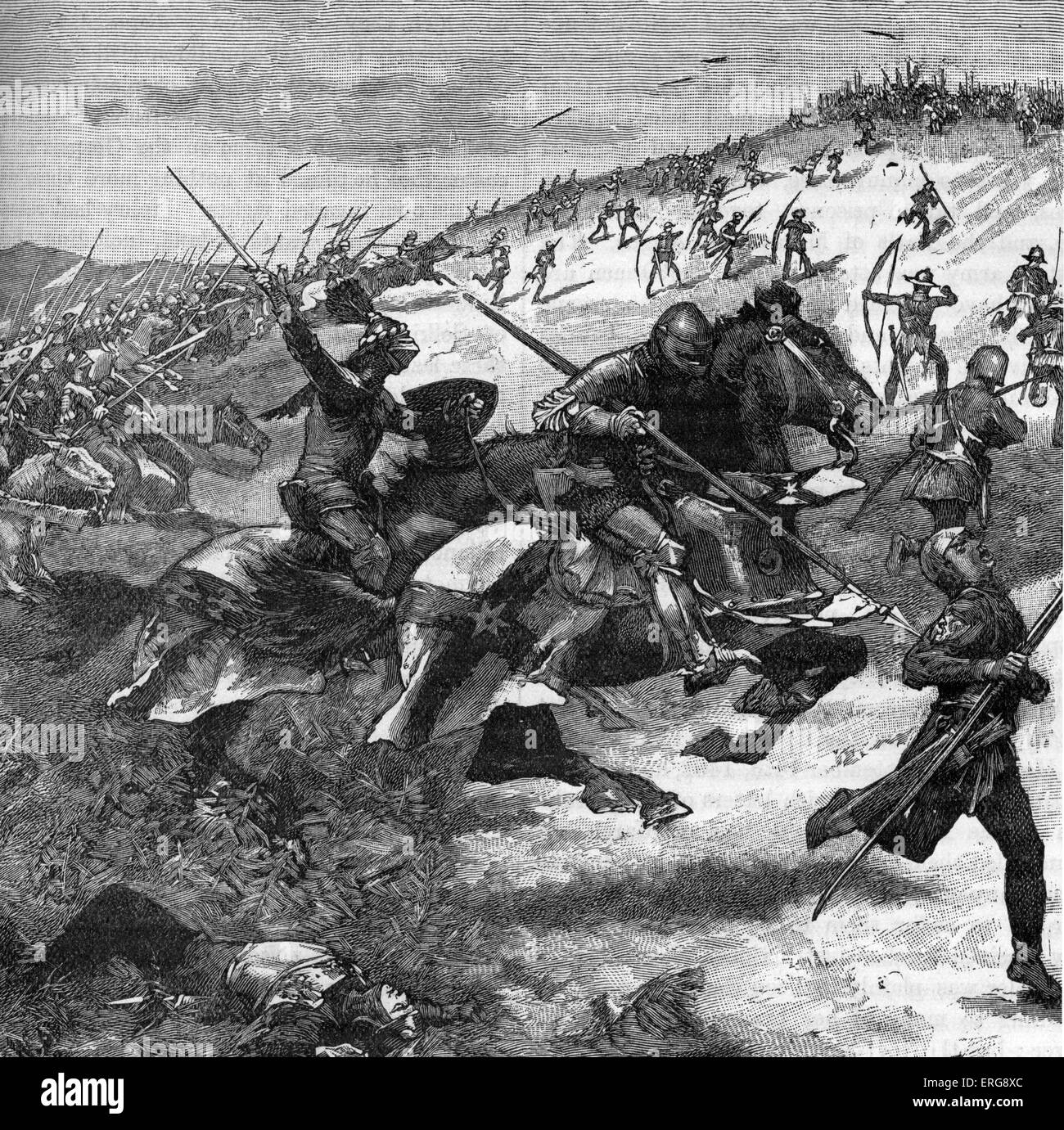 Battle of Humbleton Hill - Scottish charge. 14 September 1402, Nortumberland. Scottish army, led by Archibald, Earl of Douglas, had invaded England in part to avenge the killing and capture of Scottish nobles in the Battle of Nesbit Moor. They were intecepted by English forces led by Henry Percy, 1st Earl of Northumberland. English victory. Stock Photohttps://www.alamy.com/image-license-details/?v=1https://www.alamy.com/stock-photo-battle-of-humbleton-hill-scottish-charge-14-september-1402-nortumberland-83336804.html
Battle of Humbleton Hill - Scottish charge. 14 September 1402, Nortumberland. Scottish army, led by Archibald, Earl of Douglas, had invaded England in part to avenge the killing and capture of Scottish nobles in the Battle of Nesbit Moor. They were intecepted by English forces led by Henry Percy, 1st Earl of Northumberland. English victory. Stock Photohttps://www.alamy.com/image-license-details/?v=1https://www.alamy.com/stock-photo-battle-of-humbleton-hill-scottish-charge-14-september-1402-nortumberland-83336804.htmlRMERG8XC–Battle of Humbleton Hill - Scottish charge. 14 September 1402, Nortumberland. Scottish army, led by Archibald, Earl of Douglas, had invaded England in part to avenge the killing and capture of Scottish nobles in the Battle of Nesbit Moor. They were intecepted by English forces led by Henry Percy, 1st Earl of Northumberland. English victory.
 John, Duke of Berry, served as a mediator between the House of Orléans (Armagnac faction) and the House of Burgundy (Burgundian faction) and organised a reconciliation in the Church of the Augustines during the Armagnac–Burgundian Civil War, a conflict between the two cadet branches of the French royal family from 1407 to 1435. It began during a lull in the Hundred Years' War against the English and overlapped with the Western Schism of the papacy. Stock Photohttps://www.alamy.com/image-license-details/?v=1https://www.alamy.com/john-duke-of-berry-served-as-a-mediator-between-the-house-of-orlans-armagnac-faction-and-the-house-of-burgundy-burgundian-faction-and-organised-a-reconciliation-in-the-church-of-the-augustines-during-the-armagnacburgundian-civil-war-a-conflict-between-the-two-cadet-branches-of-the-french-royal-family-from-1407-to-1435-it-began-during-a-lull-in-the-hundred-years-war-against-the-english-and-overlapped-with-the-western-schism-of-the-papacy-image207767442.html
John, Duke of Berry, served as a mediator between the House of Orléans (Armagnac faction) and the House of Burgundy (Burgundian faction) and organised a reconciliation in the Church of the Augustines during the Armagnac–Burgundian Civil War, a conflict between the two cadet branches of the French royal family from 1407 to 1435. It began during a lull in the Hundred Years' War against the English and overlapped with the Western Schism of the papacy. Stock Photohttps://www.alamy.com/image-license-details/?v=1https://www.alamy.com/john-duke-of-berry-served-as-a-mediator-between-the-house-of-orlans-armagnac-faction-and-the-house-of-burgundy-burgundian-faction-and-organised-a-reconciliation-in-the-church-of-the-augustines-during-the-armagnacburgundian-civil-war-a-conflict-between-the-two-cadet-branches-of-the-french-royal-family-from-1407-to-1435-it-began-during-a-lull-in-the-hundred-years-war-against-the-english-and-overlapped-with-the-western-schism-of-the-papacy-image207767442.htmlRMP20HDP–John, Duke of Berry, served as a mediator between the House of Orléans (Armagnac faction) and the House of Burgundy (Burgundian faction) and organised a reconciliation in the Church of the Augustines during the Armagnac–Burgundian Civil War, a conflict between the two cadet branches of the French royal family from 1407 to 1435. It began during a lull in the Hundred Years' War against the English and overlapped with the Western Schism of the papacy.
 Battle of Humbleton Hill - Scottish charge. 14 September 1402, Nortumberland. Scottish army, led by Archibald, Earl of Douglas, had invaded England in part to avenge the killing and capture of Scottish nobles in the Battle of Nesbit Moor. They were intecepted by English forces led by Henry Percy, 1st Earl of Northumberland. English victory. Stock Photohttps://www.alamy.com/image-license-details/?v=1https://www.alamy.com/stock-photo-battle-of-humbleton-hill-scottish-charge-14-september-1402-nortumberland-83338134.html
Battle of Humbleton Hill - Scottish charge. 14 September 1402, Nortumberland. Scottish army, led by Archibald, Earl of Douglas, had invaded England in part to avenge the killing and capture of Scottish nobles in the Battle of Nesbit Moor. They were intecepted by English forces led by Henry Percy, 1st Earl of Northumberland. English victory. Stock Photohttps://www.alamy.com/image-license-details/?v=1https://www.alamy.com/stock-photo-battle-of-humbleton-hill-scottish-charge-14-september-1402-nortumberland-83338134.htmlRMERGAHX–Battle of Humbleton Hill - Scottish charge. 14 September 1402, Nortumberland. Scottish army, led by Archibald, Earl of Douglas, had invaded England in part to avenge the killing and capture of Scottish nobles in the Battle of Nesbit Moor. They were intecepted by English forces led by Henry Percy, 1st Earl of Northumberland. English victory.
 The Anglo-Saxon Invasion of England took place from the mid-fifth to early seventh centuries, following the end of Roman power in Britain around the year 410. The 'monthly' life of the times is illustrated in a series of pictures. The Anglo-Saxon Calendar 9/12: September aka Gerst-monat or Barley Month: the month for the barley harvest and barley beer making, an activity that can be seen in the tree smaller illustrations. The main picture shows nobles hunting the wild boar fattened on acorns, for which they used boar spears and specially bred hunting dogs. Stock Photohttps://www.alamy.com/image-license-details/?v=1https://www.alamy.com/stock-image-the-anglo-saxon-invasion-of-england-took-place-from-the-mid-fifth-165453226.html
The Anglo-Saxon Invasion of England took place from the mid-fifth to early seventh centuries, following the end of Roman power in Britain around the year 410. The 'monthly' life of the times is illustrated in a series of pictures. The Anglo-Saxon Calendar 9/12: September aka Gerst-monat or Barley Month: the month for the barley harvest and barley beer making, an activity that can be seen in the tree smaller illustrations. The main picture shows nobles hunting the wild boar fattened on acorns, for which they used boar spears and specially bred hunting dogs. Stock Photohttps://www.alamy.com/image-license-details/?v=1https://www.alamy.com/stock-image-the-anglo-saxon-invasion-of-england-took-place-from-the-mid-fifth-165453226.htmlRMKH517P–The Anglo-Saxon Invasion of England took place from the mid-fifth to early seventh centuries, following the end of Roman power in Britain around the year 410. The 'monthly' life of the times is illustrated in a series of pictures. The Anglo-Saxon Calendar 9/12: September aka Gerst-monat or Barley Month: the month for the barley harvest and barley beer making, an activity that can be seen in the tree smaller illustrations. The main picture shows nobles hunting the wild boar fattened on acorns, for which they used boar spears and specially bred hunting dogs.
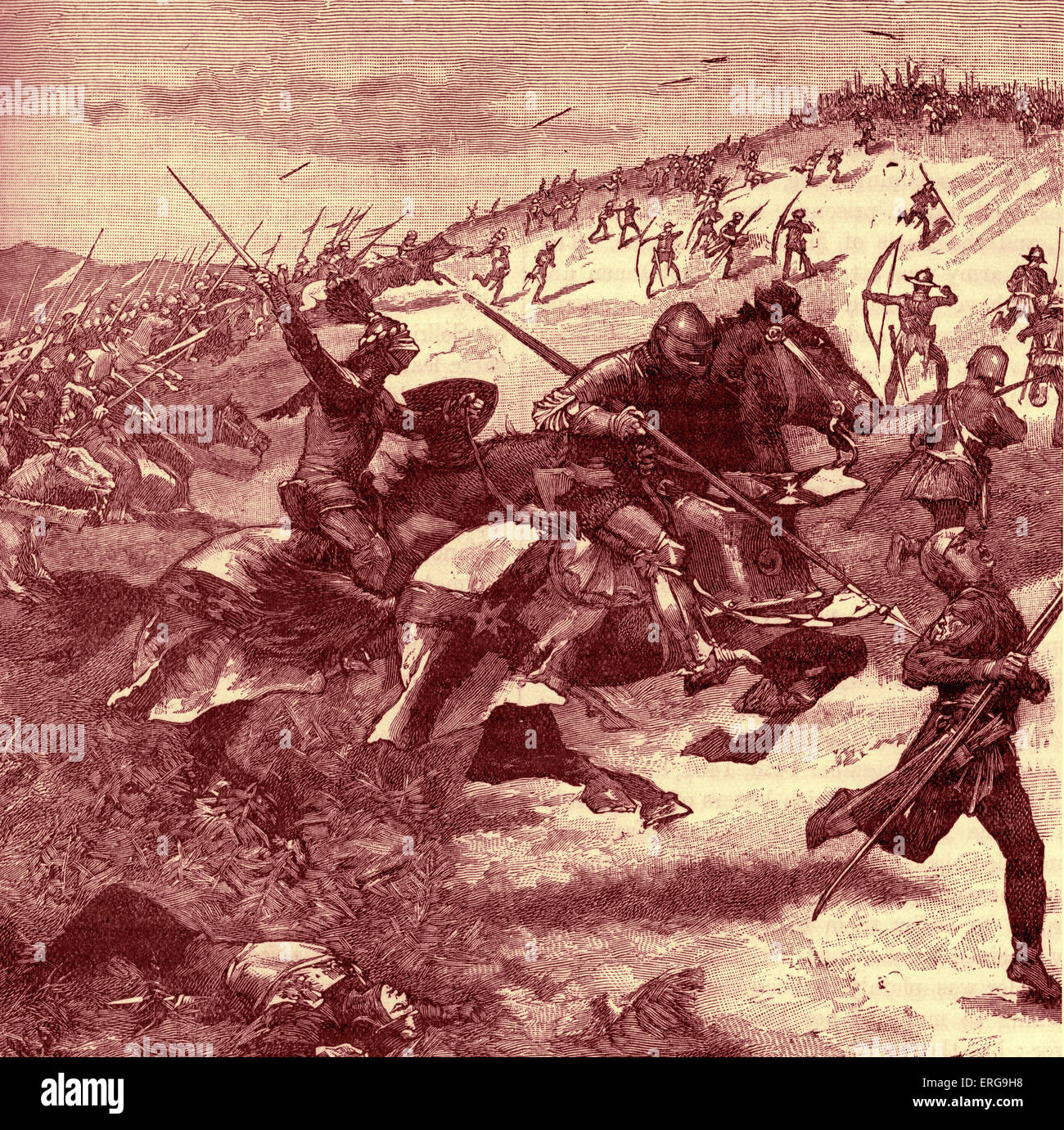 Battle of Humbleton Hill - Scottish charge. 14 September 1402, Nortumberland. Scottish army, led by Archibald, Earl of Douglas, had invaded England in part to avenge the killing and capture of Scottish nobles in the Battle of Nesbit Moor. They were intecepted by English forces led by Henry Percy, 1st Earl of Northumberland. English victory. Stock Photohttps://www.alamy.com/image-license-details/?v=1https://www.alamy.com/stock-photo-battle-of-humbleton-hill-scottish-charge-14-september-1402-nortumberland-83337332.html
Battle of Humbleton Hill - Scottish charge. 14 September 1402, Nortumberland. Scottish army, led by Archibald, Earl of Douglas, had invaded England in part to avenge the killing and capture of Scottish nobles in the Battle of Nesbit Moor. They were intecepted by English forces led by Henry Percy, 1st Earl of Northumberland. English victory. Stock Photohttps://www.alamy.com/image-license-details/?v=1https://www.alamy.com/stock-photo-battle-of-humbleton-hill-scottish-charge-14-september-1402-nortumberland-83337332.htmlRMERG9H8–Battle of Humbleton Hill - Scottish charge. 14 September 1402, Nortumberland. Scottish army, led by Archibald, Earl of Douglas, had invaded England in part to avenge the killing and capture of Scottish nobles in the Battle of Nesbit Moor. They were intecepted by English forces led by Henry Percy, 1st Earl of Northumberland. English victory.
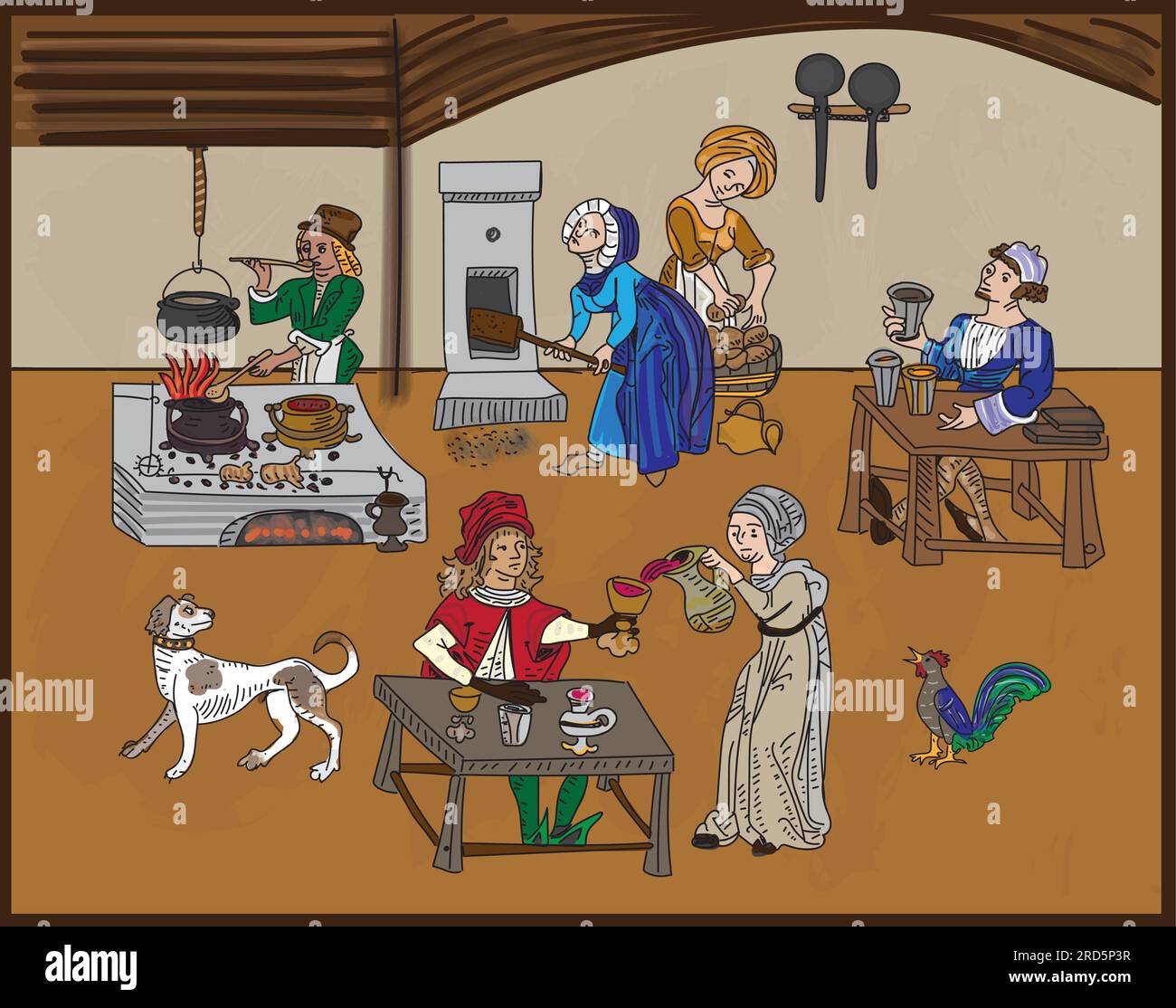 Medieval style tavern scene, serving women, nobles eating and drinking, cooking over fire and coals, woodcut style Stock Vectorhttps://www.alamy.com/image-license-details/?v=1https://www.alamy.com/medieval-style-tavern-scene-serving-women-nobles-eating-and-drinking-cooking-over-fire-and-coals-woodcut-style-image558849419.html
Medieval style tavern scene, serving women, nobles eating and drinking, cooking over fire and coals, woodcut style Stock Vectorhttps://www.alamy.com/image-license-details/?v=1https://www.alamy.com/medieval-style-tavern-scene-serving-women-nobles-eating-and-drinking-cooking-over-fire-and-coals-woodcut-style-image558849419.htmlRF2RD5P3R–Medieval style tavern scene, serving women, nobles eating and drinking, cooking over fire and coals, woodcut style
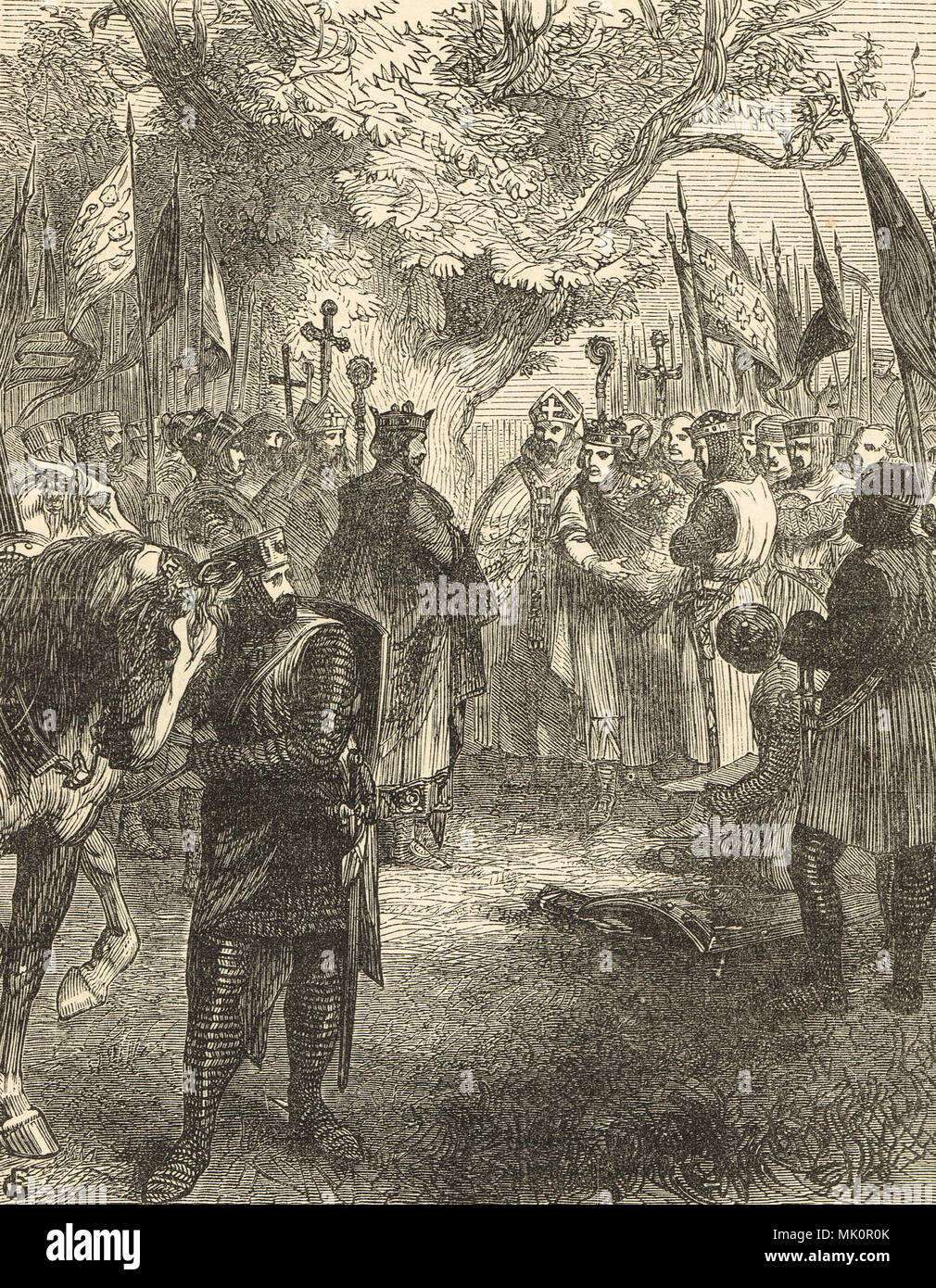 King Henry II of England meeting with King Louis VII of France, on the plain near Gisors, Normandy, France in 1173. Peace talks during the Great Revolt, an uprising by the eldest sons of Henry I, supported by Louis VII. Stock Photohttps://www.alamy.com/image-license-details/?v=1https://www.alamy.com/king-henry-ii-of-england-meeting-with-king-louis-vii-of-france-on-the-plain-near-gisors-normandy-france-in-1173-peace-talks-during-the-great-revolt-an-uprising-by-the-eldest-sons-of-henry-i-supported-by-louis-vii-image183800195.html
King Henry II of England meeting with King Louis VII of France, on the plain near Gisors, Normandy, France in 1173. Peace talks during the Great Revolt, an uprising by the eldest sons of Henry I, supported by Louis VII. Stock Photohttps://www.alamy.com/image-license-details/?v=1https://www.alamy.com/king-henry-ii-of-england-meeting-with-king-louis-vii-of-france-on-the-plain-near-gisors-normandy-france-in-1173-peace-talks-during-the-great-revolt-an-uprising-by-the-eldest-sons-of-henry-i-supported-by-louis-vii-image183800195.htmlRMMK0R0K–King Henry II of England meeting with King Louis VII of France, on the plain near Gisors, Normandy, France in 1173. Peace talks during the Great Revolt, an uprising by the eldest sons of Henry I, supported by Louis VII.
 An old image of historic helmets worn by various classes of society in old Britain - King, Noble, Knight, Esquire Stock Photohttps://www.alamy.com/image-license-details/?v=1https://www.alamy.com/an-old-image-of-historic-helmets-worn-by-various-classes-of-society-in-old-britain-king-noble-knight-esquire-image616677741.html
An old image of historic helmets worn by various classes of society in old Britain - King, Noble, Knight, Esquire Stock Photohttps://www.alamy.com/image-license-details/?v=1https://www.alamy.com/an-old-image-of-historic-helmets-worn-by-various-classes-of-society-in-old-britain-king-noble-knight-esquire-image616677741.htmlRM2XR82N1–An old image of historic helmets worn by various classes of society in old Britain - King, Noble, Knight, Esquire
 An old engraving of the ‘White Ship’ (‘Blanche Nef’), carrying William Adelin, heir to the English throne, running aground and sinking in the English Channel on 25 November 1120. Henry I’s son and heir, William drowned in the shipwreck. His premature demise plunged the country into an anarchic succession crisis. Henry I, William Adelin and many other nobles of the royal court, were due to sail back to England from Normandy. Henry travelled separately to his son, who chose to sail upon a new vessel named the Blanche Nef. Although some passengers clung to the wreckage, only one survived. Stock Photohttps://www.alamy.com/image-license-details/?v=1https://www.alamy.com/an-old-engraving-of-the-white-ship-blanche-nef-carrying-william-adelin-heir-to-the-english-throne-running-aground-and-sinking-in-the-english-channel-on-25-november-1120-henry-is-son-and-heir-william-drowned-in-the-shipwreck-his-premature-demise-plunged-the-country-into-an-anarchic-succession-crisis-henry-i-william-adelin-and-many-other-nobles-of-the-royal-court-were-due-to-sail-back-to-england-from-normandy-henry-travelled-separately-to-his-son-who-chose-to-sail-upon-a-new-vessel-named-the-blanche-nef-although-some-passengers-clung-to-the-wreckage-only-one-survived-image627845325.html
An old engraving of the ‘White Ship’ (‘Blanche Nef’), carrying William Adelin, heir to the English throne, running aground and sinking in the English Channel on 25 November 1120. Henry I’s son and heir, William drowned in the shipwreck. His premature demise plunged the country into an anarchic succession crisis. Henry I, William Adelin and many other nobles of the royal court, were due to sail back to England from Normandy. Henry travelled separately to his son, who chose to sail upon a new vessel named the Blanche Nef. Although some passengers clung to the wreckage, only one survived. Stock Photohttps://www.alamy.com/image-license-details/?v=1https://www.alamy.com/an-old-engraving-of-the-white-ship-blanche-nef-carrying-william-adelin-heir-to-the-english-throne-running-aground-and-sinking-in-the-english-channel-on-25-november-1120-henry-is-son-and-heir-william-drowned-in-the-shipwreck-his-premature-demise-plunged-the-country-into-an-anarchic-succession-crisis-henry-i-william-adelin-and-many-other-nobles-of-the-royal-court-were-due-to-sail-back-to-england-from-normandy-henry-travelled-separately-to-his-son-who-chose-to-sail-upon-a-new-vessel-named-the-blanche-nef-although-some-passengers-clung-to-the-wreckage-only-one-survived-image627845325.htmlRM2YDCR39–An old engraving of the ‘White Ship’ (‘Blanche Nef’), carrying William Adelin, heir to the English throne, running aground and sinking in the English Channel on 25 November 1120. Henry I’s son and heir, William drowned in the shipwreck. His premature demise plunged the country into an anarchic succession crisis. Henry I, William Adelin and many other nobles of the royal court, were due to sail back to England from Normandy. Henry travelled separately to his son, who chose to sail upon a new vessel named the Blanche Nef. Although some passengers clung to the wreckage, only one survived.
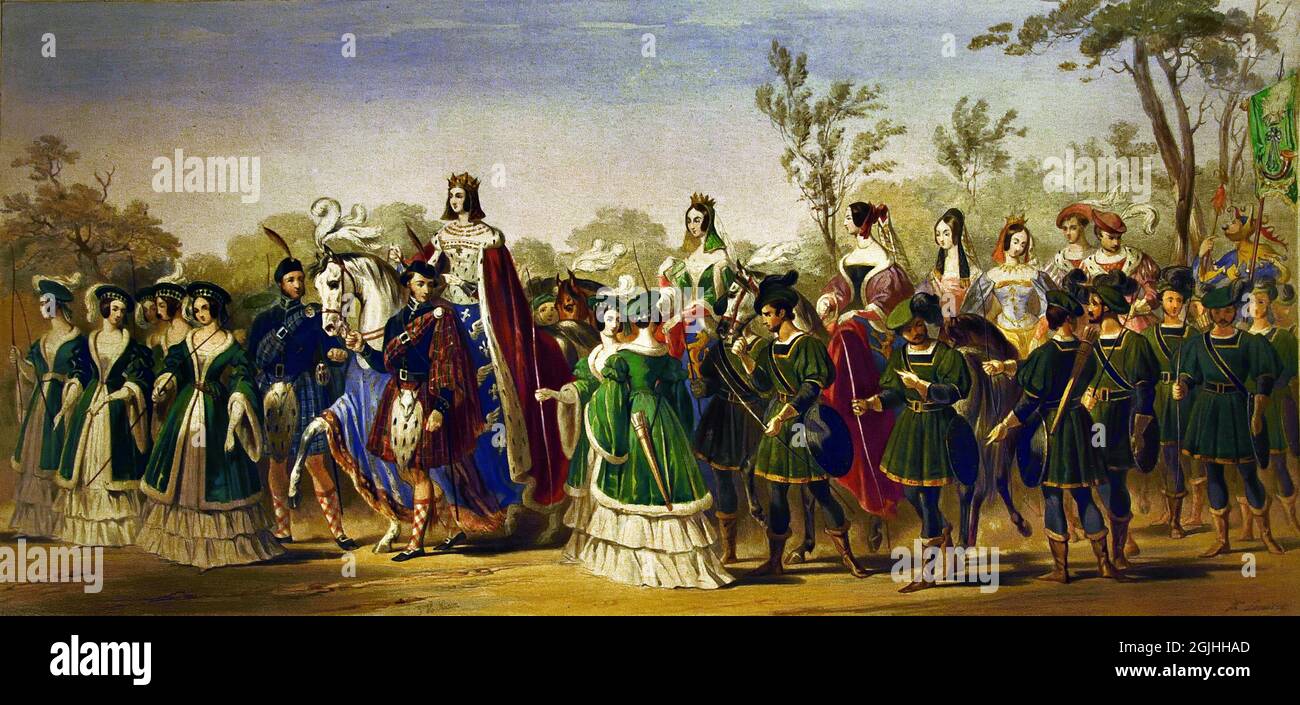 Jane Georgiana, Lady Seymour as Queen of Beauty from the Eglinton Tournament, 1843 London by Karl Loeillet Hartwig after James Henry Nixon, England, English. Stock Photohttps://www.alamy.com/image-license-details/?v=1https://www.alamy.com/jane-georgiana-lady-seymour-as-queen-of-beauty-from-the-eglinton-tournament-1843-london-by-karl-loeillet-hartwig-after-james-henry-nixon-england-english-image441709813.html
Jane Georgiana, Lady Seymour as Queen of Beauty from the Eglinton Tournament, 1843 London by Karl Loeillet Hartwig after James Henry Nixon, England, English. Stock Photohttps://www.alamy.com/image-license-details/?v=1https://www.alamy.com/jane-georgiana-lady-seymour-as-queen-of-beauty-from-the-eglinton-tournament-1843-london-by-karl-loeillet-hartwig-after-james-henry-nixon-england-english-image441709813.htmlRM2GJHHAD–Jane Georgiana, Lady Seymour as Queen of Beauty from the Eglinton Tournament, 1843 London by Karl Loeillet Hartwig after James Henry Nixon, England, English.
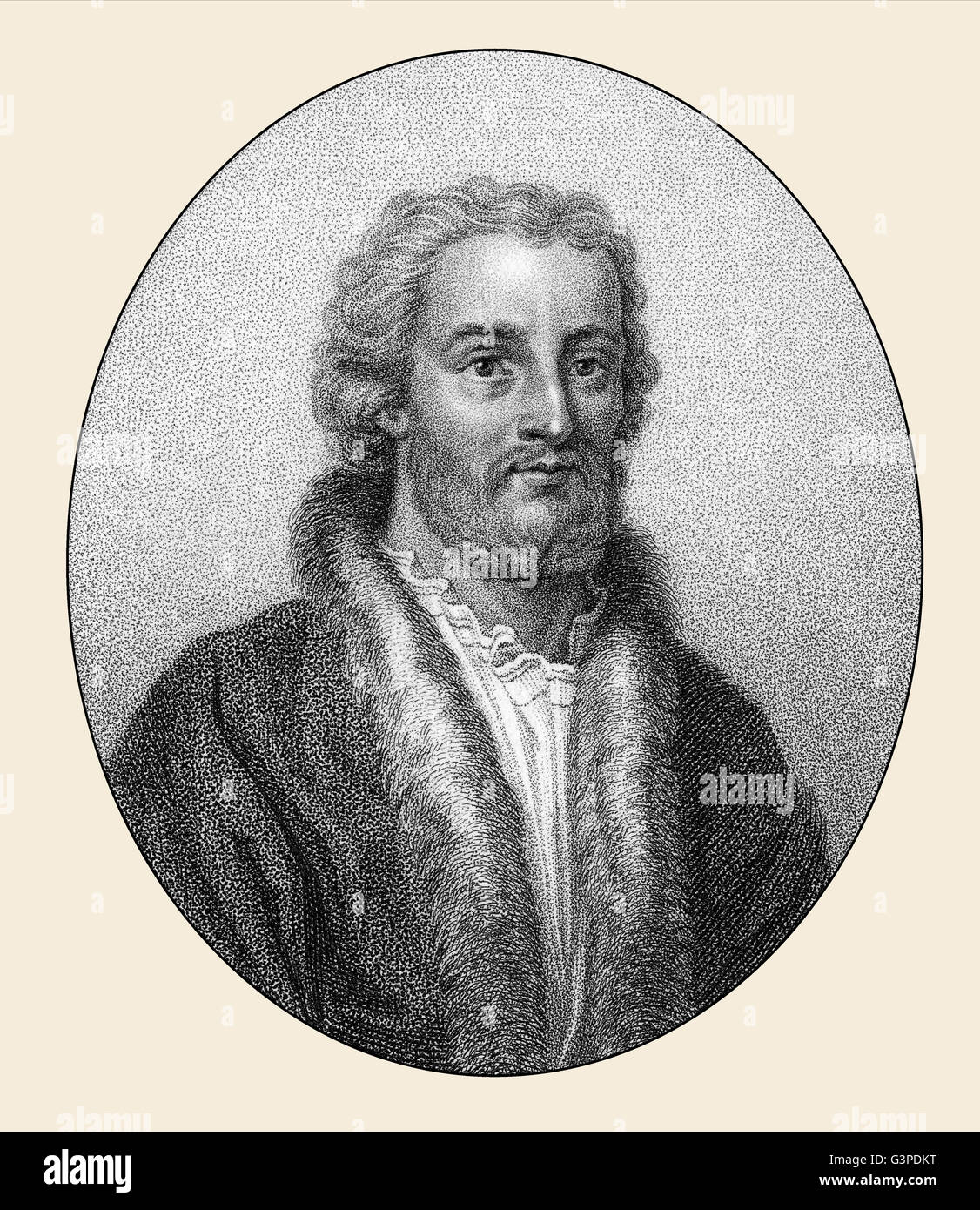 Sir John Oldcastle, died 1417, an English Lollard leader Stock Photohttps://www.alamy.com/image-license-details/?v=1https://www.alamy.com/stock-photo-sir-john-oldcastle-died-1417-an-english-lollard-leader-105599868.html
Sir John Oldcastle, died 1417, an English Lollard leader Stock Photohttps://www.alamy.com/image-license-details/?v=1https://www.alamy.com/stock-photo-sir-john-oldcastle-died-1417-an-english-lollard-leader-105599868.htmlRMG3PDKT–Sir John Oldcastle, died 1417, an English Lollard leader
 The figure represented here is an English knight in 1377. The illustration dates to 1882. Stock Photohttps://www.alamy.com/image-license-details/?v=1https://www.alamy.com/the-figure-represented-here-is-an-english-knight-in-1377-the-illustration-image69165176.html
The figure represented here is an English knight in 1377. The illustration dates to 1882. Stock Photohttps://www.alamy.com/image-license-details/?v=1https://www.alamy.com/the-figure-represented-here-is-an-english-knight-in-1377-the-illustration-image69165176.htmlRME0EMTT–The figure represented here is an English knight in 1377. The illustration dates to 1882.
 Statue of Sir Michael de la Pole, at Hull, 1871. 'The connection of the ancient English family of De La Pole with the borough of Kingston-on-Hull is well known. Those merchant princes, whose offspring rose to rank among the proudest and most powerful nobles, and allied themselves with the Royal lineage, belonged to this East Yorkshire seaport town...A statue, by the...sculptor, Mr. W. D. Keyworth, of Michael De la Pole, Earl of Suffolk, who was Lord Chancellor of England in the reign of Richard II., has just been erected in the Townhall, being the gift of the Sheriffs of Hull to the Corporatio Stock Photohttps://www.alamy.com/image-license-details/?v=1https://www.alamy.com/statue-of-sir-michael-de-la-pole-at-hull-1871-the-connection-of-the-ancient-english-family-of-de-la-pole-with-the-borough-of-kingston-on-hull-is-well-known-those-merchant-princes-whose-offspring-rose-to-rank-among-the-proudest-and-most-powerful-nobles-and-allied-themselves-with-the-royal-lineage-belonged-to-this-east-yorkshire-seaport-towna-statue-by-thesculptor-mr-w-d-keyworth-of-michael-de-la-pole-earl-of-suffolk-who-was-lord-chancellor-of-england-in-the-reign-of-richard-ii-has-just-been-erected-in-the-townhall-being-the-gift-of-the-sheriffs-of-hull-to-the-corporatio-image621680241.html
Statue of Sir Michael de la Pole, at Hull, 1871. 'The connection of the ancient English family of De La Pole with the borough of Kingston-on-Hull is well known. Those merchant princes, whose offspring rose to rank among the proudest and most powerful nobles, and allied themselves with the Royal lineage, belonged to this East Yorkshire seaport town...A statue, by the...sculptor, Mr. W. D. Keyworth, of Michael De la Pole, Earl of Suffolk, who was Lord Chancellor of England in the reign of Richard II., has just been erected in the Townhall, being the gift of the Sheriffs of Hull to the Corporatio Stock Photohttps://www.alamy.com/image-license-details/?v=1https://www.alamy.com/statue-of-sir-michael-de-la-pole-at-hull-1871-the-connection-of-the-ancient-english-family-of-de-la-pole-with-the-borough-of-kingston-on-hull-is-well-known-those-merchant-princes-whose-offspring-rose-to-rank-among-the-proudest-and-most-powerful-nobles-and-allied-themselves-with-the-royal-lineage-belonged-to-this-east-yorkshire-seaport-towna-statue-by-thesculptor-mr-w-d-keyworth-of-michael-de-la-pole-earl-of-suffolk-who-was-lord-chancellor-of-england-in-the-reign-of-richard-ii-has-just-been-erected-in-the-townhall-being-the-gift-of-the-sheriffs-of-hull-to-the-corporatio-image621680241.htmlRM2Y3BYDN–Statue of Sir Michael de la Pole, at Hull, 1871. 'The connection of the ancient English family of De La Pole with the borough of Kingston-on-Hull is well known. Those merchant princes, whose offspring rose to rank among the proudest and most powerful nobles, and allied themselves with the Royal lineage, belonged to this East Yorkshire seaport town...A statue, by the...sculptor, Mr. W. D. Keyworth, of Michael De la Pole, Earl of Suffolk, who was Lord Chancellor of England in the reign of Richard II., has just been erected in the Townhall, being the gift of the Sheriffs of Hull to the Corporatio
 Costumes, A.D. 1200-1300, from vintage colour print. Stock Photohttps://www.alamy.com/image-license-details/?v=1https://www.alamy.com/stock-photo-costumes-ad-1200-1300-from-vintage-colour-print-97831385.html
Costumes, A.D. 1200-1300, from vintage colour print. Stock Photohttps://www.alamy.com/image-license-details/?v=1https://www.alamy.com/stock-photo-costumes-ad-1200-1300-from-vintage-colour-print-97831385.htmlRFFK4GX1–Costumes, A.D. 1200-1300, from vintage colour print.
![Infographic about a medieval castle where kings, nobles and lords cohabited. [Adobe Illustrator (.ai); 4960x3188]. Stock Photo Infographic about a medieval castle where kings, nobles and lords cohabited. [Adobe Illustrator (.ai); 4960x3188]. Stock Photo](https://c8.alamy.com/comp/2NEC8GB/infographic-about-a-medieval-castle-where-kings-nobles-and-lords-cohabited-adobe-illustrator-ai-4960x3188-2NEC8GB.jpg) Infographic about a medieval castle where kings, nobles and lords cohabited. [Adobe Illustrator (.ai); 4960x3188]. Stock Photohttps://www.alamy.com/image-license-details/?v=1https://www.alamy.com/infographic-about-a-medieval-castle-where-kings-nobles-and-lords-cohabited-adobe-illustrator-ai-4960x3188-image525186379.html
Infographic about a medieval castle where kings, nobles and lords cohabited. [Adobe Illustrator (.ai); 4960x3188]. Stock Photohttps://www.alamy.com/image-license-details/?v=1https://www.alamy.com/infographic-about-a-medieval-castle-where-kings-nobles-and-lords-cohabited-adobe-illustrator-ai-4960x3188-image525186379.htmlRM2NEC8GB–Infographic about a medieval castle where kings, nobles and lords cohabited. [Adobe Illustrator (.ai); 4960x3188].
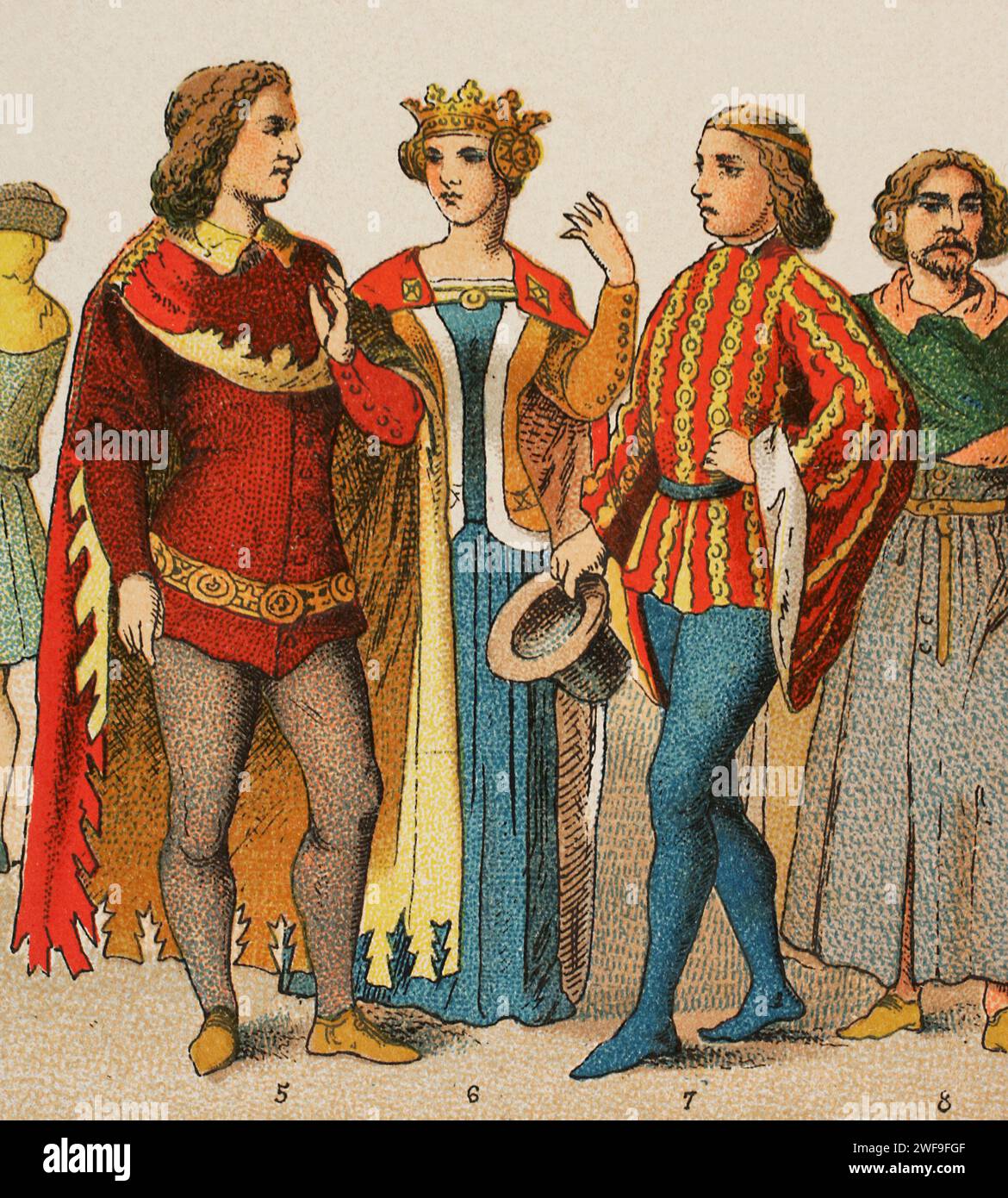 History of England. 1300-1400. From left to right, 5-6: court dresses, 7: knight, 8: citizen (ordinary people). Chromolithography. Detail. 'Historia Universal', by César Cantú. Volume VI, 1885. Stock Photohttps://www.alamy.com/image-license-details/?v=1https://www.alamy.com/history-of-england-1300-1400-from-left-to-right-5-6-court-dresses-7-knight-8-citizen-ordinary-people-chromolithography-detail-historia-universal-by-csar-cant-volume-vi-1885-image594582143.html
History of England. 1300-1400. From left to right, 5-6: court dresses, 7: knight, 8: citizen (ordinary people). Chromolithography. Detail. 'Historia Universal', by César Cantú. Volume VI, 1885. Stock Photohttps://www.alamy.com/image-license-details/?v=1https://www.alamy.com/history-of-england-1300-1400-from-left-to-right-5-6-court-dresses-7-knight-8-citizen-ordinary-people-chromolithography-detail-historia-universal-by-csar-cant-volume-vi-1885-image594582143.htmlRM2WF9FGF–History of England. 1300-1400. From left to right, 5-6: court dresses, 7: knight, 8: citizen (ordinary people). Chromolithography. Detail. 'Historia Universal', by César Cantú. Volume VI, 1885.
 A generic engraving of a medieval knight with a large empty scroll suitable for text Stock Photohttps://www.alamy.com/image-license-details/?v=1https://www.alamy.com/a-generic-engraving-of-a-medieval-knight-with-a-large-empty-scroll-suitable-for-text-image610857686.html
A generic engraving of a medieval knight with a large empty scroll suitable for text Stock Photohttps://www.alamy.com/image-license-details/?v=1https://www.alamy.com/a-generic-engraving-of-a-medieval-knight-with-a-large-empty-scroll-suitable-for-text-image610857686.htmlRM2XDPY5X–A generic engraving of a medieval knight with a large empty scroll suitable for text
 Comic Sketch by T S Seccombe showing knights jousting at a tournament in the Middle Ages Stock Photohttps://www.alamy.com/image-license-details/?v=1https://www.alamy.com/stock-photo-comic-sketch-by-t-s-seccombe-showing-knights-jousting-at-a-tournament-49864259.html
Comic Sketch by T S Seccombe showing knights jousting at a tournament in the Middle Ages Stock Photohttps://www.alamy.com/image-license-details/?v=1https://www.alamy.com/stock-photo-comic-sketch-by-t-s-seccombe-showing-knights-jousting-at-a-tournament-49864259.htmlRMCW3EAB–Comic Sketch by T S Seccombe showing knights jousting at a tournament in the Middle Ages
 Costumes of English Elizabethan nobles, 1586. Baron Anderley (sic) 55, Sir Roger North 56, Sir Thomas Shirley 57, Thomas Burgh, 3rd Baron Burgh 58, Peregrine Bertie, 13th Baron Willoughby of Eresby 59. Handcoloured lithograph by Pieter Willem Marius Trap after an illustration by Gerardus Johannes Bos in Maskerade, Leiden 1870, (Masquerade by Leiden Students 1870), a historical re-enactment of the visit by Robert Lord Dudley, Baron von Denbigh, Earl of Leicester, and others to Leiden University in 1586, published by Jac. Hazenberg Cornsz, Leiden, 1870. Stock Photohttps://www.alamy.com/image-license-details/?v=1https://www.alamy.com/costumes-of-english-elizabethan-nobles-1586-baron-anderley-sic-55-sir-roger-north-56-sir-thomas-shirley-57-thomas-burgh-3rd-baron-burgh-58-peregrine-bertie-13th-baron-willoughby-of-eresby-59-handcoloured-lithograph-by-pieter-willem-marius-trap-after-an-illustration-by-gerardus-johannes-bos-in-maskerade-leiden-1870-masquerade-by-leiden-students-1870-a-historical-re-enactment-of-the-visit-by-robert-lord-dudley-baron-von-denbigh-earl-of-leicester-and-others-to-leiden-university-in-1586-published-by-jac-hazenberg-cornsz-leiden-1870-image595201219.html
Costumes of English Elizabethan nobles, 1586. Baron Anderley (sic) 55, Sir Roger North 56, Sir Thomas Shirley 57, Thomas Burgh, 3rd Baron Burgh 58, Peregrine Bertie, 13th Baron Willoughby of Eresby 59. Handcoloured lithograph by Pieter Willem Marius Trap after an illustration by Gerardus Johannes Bos in Maskerade, Leiden 1870, (Masquerade by Leiden Students 1870), a historical re-enactment of the visit by Robert Lord Dudley, Baron von Denbigh, Earl of Leicester, and others to Leiden University in 1586, published by Jac. Hazenberg Cornsz, Leiden, 1870. Stock Photohttps://www.alamy.com/image-license-details/?v=1https://www.alamy.com/costumes-of-english-elizabethan-nobles-1586-baron-anderley-sic-55-sir-roger-north-56-sir-thomas-shirley-57-thomas-burgh-3rd-baron-burgh-58-peregrine-bertie-13th-baron-willoughby-of-eresby-59-handcoloured-lithograph-by-pieter-willem-marius-trap-after-an-illustration-by-gerardus-johannes-bos-in-maskerade-leiden-1870-masquerade-by-leiden-students-1870-a-historical-re-enactment-of-the-visit-by-robert-lord-dudley-baron-von-denbigh-earl-of-leicester-and-others-to-leiden-university-in-1586-published-by-jac-hazenberg-cornsz-leiden-1870-image595201219.htmlRM2WG9N6B–Costumes of English Elizabethan nobles, 1586. Baron Anderley (sic) 55, Sir Roger North 56, Sir Thomas Shirley 57, Thomas Burgh, 3rd Baron Burgh 58, Peregrine Bertie, 13th Baron Willoughby of Eresby 59. Handcoloured lithograph by Pieter Willem Marius Trap after an illustration by Gerardus Johannes Bos in Maskerade, Leiden 1870, (Masquerade by Leiden Students 1870), a historical re-enactment of the visit by Robert Lord Dudley, Baron von Denbigh, Earl of Leicester, and others to Leiden University in 1586, published by Jac. Hazenberg Cornsz, Leiden, 1870.
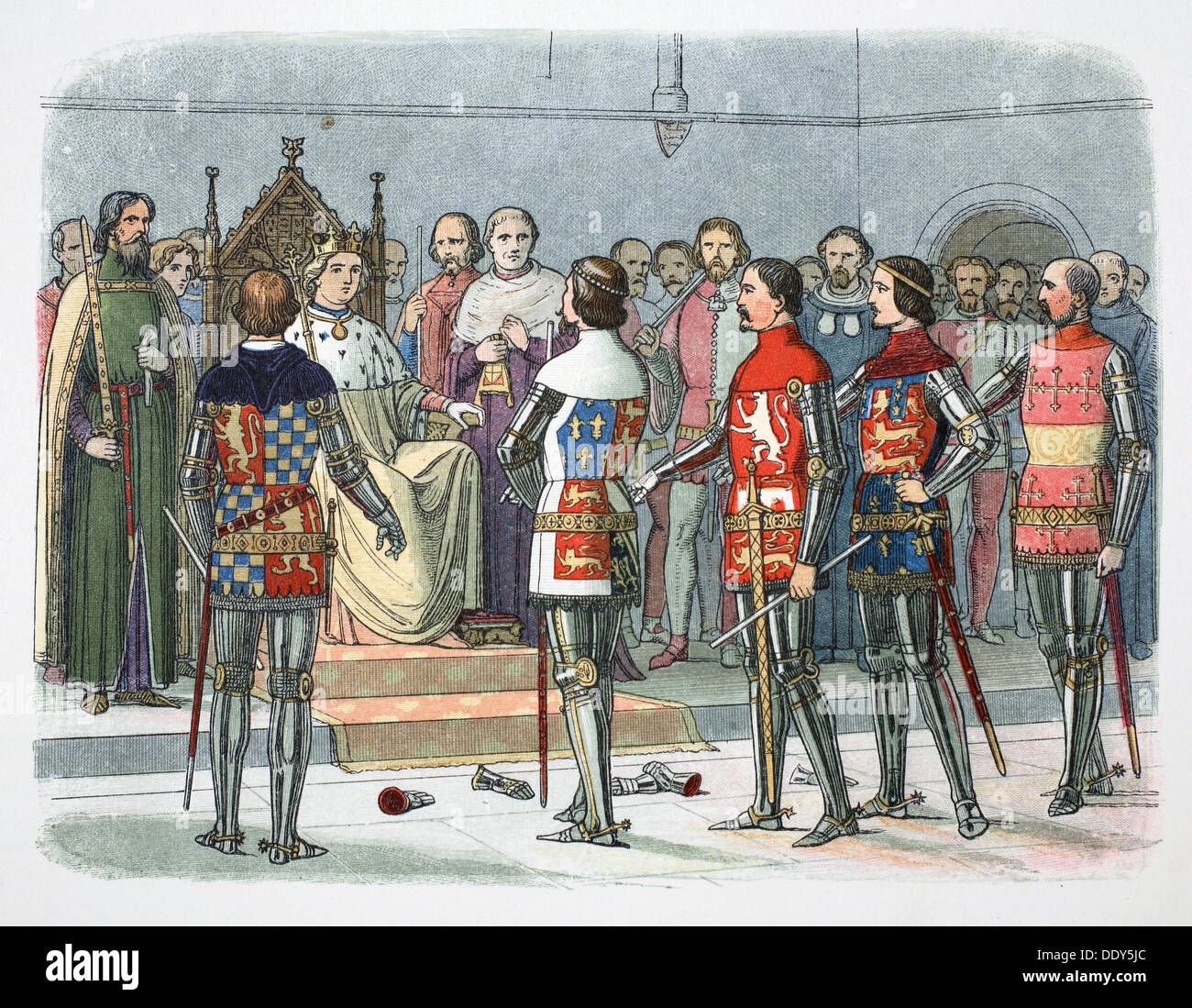 Nobles before King Richard II, Westminster, 1387 (1864). Artist: James William Edmund Doyle Stock Photohttps://www.alamy.com/image-license-details/?v=1https://www.alamy.com/nobles-before-king-richard-ii-westminster-1387-1864-artist-james-william-image60218772.html
Nobles before King Richard II, Westminster, 1387 (1864). Artist: James William Edmund Doyle Stock Photohttps://www.alamy.com/image-license-details/?v=1https://www.alamy.com/nobles-before-king-richard-ii-westminster-1387-1864-artist-james-william-image60218772.htmlRMDDY5JC–Nobles before King Richard II, Westminster, 1387 (1864). Artist: James William Edmund Doyle
 '...The nobles plucked red or white roses and put them in their caps', 15th century, (1905).Artist: A S Forrest Stock Photohttps://www.alamy.com/image-license-details/?v=1https://www.alamy.com/the-nobles-plucked-red-or-white-roses-and-put-them-in-their-caps-15th-century-1905artist-a-s-forrest-image262733066.html
'...The nobles plucked red or white roses and put them in their caps', 15th century, (1905).Artist: A S Forrest Stock Photohttps://www.alamy.com/image-license-details/?v=1https://www.alamy.com/the-nobles-plucked-red-or-white-roses-and-put-them-in-their-caps-15th-century-1905artist-a-s-forrest-image262733066.htmlRMW7CEKP–'...The nobles plucked red or white roses and put them in their caps', 15th century, (1905).Artist: A S Forrest
 Brass rubbing of a knight in armour, 1949. Knight wearing a helmet with chain mail: rubbing taken from a tomb in a church. Illustration from "English Brasses", handwritten, illustrated, and bound by calligrapher John Woodcock. The manuscript contains drawings of brass rubbings of many knights and nobles, including Sir John d'Abernon, Thomas de Hope, and Nichol de Gore, as well as noblewomen such as the wives of Reginald de Malyns, Nicholas Wadham, and Nicholas Wotton. Stock Photohttps://www.alamy.com/image-license-details/?v=1https://www.alamy.com/brass-rubbing-of-a-knight-in-armour-1949-knight-wearing-a-helmet-with-chain-mail-rubbing-taken-from-a-tomb-in-a-church-illustration-from-quotenglish-brassesquot-handwritten-illustrated-and-bound-by-calligrapher-john-woodcock-the-manuscript-contains-drawings-of-brass-rubbings-of-many-knights-and-nobles-including-sir-john-dabernon-thomas-de-hope-and-nichol-de-gore-as-well-as-noblewomen-such-as-the-wives-of-reginald-de-malyns-nicholas-wadham-and-nicholas-wotton-image571914594.html
Brass rubbing of a knight in armour, 1949. Knight wearing a helmet with chain mail: rubbing taken from a tomb in a church. Illustration from "English Brasses", handwritten, illustrated, and bound by calligrapher John Woodcock. The manuscript contains drawings of brass rubbings of many knights and nobles, including Sir John d'Abernon, Thomas de Hope, and Nichol de Gore, as well as noblewomen such as the wives of Reginald de Malyns, Nicholas Wadham, and Nicholas Wotton. Stock Photohttps://www.alamy.com/image-license-details/?v=1https://www.alamy.com/brass-rubbing-of-a-knight-in-armour-1949-knight-wearing-a-helmet-with-chain-mail-rubbing-taken-from-a-tomb-in-a-church-illustration-from-quotenglish-brassesquot-handwritten-illustrated-and-bound-by-calligrapher-john-woodcock-the-manuscript-contains-drawings-of-brass-rubbings-of-many-knights-and-nobles-including-sir-john-dabernon-thomas-de-hope-and-nichol-de-gore-as-well-as-noblewomen-such-as-the-wives-of-reginald-de-malyns-nicholas-wadham-and-nicholas-wotton-image571914594.htmlRM2T6CXW6–Brass rubbing of a knight in armour, 1949. Knight wearing a helmet with chain mail: rubbing taken from a tomb in a church. Illustration from "English Brasses", handwritten, illustrated, and bound by calligrapher John Woodcock. The manuscript contains drawings of brass rubbings of many knights and nobles, including Sir John d'Abernon, Thomas de Hope, and Nichol de Gore, as well as noblewomen such as the wives of Reginald de Malyns, Nicholas Wadham, and Nicholas Wotton.
 The Anglo-Saxon Invasion of England took place from the mid-fifth to early seventh centuries, following the end of Roman power in Britain around the year 410. The 'monthly' life of the times is illustrated in a series of pictures. The Anglo-Saxon Calendar 10/12: October aka Wyn-monat or Wine Month: The south of England was warm enough for small vineyards and the side illustrations show a grape presser preparing the wine-making process. Whilst on the farm autumn planting of seed took place in the fields. Meanwhile, the nobles and falconers caught herons and wild duck. Stock Photohttps://www.alamy.com/image-license-details/?v=1https://www.alamy.com/stock-image-the-anglo-saxon-invasion-of-england-took-place-from-the-mid-fifth-165453228.html
The Anglo-Saxon Invasion of England took place from the mid-fifth to early seventh centuries, following the end of Roman power in Britain around the year 410. The 'monthly' life of the times is illustrated in a series of pictures. The Anglo-Saxon Calendar 10/12: October aka Wyn-monat or Wine Month: The south of England was warm enough for small vineyards and the side illustrations show a grape presser preparing the wine-making process. Whilst on the farm autumn planting of seed took place in the fields. Meanwhile, the nobles and falconers caught herons and wild duck. Stock Photohttps://www.alamy.com/image-license-details/?v=1https://www.alamy.com/stock-image-the-anglo-saxon-invasion-of-england-took-place-from-the-mid-fifth-165453228.htmlRMKH517T–The Anglo-Saxon Invasion of England took place from the mid-fifth to early seventh centuries, following the end of Roman power in Britain around the year 410. The 'monthly' life of the times is illustrated in a series of pictures. The Anglo-Saxon Calendar 10/12: October aka Wyn-monat or Wine Month: The south of England was warm enough for small vineyards and the side illustrations show a grape presser preparing the wine-making process. Whilst on the farm autumn planting of seed took place in the fields. Meanwhile, the nobles and falconers caught herons and wild duck.
 Db535UK, Derbyshire, Tideswell, church Bower Chapel, C14th effigies of Sir Thurstan and Lady Margaret de Bower Stock Photohttps://www.alamy.com/image-license-details/?v=1https://www.alamy.com/stock-photo-db535uk-derbyshire-tideswell-church-bower-chapel-c14th-effigies-of-77815548.html
Db535UK, Derbyshire, Tideswell, church Bower Chapel, C14th effigies of Sir Thurstan and Lady Margaret de Bower Stock Photohttps://www.alamy.com/image-license-details/?v=1https://www.alamy.com/stock-photo-db535uk-derbyshire-tideswell-church-bower-chapel-c14th-effigies-of-77815548.htmlRMEEGPEM–Db535UK, Derbyshire, Tideswell, church Bower Chapel, C14th effigies of Sir Thurstan and Lady Margaret de Bower
 A late 19th Century illustration of Arundel Castle, a restored and remodelled medieval castle in Arundel, West Sussex, England. It was established by Roger de Montgomery on Christmas Day 1067 who became the first to hold the earldom of Arundel by the graces of William the Conqueror. The castle was damaged in the English Civil War and then restored in the 18th and 19th centuries by Charles Howard the 11th Duke of Norfolk. Stock Photohttps://www.alamy.com/image-license-details/?v=1https://www.alamy.com/a-late-19th-century-illustration-of-arundel-castle-a-restored-and-remodelled-medieval-castle-in-arundel-west-sussex-england-it-was-established-by-roger-de-montgomery-on-christmas-day-1067-who-became-the-first-to-hold-the-earldom-of-arundel-by-the-graces-of-william-the-conqueror-the-castle-was-damaged-in-the-english-civil-war-and-then-restored-in-the-18th-and-19th-centuries-by-charles-howard-the-11th-duke-of-norfolk-image453182256.html
A late 19th Century illustration of Arundel Castle, a restored and remodelled medieval castle in Arundel, West Sussex, England. It was established by Roger de Montgomery on Christmas Day 1067 who became the first to hold the earldom of Arundel by the graces of William the Conqueror. The castle was damaged in the English Civil War and then restored in the 18th and 19th centuries by Charles Howard the 11th Duke of Norfolk. Stock Photohttps://www.alamy.com/image-license-details/?v=1https://www.alamy.com/a-late-19th-century-illustration-of-arundel-castle-a-restored-and-remodelled-medieval-castle-in-arundel-west-sussex-england-it-was-established-by-roger-de-montgomery-on-christmas-day-1067-who-became-the-first-to-hold-the-earldom-of-arundel-by-the-graces-of-william-the-conqueror-the-castle-was-damaged-in-the-english-civil-war-and-then-restored-in-the-18th-and-19th-centuries-by-charles-howard-the-11th-duke-of-norfolk-image453182256.htmlRM2H986GG–A late 19th Century illustration of Arundel Castle, a restored and remodelled medieval castle in Arundel, West Sussex, England. It was established by Roger de Montgomery on Christmas Day 1067 who became the first to hold the earldom of Arundel by the graces of William the Conqueror. The castle was damaged in the English Civil War and then restored in the 18th and 19th centuries by Charles Howard the 11th Duke of Norfolk.
 Harris Hawk on a Perch wearing Leather hood, popularly used for the Medieval fieldsport of Falconry Stock Photohttps://www.alamy.com/image-license-details/?v=1https://www.alamy.com/stock-photo-harris-hawk-on-a-perch-wearing-leather-hood-popularly-used-for-the-25641915.html
Harris Hawk on a Perch wearing Leather hood, popularly used for the Medieval fieldsport of Falconry Stock Photohttps://www.alamy.com/image-license-details/?v=1https://www.alamy.com/stock-photo-harris-hawk-on-a-perch-wearing-leather-hood-popularly-used-for-the-25641915.htmlRMBDM2EK–Harris Hawk on a Perch wearing Leather hood, popularly used for the Medieval fieldsport of Falconry
 The dismissal of the Earl of Murray and Abbot of Kilwinning by Queen Elizabeth I after taking the side of Mary, Queen of Scots in 1561. Queen Elizabeth !, feared that the French planned to invade England and put her Catholic cousin Mary, Queen of Scots, on the throne. Mary was considered by many to be the heir to the English crown, being the granddaughter of Henry VIII's elder sister, Margaret. When Mary returned to Scotland in 1561 to take up the reins of power, the country had an established Protestant church and was run by a council of Protestant nobles supported by Elizabeth. Stock Photohttps://www.alamy.com/image-license-details/?v=1https://www.alamy.com/stock-photo-the-dismissal-of-the-earl-of-murray-and-abbot-of-kilwinning-by-queen-87311072.html
The dismissal of the Earl of Murray and Abbot of Kilwinning by Queen Elizabeth I after taking the side of Mary, Queen of Scots in 1561. Queen Elizabeth !, feared that the French planned to invade England and put her Catholic cousin Mary, Queen of Scots, on the throne. Mary was considered by many to be the heir to the English crown, being the granddaughter of Henry VIII's elder sister, Margaret. When Mary returned to Scotland in 1561 to take up the reins of power, the country had an established Protestant church and was run by a council of Protestant nobles supported by Elizabeth. Stock Photohttps://www.alamy.com/image-license-details/?v=1https://www.alamy.com/stock-photo-the-dismissal-of-the-earl-of-murray-and-abbot-of-kilwinning-by-queen-87311072.htmlRMF21A4G–The dismissal of the Earl of Murray and Abbot of Kilwinning by Queen Elizabeth I after taking the side of Mary, Queen of Scots in 1561. Queen Elizabeth !, feared that the French planned to invade England and put her Catholic cousin Mary, Queen of Scots, on the throne. Mary was considered by many to be the heir to the English crown, being the granddaughter of Henry VIII's elder sister, Margaret. When Mary returned to Scotland in 1561 to take up the reins of power, the country had an established Protestant church and was run by a council of Protestant nobles supported by Elizabeth.
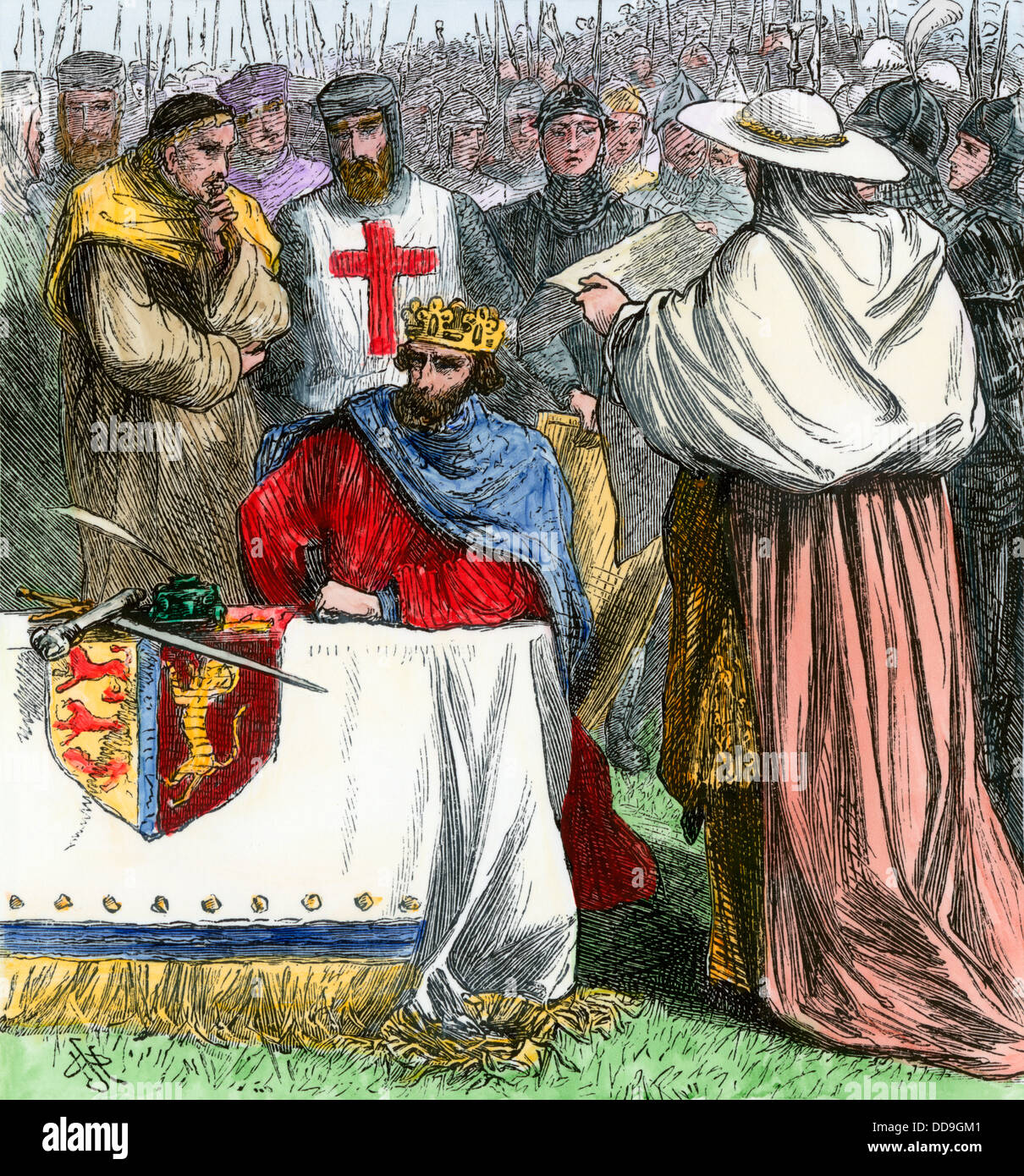 King John given the Magna Carta to endorse, 1215. Hand-colored woodcut Stock Photohttps://www.alamy.com/image-license-details/?v=1https://www.alamy.com/stock-photo-king-john-given-the-magna-carta-to-endorse-1215-hand-colored-woodcut-59832305.html
King John given the Magna Carta to endorse, 1215. Hand-colored woodcut Stock Photohttps://www.alamy.com/image-license-details/?v=1https://www.alamy.com/stock-photo-king-john-given-the-magna-carta-to-endorse-1215-hand-colored-woodcut-59832305.htmlRMDD9GM1–King John given the Magna Carta to endorse, 1215. Hand-colored woodcut
 Essex House, fronting the Strand in London was originally called Leicester House. Backing on to the River Thames, it was built around 1575 for Robert Dudley, Earl of Leicester, and was renamed Essex House by his stepson, Robert Devereux, 2nd Earl of Essex, (1565-1601), an English nobleman, general and a favourite of Elizabeth I. In 1601 he marched with a party of nobles (some later involved in the Gunpowder Plot) and made an unsuccessful attempt to force an audience with the Queen. He surrendered after Crown forces besieged Essex House and was executed for treason in 1601. Stock Photohttps://www.alamy.com/image-license-details/?v=1https://www.alamy.com/essex-house-fronting-the-strand-in-london-was-originally-called-leicester-house-backing-on-to-the-river-thames-it-was-built-around-1575-for-robert-dudley-earl-of-leicester-and-was-renamed-essex-house-by-his-stepson-robert-devereux-2nd-earl-of-essex-1565-1601-an-english-nobleman-general-and-a-favourite-of-elizabeth-i-in-1601-he-marched-with-a-party-of-nobles-some-later-involved-in-the-gunpowder-plot-and-made-an-unsuccessful-attempt-to-force-an-audience-with-the-queen-he-surrendered-after-crown-forces-besieged-essex-house-and-was-executed-for-treason-in-1601-image214914648.html
Essex House, fronting the Strand in London was originally called Leicester House. Backing on to the River Thames, it was built around 1575 for Robert Dudley, Earl of Leicester, and was renamed Essex House by his stepson, Robert Devereux, 2nd Earl of Essex, (1565-1601), an English nobleman, general and a favourite of Elizabeth I. In 1601 he marched with a party of nobles (some later involved in the Gunpowder Plot) and made an unsuccessful attempt to force an audience with the Queen. He surrendered after Crown forces besieged Essex House and was executed for treason in 1601. Stock Photohttps://www.alamy.com/image-license-details/?v=1https://www.alamy.com/essex-house-fronting-the-strand-in-london-was-originally-called-leicester-house-backing-on-to-the-river-thames-it-was-built-around-1575-for-robert-dudley-earl-of-leicester-and-was-renamed-essex-house-by-his-stepson-robert-devereux-2nd-earl-of-essex-1565-1601-an-english-nobleman-general-and-a-favourite-of-elizabeth-i-in-1601-he-marched-with-a-party-of-nobles-some-later-involved-in-the-gunpowder-plot-and-made-an-unsuccessful-attempt-to-force-an-audience-with-the-queen-he-surrendered-after-crown-forces-besieged-essex-house-and-was-executed-for-treason-in-1601-image214914648.htmlRMPDJ5R4–Essex House, fronting the Strand in London was originally called Leicester House. Backing on to the River Thames, it was built around 1575 for Robert Dudley, Earl of Leicester, and was renamed Essex House by his stepson, Robert Devereux, 2nd Earl of Essex, (1565-1601), an English nobleman, general and a favourite of Elizabeth I. In 1601 he marched with a party of nobles (some later involved in the Gunpowder Plot) and made an unsuccessful attempt to force an audience with the Queen. He surrendered after Crown forces besieged Essex House and was executed for treason in 1601.
 Anthony Woodville, 2nd Earl Rivers, c. 1440-1483, an English nobleman, courtier, bibliophile and writer Stock Photohttps://www.alamy.com/image-license-details/?v=1https://www.alamy.com/stock-photo-anthony-woodville-2nd-earl-rivers-c-1440-1483-an-english-nobleman-105599918.html
Anthony Woodville, 2nd Earl Rivers, c. 1440-1483, an English nobleman, courtier, bibliophile and writer Stock Photohttps://www.alamy.com/image-license-details/?v=1https://www.alamy.com/stock-photo-anthony-woodville-2nd-earl-rivers-c-1440-1483-an-english-nobleman-105599918.htmlRMG3PDNJ–Anthony Woodville, 2nd Earl Rivers, c. 1440-1483, an English nobleman, courtier, bibliophile and writer
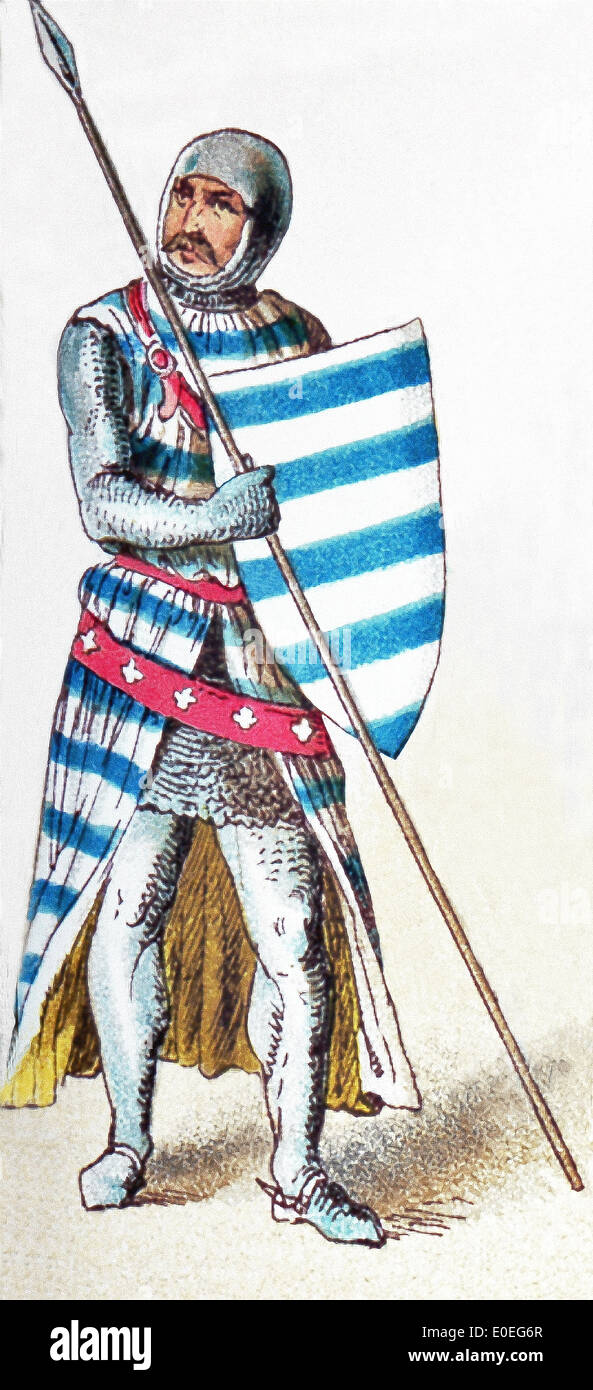 The figure represented here is an English knight in 1333. The illustration dates to 1882. Stock Photohttps://www.alamy.com/image-license-details/?v=1https://www.alamy.com/the-figure-represented-here-is-an-english-knight-in-1333-the-illustration-image69161535.html
The figure represented here is an English knight in 1333. The illustration dates to 1882. Stock Photohttps://www.alamy.com/image-license-details/?v=1https://www.alamy.com/the-figure-represented-here-is-an-english-knight-in-1333-the-illustration-image69161535.htmlRME0EG6R–The figure represented here is an English knight in 1333. The illustration dates to 1882.
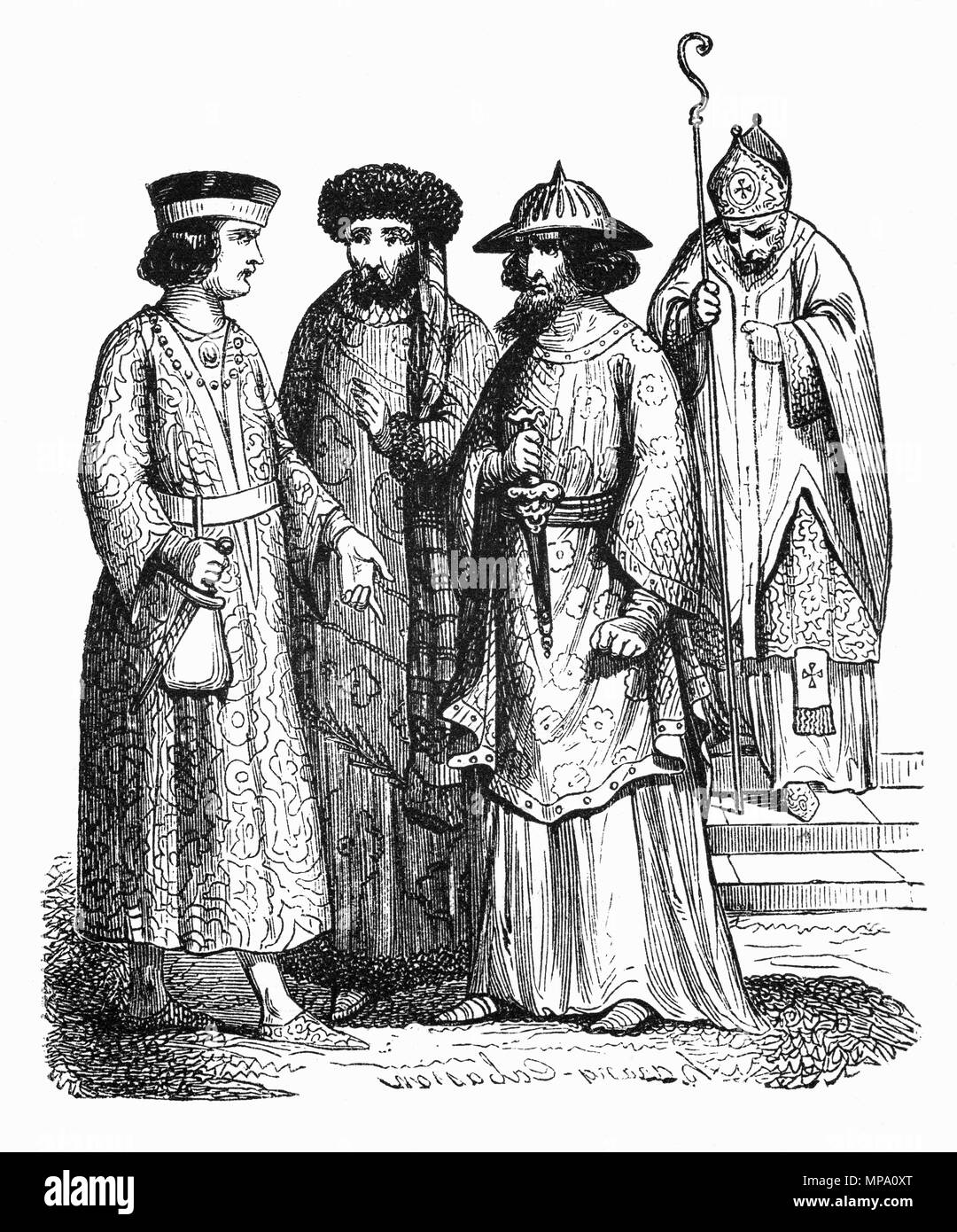 The attire of Bishops and Lords in England during the early part of the 12th Century Stock Photohttps://www.alamy.com/image-license-details/?v=1https://www.alamy.com/the-attire-of-bishops-and-lords-in-england-during-the-early-part-of-the-12th-century-image185846384.html
The attire of Bishops and Lords in England during the early part of the 12th Century Stock Photohttps://www.alamy.com/image-license-details/?v=1https://www.alamy.com/the-attire-of-bishops-and-lords-in-england-during-the-early-part-of-the-12th-century-image185846384.htmlRMMPA0XT–The attire of Bishops and Lords in England during the early part of the 12th Century
 (Whole folio) The Tower of London, with London Bridge behind. Charles, Duke of Orleans, seen writing, standing at a window and dispatching a letter in the courtyard. Poems of Charles, Duke of Orleans. England; circa 1500. Source: Royal 16 F. II, f.73. Language: English, French, Lati. Stock Photohttps://www.alamy.com/image-license-details/?v=1https://www.alamy.com/whole-folio-the-tower-of-london-with-london-bridge-behind-charles-duke-of-orleans-seen-writing-standing-at-a-window-and-dispatching-a-letter-in-the-courtyard-poems-of-charles-duke-of-orleans-england-circa-1500-source-royal-16-f-ii-f73-language-english-french-lati-image226992284.html
(Whole folio) The Tower of London, with London Bridge behind. Charles, Duke of Orleans, seen writing, standing at a window and dispatching a letter in the courtyard. Poems of Charles, Duke of Orleans. England; circa 1500. Source: Royal 16 F. II, f.73. Language: English, French, Lati. Stock Photohttps://www.alamy.com/image-license-details/?v=1https://www.alamy.com/whole-folio-the-tower-of-london-with-london-bridge-behind-charles-duke-of-orleans-seen-writing-standing-at-a-window-and-dispatching-a-letter-in-the-courtyard-poems-of-charles-duke-of-orleans-england-circa-1500-source-royal-16-f-ii-f73-language-english-french-lati-image226992284.htmlRMR58AY8–(Whole folio) The Tower of London, with London Bridge behind. Charles, Duke of Orleans, seen writing, standing at a window and dispatching a letter in the courtyard. Poems of Charles, Duke of Orleans. England; circa 1500. Source: Royal 16 F. II, f.73. Language: English, French, Lati.
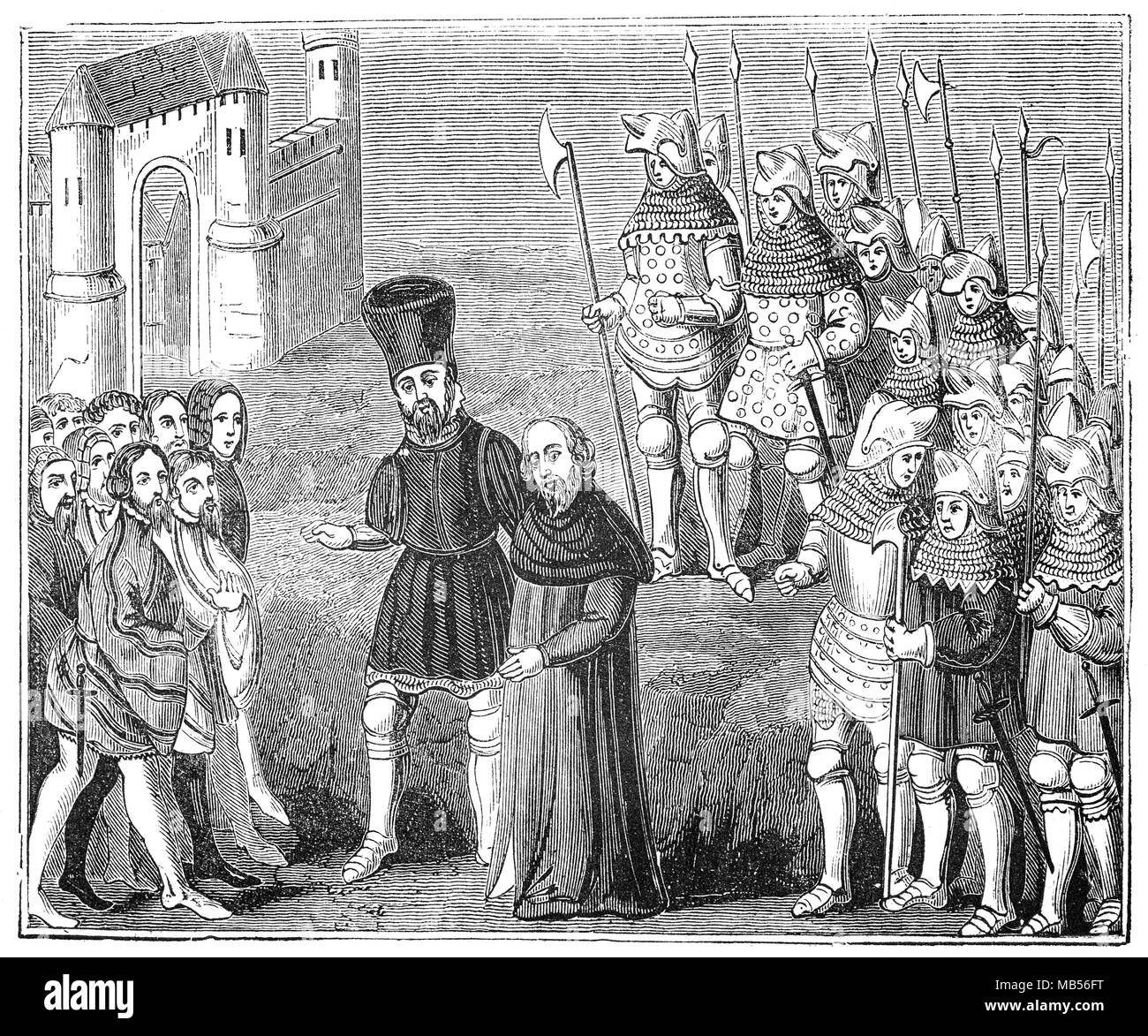 Richard II (1367 – 1400) and Henry Bolingbroke later to become Henry IV (1367 - 1413), arrive in London in 1399 before the parliamentary session in which Richard gave up his crown willingly and ratified his deposition citing as a reason his own unworthiness as a monarch. Stock Photohttps://www.alamy.com/image-license-details/?v=1https://www.alamy.com/richard-ii-1367-1400-and-henry-bolingbroke-later-to-become-henry-iv-1367-1413-arrive-in-london-in-1399-before-the-parliamentary-session-in-which-richard-gave-up-his-crown-willingly-and-ratified-his-deposition-citing-as-a-reason-his-own-unworthiness-as-a-monarch-image178979804.html
Richard II (1367 – 1400) and Henry Bolingbroke later to become Henry IV (1367 - 1413), arrive in London in 1399 before the parliamentary session in which Richard gave up his crown willingly and ratified his deposition citing as a reason his own unworthiness as a monarch. Stock Photohttps://www.alamy.com/image-license-details/?v=1https://www.alamy.com/richard-ii-1367-1400-and-henry-bolingbroke-later-to-become-henry-iv-1367-1413-arrive-in-london-in-1399-before-the-parliamentary-session-in-which-richard-gave-up-his-crown-willingly-and-ratified-his-deposition-citing-as-a-reason-his-own-unworthiness-as-a-monarch-image178979804.htmlRMMB56FT–Richard II (1367 – 1400) and Henry Bolingbroke later to become Henry IV (1367 - 1413), arrive in London in 1399 before the parliamentary session in which Richard gave up his crown willingly and ratified his deposition citing as a reason his own unworthiness as a monarch.
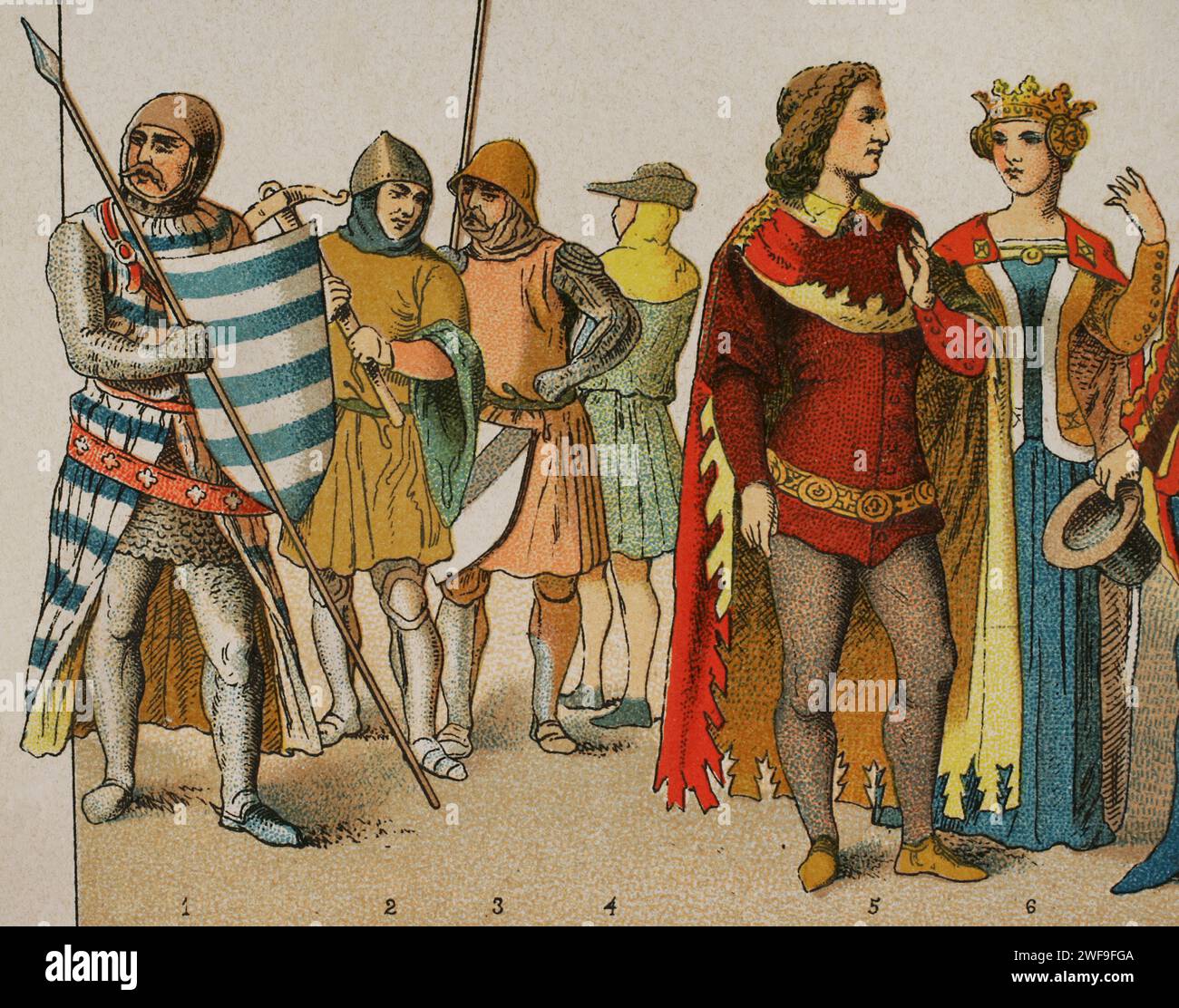 History of England. 1300-1400. From left to right, 1: warrior, 2: crossbowman, 1376. 3: warrior, 4: ordinary people dress, 5-6: court dresses. Chromolithography. Detail. 'Historia Universal', by César Cantú. Volume VI, 1885. Stock Photohttps://www.alamy.com/image-license-details/?v=1https://www.alamy.com/history-of-england-1300-1400-from-left-to-right-1-warrior-2-crossbowman-1376-3-warrior-4-ordinary-people-dress-5-6-court-dresses-chromolithography-detail-historia-universal-by-csar-cant-volume-vi-1885-image594582138.html
History of England. 1300-1400. From left to right, 1: warrior, 2: crossbowman, 1376. 3: warrior, 4: ordinary people dress, 5-6: court dresses. Chromolithography. Detail. 'Historia Universal', by César Cantú. Volume VI, 1885. Stock Photohttps://www.alamy.com/image-license-details/?v=1https://www.alamy.com/history-of-england-1300-1400-from-left-to-right-1-warrior-2-crossbowman-1376-3-warrior-4-ordinary-people-dress-5-6-court-dresses-chromolithography-detail-historia-universal-by-csar-cant-volume-vi-1885-image594582138.htmlRM2WF9FGA–History of England. 1300-1400. From left to right, 1: warrior, 2: crossbowman, 1376. 3: warrior, 4: ordinary people dress, 5-6: court dresses. Chromolithography. Detail. 'Historia Universal', by César Cantú. Volume VI, 1885.
 A generic engraving of a medieval hunting hawk as a symbol of kingship with an empty scroll suitable for text Stock Photohttps://www.alamy.com/image-license-details/?v=1https://www.alamy.com/a-generic-engraving-of-a-medieval-hunting-hawk-as-a-symbol-of-kingship-with-an-empty-scroll-suitable-for-text-image610857695.html
A generic engraving of a medieval hunting hawk as a symbol of kingship with an empty scroll suitable for text Stock Photohttps://www.alamy.com/image-license-details/?v=1https://www.alamy.com/a-generic-engraving-of-a-medieval-hunting-hawk-as-a-symbol-of-kingship-with-an-empty-scroll-suitable-for-text-image610857695.htmlRM2XDPY67–A generic engraving of a medieval hunting hawk as a symbol of kingship with an empty scroll suitable for text
 A 10th Century Witenagemot, a political institution in Anglo-Saxon England which operated from before the 7th century until the 11th century. It was an assembly of the ruling class whose primary function was to advise the king and whose membership was composed of the most important noblemen in England, both ecclesiastic and secular. Stock Photohttps://www.alamy.com/image-license-details/?v=1https://www.alamy.com/stock-image-a-10th-century-witenagemot-a-political-institution-in-anglo-saxon-165794320.html
A 10th Century Witenagemot, a political institution in Anglo-Saxon England which operated from before the 7th century until the 11th century. It was an assembly of the ruling class whose primary function was to advise the king and whose membership was composed of the most important noblemen in England, both ecclesiastic and secular. Stock Photohttps://www.alamy.com/image-license-details/?v=1https://www.alamy.com/stock-image-a-10th-century-witenagemot-a-political-institution-in-anglo-saxon-165794320.htmlRMKHMG9M–A 10th Century Witenagemot, a political institution in Anglo-Saxon England which operated from before the 7th century until the 11th century. It was an assembly of the ruling class whose primary function was to advise the king and whose membership was composed of the most important noblemen in England, both ecclesiastic and secular.
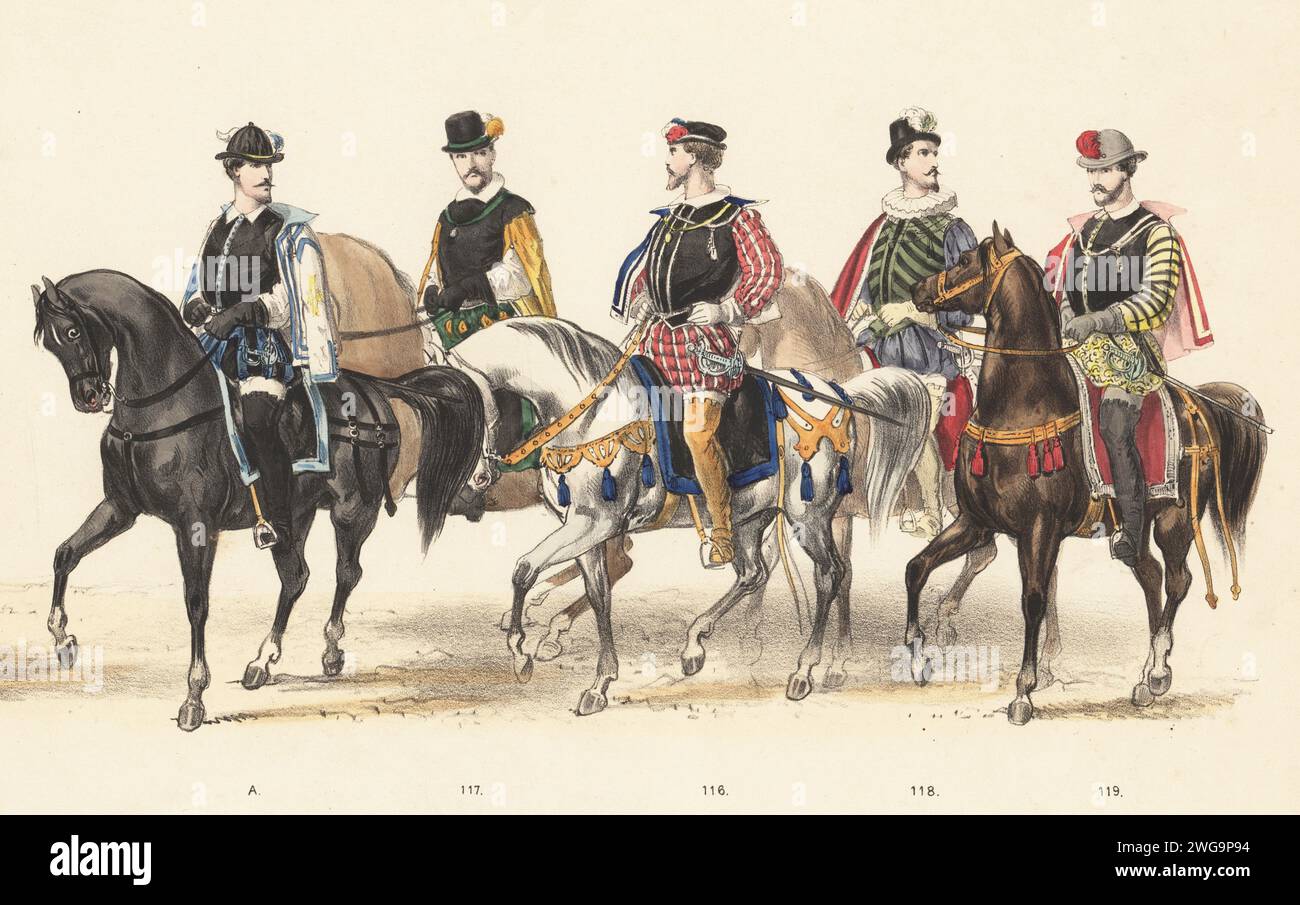 Costume of Dutch and English nobles, 1586. Cornelis Jansz van Egmond van de Nijenburg, mayor of Alkmaar A, Adriaan van Bleyenburg 117, Arend van Dorp 118, and Elizabethan courtiers Sir Walter Waller 116 and Henry Touchet, Lord Audley 119. Handcoloured lithograph by Pieter Willem Marius Trap after an illustration by Gerardus Johannes Bos in Maskerade, Leiden 1870, (Masquerade by Leiden Students 1870), a historical re-enactment of the visit by Robert Lord Dudley, Baron von Denbigh, Earl of Leicester, and others to Leiden University in 1586, published by Jac. Hazenberg Cornsz, Leiden, 1870. Stock Photohttps://www.alamy.com/image-license-details/?v=1https://www.alamy.com/costume-of-dutch-and-english-nobles-1586-cornelis-jansz-van-egmond-van-de-nijenburg-mayor-of-alkmaar-a-adriaan-van-bleyenburg-117-arend-van-dorp-118-and-elizabethan-courtiers-sir-walter-waller-116-and-henry-touchet-lord-audley-119-handcoloured-lithograph-by-pieter-willem-marius-trap-after-an-illustration-by-gerardus-johannes-bos-in-maskerade-leiden-1870-masquerade-by-leiden-students-1870-a-historical-re-enactment-of-the-visit-by-robert-lord-dudley-baron-von-denbigh-earl-of-leicester-and-others-to-leiden-university-in-1586-published-by-jac-hazenberg-cornsz-leiden-1870-image595202080.html
Costume of Dutch and English nobles, 1586. Cornelis Jansz van Egmond van de Nijenburg, mayor of Alkmaar A, Adriaan van Bleyenburg 117, Arend van Dorp 118, and Elizabethan courtiers Sir Walter Waller 116 and Henry Touchet, Lord Audley 119. Handcoloured lithograph by Pieter Willem Marius Trap after an illustration by Gerardus Johannes Bos in Maskerade, Leiden 1870, (Masquerade by Leiden Students 1870), a historical re-enactment of the visit by Robert Lord Dudley, Baron von Denbigh, Earl of Leicester, and others to Leiden University in 1586, published by Jac. Hazenberg Cornsz, Leiden, 1870. Stock Photohttps://www.alamy.com/image-license-details/?v=1https://www.alamy.com/costume-of-dutch-and-english-nobles-1586-cornelis-jansz-van-egmond-van-de-nijenburg-mayor-of-alkmaar-a-adriaan-van-bleyenburg-117-arend-van-dorp-118-and-elizabethan-courtiers-sir-walter-waller-116-and-henry-touchet-lord-audley-119-handcoloured-lithograph-by-pieter-willem-marius-trap-after-an-illustration-by-gerardus-johannes-bos-in-maskerade-leiden-1870-masquerade-by-leiden-students-1870-a-historical-re-enactment-of-the-visit-by-robert-lord-dudley-baron-von-denbigh-earl-of-leicester-and-others-to-leiden-university-in-1586-published-by-jac-hazenberg-cornsz-leiden-1870-image595202080.htmlRM2WG9P94–Costume of Dutch and English nobles, 1586. Cornelis Jansz van Egmond van de Nijenburg, mayor of Alkmaar A, Adriaan van Bleyenburg 117, Arend van Dorp 118, and Elizabethan courtiers Sir Walter Waller 116 and Henry Touchet, Lord Audley 119. Handcoloured lithograph by Pieter Willem Marius Trap after an illustration by Gerardus Johannes Bos in Maskerade, Leiden 1870, (Masquerade by Leiden Students 1870), a historical re-enactment of the visit by Robert Lord Dudley, Baron von Denbigh, Earl of Leicester, and others to Leiden University in 1586, published by Jac. Hazenberg Cornsz, Leiden, 1870.
![Infographics of the social structure of the feudal system in medieval Europe and map of European realms in the 13th century. [Adobe Illustrator (.ai); 2480x3248]. Stock Photo Infographics of the social structure of the feudal system in medieval Europe and map of European realms in the 13th century. [Adobe Illustrator (.ai); 2480x3248]. Stock Photo](https://c8.alamy.com/comp/2NEBH1K/infographics-of-the-social-structure-of-the-feudal-system-in-medieval-europe-and-map-of-european-realms-in-the-13th-century-adobe-illustrator-ai-2480x3248-2NEBH1K.jpg) Infographics of the social structure of the feudal system in medieval Europe and map of European realms in the 13th century. [Adobe Illustrator (.ai); 2480x3248]. Stock Photohttps://www.alamy.com/image-license-details/?v=1https://www.alamy.com/infographics-of-the-social-structure-of-the-feudal-system-in-medieval-europe-and-map-of-european-realms-in-the-13th-century-adobe-illustrator-ai-2480x3248-image525171071.html
Infographics of the social structure of the feudal system in medieval Europe and map of European realms in the 13th century. [Adobe Illustrator (.ai); 2480x3248]. Stock Photohttps://www.alamy.com/image-license-details/?v=1https://www.alamy.com/infographics-of-the-social-structure-of-the-feudal-system-in-medieval-europe-and-map-of-european-realms-in-the-13th-century-adobe-illustrator-ai-2480x3248-image525171071.htmlRM2NEBH1K–Infographics of the social structure of the feudal system in medieval Europe and map of European realms in the 13th century. [Adobe Illustrator (.ai); 2480x3248].
 11th century calendar: November - a group round a fire. 19th century reproduction. Stock Photohttps://www.alamy.com/image-license-details/?v=1https://www.alamy.com/stock-photo-11th-century-calendar-november-a-group-round-a-fire-19th-century-reproduction-83343661.html
11th century calendar: November - a group round a fire. 19th century reproduction. Stock Photohttps://www.alamy.com/image-license-details/?v=1https://www.alamy.com/stock-photo-11th-century-calendar-november-a-group-round-a-fire-19th-century-reproduction-83343661.htmlRMERGHK9–11th century calendar: November - a group round a fire. 19th century reproduction.
 Portrait of Henry Frederick Stuart Prince of Wales 1610 by Peake Robert, 1576 Italy, Italian, Stock Photohttps://www.alamy.com/image-license-details/?v=1https://www.alamy.com/portrait-of-henry-frederick-stuart-prince-of-wales-1610-by-peake-robert-1576-italy-italian-image451091857.html
Portrait of Henry Frederick Stuart Prince of Wales 1610 by Peake Robert, 1576 Italy, Italian, Stock Photohttps://www.alamy.com/image-license-details/?v=1https://www.alamy.com/portrait-of-henry-frederick-stuart-prince-of-wales-1610-by-peake-robert-1576-italy-italian-image451091857.htmlRM2H5W07D–Portrait of Henry Frederick Stuart Prince of Wales 1610 by Peake Robert, 1576 Italy, Italian,
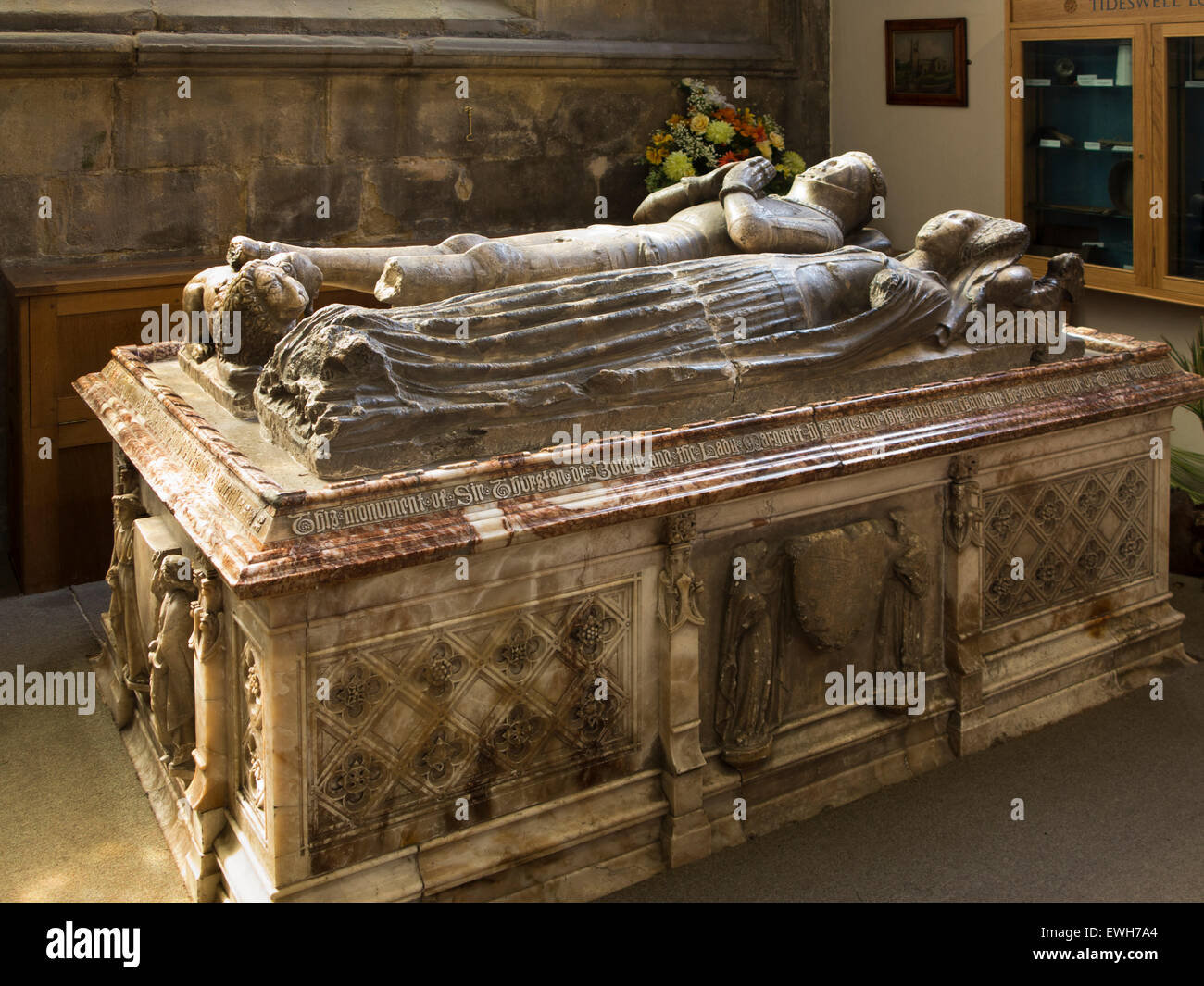 UK, Derbyshire, Tideswell, church Bower Chapel, effigies of Sir Thurstan and Lady Margaret de Bower Stock Photohttps://www.alamy.com/image-license-details/?v=1https://www.alamy.com/stock-photo-uk-derbyshire-tideswell-church-bower-chapel-effigies-of-sir-thurstan-84586828.html
UK, Derbyshire, Tideswell, church Bower Chapel, effigies of Sir Thurstan and Lady Margaret de Bower Stock Photohttps://www.alamy.com/image-license-details/?v=1https://www.alamy.com/stock-photo-uk-derbyshire-tideswell-church-bower-chapel-effigies-of-sir-thurstan-84586828.htmlRMEWH7A4–UK, Derbyshire, Tideswell, church Bower Chapel, effigies of Sir Thurstan and Lady Margaret de Bower
 UK, Derbyshire, Tideswell, church Bower Chapel, effigies of Sir Thurstan and Lady Margaret de Bower Stock Photohttps://www.alamy.com/image-license-details/?v=1https://www.alamy.com/stock-photo-uk-derbyshire-tideswell-church-bower-chapel-effigies-of-sir-thurstan-77815549.html
UK, Derbyshire, Tideswell, church Bower Chapel, effigies of Sir Thurstan and Lady Margaret de Bower Stock Photohttps://www.alamy.com/image-license-details/?v=1https://www.alamy.com/stock-photo-uk-derbyshire-tideswell-church-bower-chapel-effigies-of-sir-thurstan-77815549.htmlRMEEGPEN–UK, Derbyshire, Tideswell, church Bower Chapel, effigies of Sir Thurstan and Lady Margaret de Bower
 Ivanhoe's costumes at the ball given by The Prince and Princess of Orange in Brussels, Wednesday February 5, 1823. Brussels, 1823. artist. Belgium, Belgian, Stock Photohttps://www.alamy.com/image-license-details/?v=1https://www.alamy.com/ivanhoes-costumes-at-the-ball-given-by-the-prince-and-princess-of-orange-in-brussels-wednesday-february-5-1823-brussels-1823-artist-belgium-belgian-image441709828.html
Ivanhoe's costumes at the ball given by The Prince and Princess of Orange in Brussels, Wednesday February 5, 1823. Brussels, 1823. artist. Belgium, Belgian, Stock Photohttps://www.alamy.com/image-license-details/?v=1https://www.alamy.com/ivanhoes-costumes-at-the-ball-given-by-the-prince-and-princess-of-orange-in-brussels-wednesday-february-5-1823-brussels-1823-artist-belgium-belgian-image441709828.htmlRM2GJHHB0–Ivanhoe's costumes at the ball given by The Prince and Princess of Orange in Brussels, Wednesday February 5, 1823. Brussels, 1823. artist. Belgium, Belgian,
 Sychrov Castle complex, Czech Republic Stock Photohttps://www.alamy.com/image-license-details/?v=1https://www.alamy.com/sychrov-castle-complex-czech-republic-image486047902.html
Sychrov Castle complex, Czech Republic Stock Photohttps://www.alamy.com/image-license-details/?v=1https://www.alamy.com/sychrov-castle-complex-czech-republic-image486047902.htmlRF2K6NB1J–Sychrov Castle complex, Czech Republic
 Anthony Woodville, 2nd Earl Rivers, c. 1440-1483, an English nobleman, courtier, bibliophile and writer Stock Photohttps://www.alamy.com/image-license-details/?v=1https://www.alamy.com/stock-photo-anthony-woodville-2nd-earl-rivers-c-1440-1483-an-english-nobleman-105599915.html
Anthony Woodville, 2nd Earl Rivers, c. 1440-1483, an English nobleman, courtier, bibliophile and writer Stock Photohttps://www.alamy.com/image-license-details/?v=1https://www.alamy.com/stock-photo-anthony-woodville-2nd-earl-rivers-c-1440-1483-an-english-nobleman-105599915.htmlRMG3PDNF–Anthony Woodville, 2nd Earl Rivers, c. 1440-1483, an English nobleman, courtier, bibliophile and writer
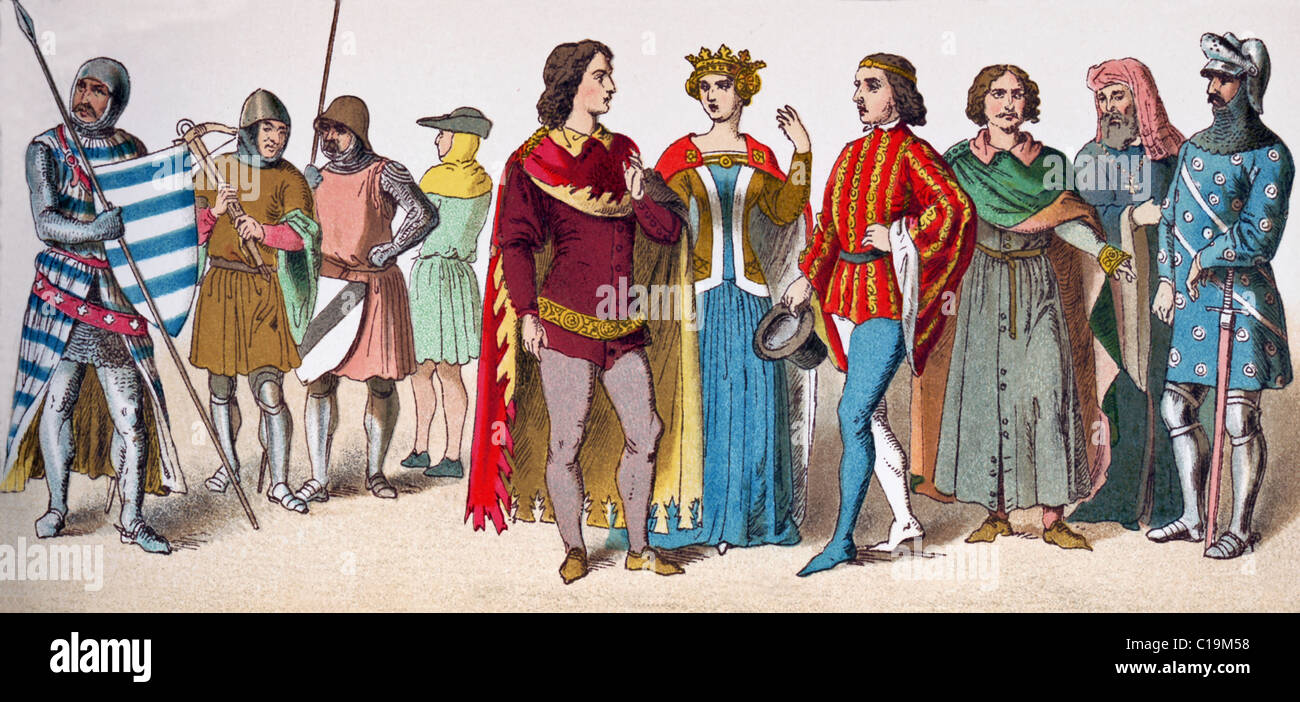 The figures represented here are English people between A.D. 1300 and 1400. Stock Photohttps://www.alamy.com/image-license-details/?v=1https://www.alamy.com/stock-photo-the-figures-represented-here-are-english-people-between-ad-1300-and-35248788.html
The figures represented here are English people between A.D. 1300 and 1400. Stock Photohttps://www.alamy.com/image-license-details/?v=1https://www.alamy.com/stock-photo-the-figures-represented-here-are-english-people-between-ad-1300-and-35248788.htmlRFC19M58–The figures represented here are English people between A.D. 1300 and 1400.
 Anthony Woodville and William Caxton presenting the first printed book in English to Edward IV, 15th century Stock Photohttps://www.alamy.com/image-license-details/?v=1https://www.alamy.com/stock-photo-anthony-woodville-and-william-caxton-presenting-the-first-printed-106428945.html
Anthony Woodville and William Caxton presenting the first printed book in English to Edward IV, 15th century Stock Photohttps://www.alamy.com/image-license-details/?v=1https://www.alamy.com/stock-photo-anthony-woodville-and-william-caxton-presenting-the-first-printed-106428945.htmlRMG5475N–Anthony Woodville and William Caxton presenting the first printed book in English to Edward IV, 15th century
![Pageant VII. Richard Beauchamp, Earl of Warwick, fighting with Henry IV against Henry Percy at the Battle of Shrewsbury, 21 July 1403. Beauchamp Pageants. S. Netherlands [Bruges?]; after 1483. . Source: Cotton Julius E. IV, art. 6, f.4. Language: English. Stock Photo Pageant VII. Richard Beauchamp, Earl of Warwick, fighting with Henry IV against Henry Percy at the Battle of Shrewsbury, 21 July 1403. Beauchamp Pageants. S. Netherlands [Bruges?]; after 1483. . Source: Cotton Julius E. IV, art. 6, f.4. Language: English. Stock Photo](https://c8.alamy.com/comp/R54EWC/pageant-vii-richard-beauchamp-earl-of-warwick-fighting-with-henry-iv-against-henry-percy-at-the-battle-of-shrewsbury-21-july-1403-beauchamp-pageants-s-netherlands-bruges-after-1483-source-cotton-julius-e-iv-art-6-f4-language-english-R54EWC.jpg) Pageant VII. Richard Beauchamp, Earl of Warwick, fighting with Henry IV against Henry Percy at the Battle of Shrewsbury, 21 July 1403. Beauchamp Pageants. S. Netherlands [Bruges?]; after 1483. . Source: Cotton Julius E. IV, art. 6, f.4. Language: English. Stock Photohttps://www.alamy.com/image-license-details/?v=1https://www.alamy.com/pageant-vii-richard-beauchamp-earl-of-warwick-fighting-with-henry-iv-against-henry-percy-at-the-battle-of-shrewsbury-21-july-1403-beauchamp-pageants-s-netherlands-bruges-after-1483-source-cotton-julius-e-iv-art-6-f4-language-english-image226907560.html
Pageant VII. Richard Beauchamp, Earl of Warwick, fighting with Henry IV against Henry Percy at the Battle of Shrewsbury, 21 July 1403. Beauchamp Pageants. S. Netherlands [Bruges?]; after 1483. . Source: Cotton Julius E. IV, art. 6, f.4. Language: English. Stock Photohttps://www.alamy.com/image-license-details/?v=1https://www.alamy.com/pageant-vii-richard-beauchamp-earl-of-warwick-fighting-with-henry-iv-against-henry-percy-at-the-battle-of-shrewsbury-21-july-1403-beauchamp-pageants-s-netherlands-bruges-after-1483-source-cotton-julius-e-iv-art-6-f4-language-english-image226907560.htmlRMR54EWC–Pageant VII. Richard Beauchamp, Earl of Warwick, fighting with Henry IV against Henry Percy at the Battle of Shrewsbury, 21 July 1403. Beauchamp Pageants. S. Netherlands [Bruges?]; after 1483. . Source: Cotton Julius E. IV, art. 6, f.4. Language: English.
 A generic engraving of a medieval castle in the forest with a large empty scroll suitable for text Stock Photohttps://www.alamy.com/image-license-details/?v=1https://www.alamy.com/a-generic-engraving-of-a-medieval-castle-in-the-forest-with-a-large-empty-scroll-suitable-for-text-image610857796.html
A generic engraving of a medieval castle in the forest with a large empty scroll suitable for text Stock Photohttps://www.alamy.com/image-license-details/?v=1https://www.alamy.com/a-generic-engraving-of-a-medieval-castle-in-the-forest-with-a-large-empty-scroll-suitable-for-text-image610857796.htmlRM2XDPY9T–A generic engraving of a medieval castle in the forest with a large empty scroll suitable for text
 Cloaks, tunics and shoes that make up everyday Saxon attire in 9th Century England. Stock Photohttps://www.alamy.com/image-license-details/?v=1https://www.alamy.com/stock-image-cloaks-tunics-and-shoes-that-make-up-everyday-saxon-attire-in-9th-165794181.html
Cloaks, tunics and shoes that make up everyday Saxon attire in 9th Century England. Stock Photohttps://www.alamy.com/image-license-details/?v=1https://www.alamy.com/stock-image-cloaks-tunics-and-shoes-that-make-up-everyday-saxon-attire-in-9th-165794181.htmlRMKHMG4N–Cloaks, tunics and shoes that make up everyday Saxon attire in 9th Century England.
 Costume of Dutch and English nobles, 1586. Poet and courtier Sir Philip Sidney, Governor of Flushing 124, Otto van Bylandt 125, Robert Devereux, 2nd Earl of Essex 126, Willem van Zuijlen van Nijevelt 127, Sir William Russell, 1st Baron Russell of Thornhaugh 128 and Gerrit van Poelgeest 129. Handcoloured lithograph by Pieter Willem Marius Trap after an illustration by Gerardus Johannes Bos in Maskerade, Leiden 1870, (Masquerade by Leiden Students 1870), a historical re-enactment of the visit by Robert Lord Dudley, Baron von Denbigh, Earl of Leicester, and others to Leiden University in 1586, pu Stock Photohttps://www.alamy.com/image-license-details/?v=1https://www.alamy.com/costume-of-dutch-and-english-nobles-1586-poet-and-courtier-sir-philip-sidney-governor-of-flushing-124-otto-van-bylandt-125-robert-devereux-2nd-earl-of-essex-126-willem-van-zuijlen-van-nijevelt-127-sir-william-russell-1st-baron-russell-of-thornhaugh-128-and-gerrit-van-poelgeest-129-handcoloured-lithograph-by-pieter-willem-marius-trap-after-an-illustration-by-gerardus-johannes-bos-in-maskerade-leiden-1870-masquerade-by-leiden-students-1870-a-historical-re-enactment-of-the-visit-by-robert-lord-dudley-baron-von-denbigh-earl-of-leicester-and-others-to-leiden-university-in-1586-pu-image595202088.html
Costume of Dutch and English nobles, 1586. Poet and courtier Sir Philip Sidney, Governor of Flushing 124, Otto van Bylandt 125, Robert Devereux, 2nd Earl of Essex 126, Willem van Zuijlen van Nijevelt 127, Sir William Russell, 1st Baron Russell of Thornhaugh 128 and Gerrit van Poelgeest 129. Handcoloured lithograph by Pieter Willem Marius Trap after an illustration by Gerardus Johannes Bos in Maskerade, Leiden 1870, (Masquerade by Leiden Students 1870), a historical re-enactment of the visit by Robert Lord Dudley, Baron von Denbigh, Earl of Leicester, and others to Leiden University in 1586, pu Stock Photohttps://www.alamy.com/image-license-details/?v=1https://www.alamy.com/costume-of-dutch-and-english-nobles-1586-poet-and-courtier-sir-philip-sidney-governor-of-flushing-124-otto-van-bylandt-125-robert-devereux-2nd-earl-of-essex-126-willem-van-zuijlen-van-nijevelt-127-sir-william-russell-1st-baron-russell-of-thornhaugh-128-and-gerrit-van-poelgeest-129-handcoloured-lithograph-by-pieter-willem-marius-trap-after-an-illustration-by-gerardus-johannes-bos-in-maskerade-leiden-1870-masquerade-by-leiden-students-1870-a-historical-re-enactment-of-the-visit-by-robert-lord-dudley-baron-von-denbigh-earl-of-leicester-and-others-to-leiden-university-in-1586-pu-image595202088.htmlRM2WG9P9C–Costume of Dutch and English nobles, 1586. Poet and courtier Sir Philip Sidney, Governor of Flushing 124, Otto van Bylandt 125, Robert Devereux, 2nd Earl of Essex 126, Willem van Zuijlen van Nijevelt 127, Sir William Russell, 1st Baron Russell of Thornhaugh 128 and Gerrit van Poelgeest 129. Handcoloured lithograph by Pieter Willem Marius Trap after an illustration by Gerardus Johannes Bos in Maskerade, Leiden 1870, (Masquerade by Leiden Students 1870), a historical re-enactment of the visit by Robert Lord Dudley, Baron von Denbigh, Earl of Leicester, and others to Leiden University in 1586, pu
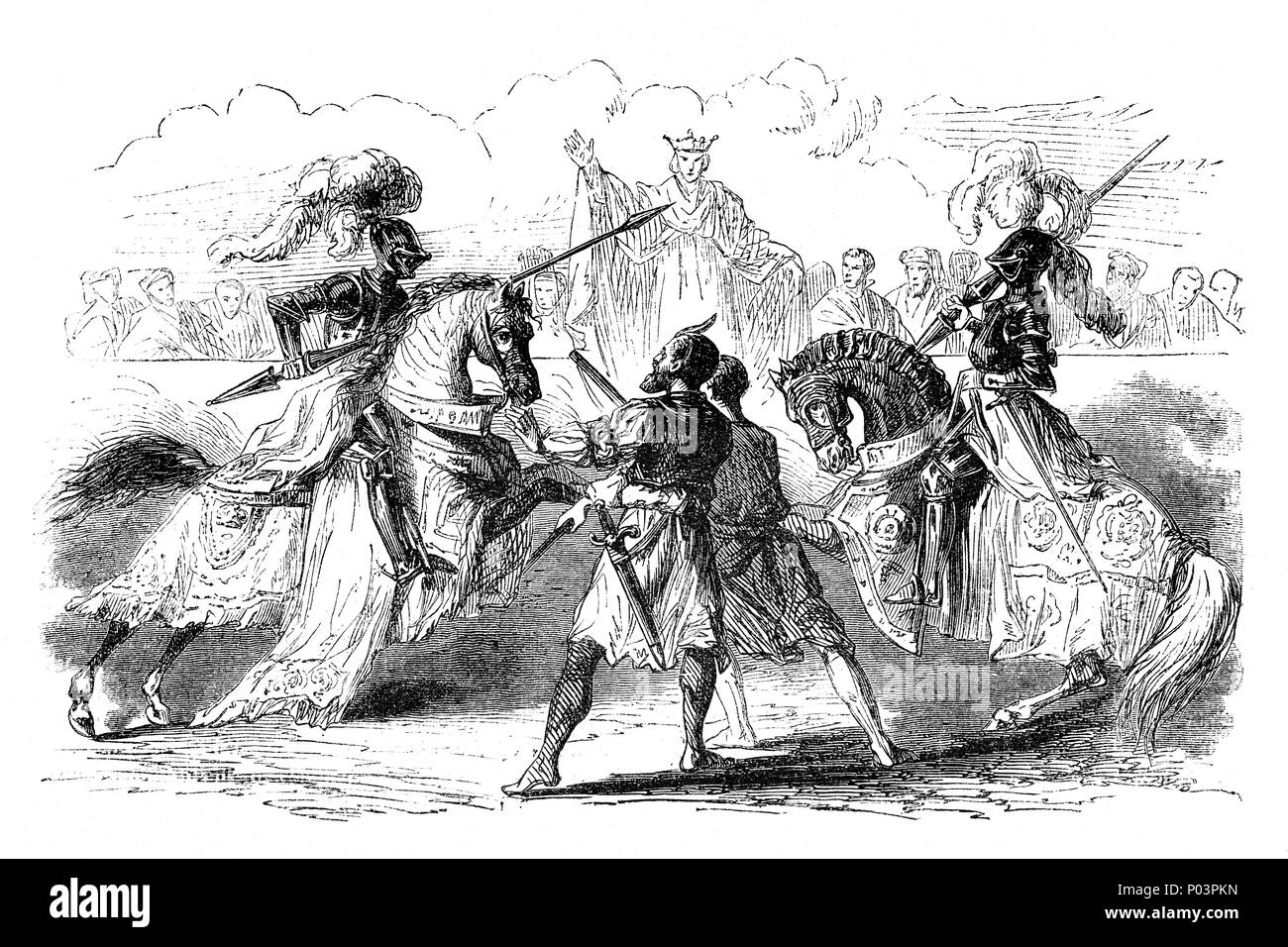 Discord broke out in the inner circles of court in December 1397, when Henry Bolingbroke, Earl of Derby, and Thomas de Mowbray, Earl of Nottingham, became embroiled in a quarrel. According to Bolingbroke, Mowbray had claimed that the two, as former Lords Appellant, were next in line for royal retribution. Mowbray denied these charges, as such a claim would have amounted to treason. A parliamentary committee decided that the two should settle the matter by battle, but at the last moment Richard stopped the duel and exiled the two dukes instead: Mowbray for life, Bolingbroke for ten years. Stock Photohttps://www.alamy.com/image-license-details/?v=1https://www.alamy.com/discord-broke-out-in-the-inner-circles-of-court-in-december-1397-when-henry-bolingbroke-earl-of-derby-and-thomas-de-mowbray-earl-of-nottingham-became-embroiled-in-a-quarrel-according-to-bolingbroke-mowbray-had-claimed-that-the-two-as-former-lords-appellant-were-next-in-line-for-royal-retribution-mowbray-denied-these-charges-as-such-a-claim-would-have-amounted-to-treason-a-parliamentary-committee-decided-that-the-two-should-settle-the-matter-by-battle-but-at-the-last-moment-richard-stopped-the-duel-and-exiled-the-two-dukes-instead-mowbray-for-life-bolingbroke-for-ten-years-image206608073.html
Discord broke out in the inner circles of court in December 1397, when Henry Bolingbroke, Earl of Derby, and Thomas de Mowbray, Earl of Nottingham, became embroiled in a quarrel. According to Bolingbroke, Mowbray had claimed that the two, as former Lords Appellant, were next in line for royal retribution. Mowbray denied these charges, as such a claim would have amounted to treason. A parliamentary committee decided that the two should settle the matter by battle, but at the last moment Richard stopped the duel and exiled the two dukes instead: Mowbray for life, Bolingbroke for ten years. Stock Photohttps://www.alamy.com/image-license-details/?v=1https://www.alamy.com/discord-broke-out-in-the-inner-circles-of-court-in-december-1397-when-henry-bolingbroke-earl-of-derby-and-thomas-de-mowbray-earl-of-nottingham-became-embroiled-in-a-quarrel-according-to-bolingbroke-mowbray-had-claimed-that-the-two-as-former-lords-appellant-were-next-in-line-for-royal-retribution-mowbray-denied-these-charges-as-such-a-claim-would-have-amounted-to-treason-a-parliamentary-committee-decided-that-the-two-should-settle-the-matter-by-battle-but-at-the-last-moment-richard-stopped-the-duel-and-exiled-the-two-dukes-instead-mowbray-for-life-bolingbroke-for-ten-years-image206608073.htmlRMP03PKN–Discord broke out in the inner circles of court in December 1397, when Henry Bolingbroke, Earl of Derby, and Thomas de Mowbray, Earl of Nottingham, became embroiled in a quarrel. According to Bolingbroke, Mowbray had claimed that the two, as former Lords Appellant, were next in line for royal retribution. Mowbray denied these charges, as such a claim would have amounted to treason. A parliamentary committee decided that the two should settle the matter by battle, but at the last moment Richard stopped the duel and exiled the two dukes instead: Mowbray for life, Bolingbroke for ten years.
![Infographic of the structure and life in a castle during the medieval era in western Europe. [Adobe InDesign (.indd); 5078x3248]. Stock Photo Infographic of the structure and life in a castle during the medieval era in western Europe. [Adobe InDesign (.indd); 5078x3248]. Stock Photo](https://c8.alamy.com/comp/2NEBHWB/infographic-of-the-structure-and-life-in-a-castle-during-the-medieval-era-in-western-europe-adobe-indesign-indd-5078x3248-2NEBHWB.jpg) Infographic of the structure and life in a castle during the medieval era in western Europe. [Adobe InDesign (.indd); 5078x3248]. Stock Photohttps://www.alamy.com/image-license-details/?v=1https://www.alamy.com/infographic-of-the-structure-and-life-in-a-castle-during-the-medieval-era-in-western-europe-adobe-indesign-indd-5078x3248-image525171735.html
Infographic of the structure and life in a castle during the medieval era in western Europe. [Adobe InDesign (.indd); 5078x3248]. Stock Photohttps://www.alamy.com/image-license-details/?v=1https://www.alamy.com/infographic-of-the-structure-and-life-in-a-castle-during-the-medieval-era-in-western-europe-adobe-indesign-indd-5078x3248-image525171735.htmlRM2NEBHWB–Infographic of the structure and life in a castle during the medieval era in western Europe. [Adobe InDesign (.indd); 5078x3248].
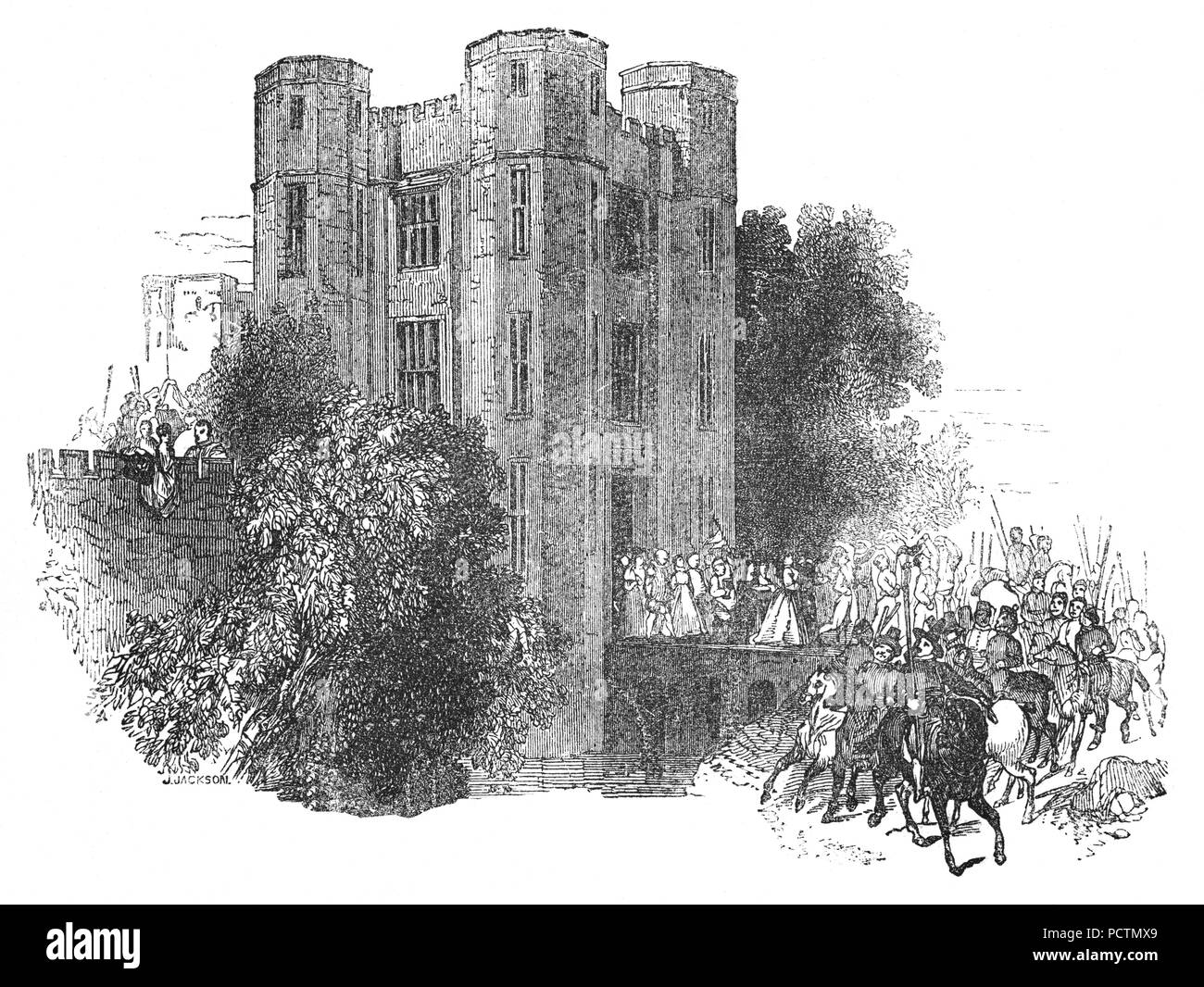 Kenilworth Castle in Warwickshire, England was restored by Robert, Earl of Leicester, in 1563, who continued his father's modernisation of Kenilworth. He was keen to impress Elizabeth to convince her to marry him, and no expense was spared. Elizabeth brought an entourage of thirty-one barons and four hundred staff for the royal visit that lasted an exceptional nineteen days with pageants, fireworks, bear baiting, mystery plays, hunting and lavish banquets. The event was considered a huge success yet the queen did not decide to marry Leicester. Stock Photohttps://www.alamy.com/image-license-details/?v=1https://www.alamy.com/kenilworth-castle-in-warwickshire-england-was-restored-by-robert-earl-of-leicester-in-1563-who-continued-his-fathers-modernisation-of-kenilworth-he-was-keen-to-impress-elizabeth-to-convince-her-to-marry-him-and-no-expense-was-spared-elizabeth-brought-an-entourage-of-thirty-one-barons-and-four-hundred-staff-for-the-royal-visit-that-lasted-an-exceptional-nineteen-days-with-pageants-fireworks-bear-baiting-mystery-plays-hunting-and-lavish-banquets-the-event-was-considered-a-huge-success-yet-the-queen-did-not-decide-to-marry-leicester-image214443553.html
Kenilworth Castle in Warwickshire, England was restored by Robert, Earl of Leicester, in 1563, who continued his father's modernisation of Kenilworth. He was keen to impress Elizabeth to convince her to marry him, and no expense was spared. Elizabeth brought an entourage of thirty-one barons and four hundred staff for the royal visit that lasted an exceptional nineteen days with pageants, fireworks, bear baiting, mystery plays, hunting and lavish banquets. The event was considered a huge success yet the queen did not decide to marry Leicester. Stock Photohttps://www.alamy.com/image-license-details/?v=1https://www.alamy.com/kenilworth-castle-in-warwickshire-england-was-restored-by-robert-earl-of-leicester-in-1563-who-continued-his-fathers-modernisation-of-kenilworth-he-was-keen-to-impress-elizabeth-to-convince-her-to-marry-him-and-no-expense-was-spared-elizabeth-brought-an-entourage-of-thirty-one-barons-and-four-hundred-staff-for-the-royal-visit-that-lasted-an-exceptional-nineteen-days-with-pageants-fireworks-bear-baiting-mystery-plays-hunting-and-lavish-banquets-the-event-was-considered-a-huge-success-yet-the-queen-did-not-decide-to-marry-leicester-image214443553.htmlRMPCTMX9–Kenilworth Castle in Warwickshire, England was restored by Robert, Earl of Leicester, in 1563, who continued his father's modernisation of Kenilworth. He was keen to impress Elizabeth to convince her to marry him, and no expense was spared. Elizabeth brought an entourage of thirty-one barons and four hundred staff for the royal visit that lasted an exceptional nineteen days with pageants, fireworks, bear baiting, mystery plays, hunting and lavish banquets. The event was considered a huge success yet the queen did not decide to marry Leicester.
 11th century calendar: Hawking in October. 19th century reproduction. Stock Photohttps://www.alamy.com/image-license-details/?v=1https://www.alamy.com/stock-photo-11th-century-calendar-hawking-in-october-19th-century-reproduction-83343660.html
11th century calendar: Hawking in October. 19th century reproduction. Stock Photohttps://www.alamy.com/image-license-details/?v=1https://www.alamy.com/stock-photo-11th-century-calendar-hawking-in-october-19th-century-reproduction-83343660.htmlRMERGHK8–11th century calendar: Hawking in October. 19th century reproduction.
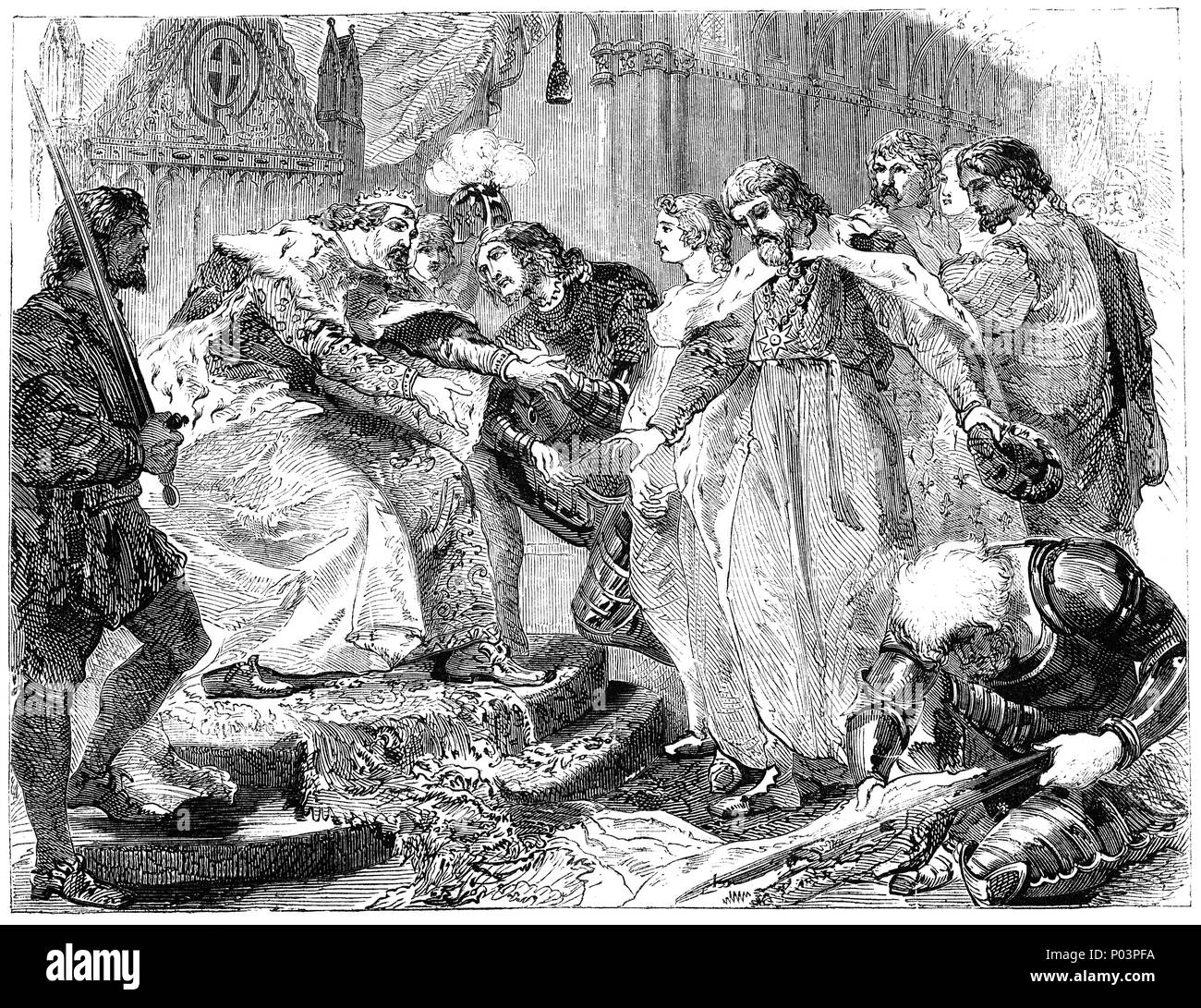 Edward of Woodstock (1330-1376), commanded the vanguard at the Battle of Crécy, in 1346. He was named the Black Prince after the battle of Crécy, at which he was possibly accoutred in black armour. In 1356 he ravaged Auvergne, Limousin, and Berry but failed to take Bourges. He presented King John II of France to his father (Edward III), and offered terms of peace terms, but John refused to surrender himself as the price of their acceptance. This led to the Battle of Poitiers where Prince Edward's army routed the French and took King John prisoner. Stock Photohttps://www.alamy.com/image-license-details/?v=1https://www.alamy.com/edward-of-woodstock-1330-1376-commanded-the-vanguard-at-the-battle-of-crcy-in-1346-he-was-named-the-black-prince-after-the-battle-of-crcy-at-which-he-was-possibly-accoutred-in-black-armour-in-1356-he-ravaged-auvergne-limousin-and-berry-but-failed-to-take-bourges-he-presented-king-john-ii-of-france-to-his-father-edward-iii-and-offered-terms-of-peace-terms-but-john-refused-to-surrender-himself-as-the-price-of-their-acceptance-this-led-to-the-battle-of-poitiers-where-prince-edwards-army-routed-the-french-and-took-king-john-prisoner-image206607950.html
Edward of Woodstock (1330-1376), commanded the vanguard at the Battle of Crécy, in 1346. He was named the Black Prince after the battle of Crécy, at which he was possibly accoutred in black armour. In 1356 he ravaged Auvergne, Limousin, and Berry but failed to take Bourges. He presented King John II of France to his father (Edward III), and offered terms of peace terms, but John refused to surrender himself as the price of their acceptance. This led to the Battle of Poitiers where Prince Edward's army routed the French and took King John prisoner. Stock Photohttps://www.alamy.com/image-license-details/?v=1https://www.alamy.com/edward-of-woodstock-1330-1376-commanded-the-vanguard-at-the-battle-of-crcy-in-1346-he-was-named-the-black-prince-after-the-battle-of-crcy-at-which-he-was-possibly-accoutred-in-black-armour-in-1356-he-ravaged-auvergne-limousin-and-berry-but-failed-to-take-bourges-he-presented-king-john-ii-of-france-to-his-father-edward-iii-and-offered-terms-of-peace-terms-but-john-refused-to-surrender-himself-as-the-price-of-their-acceptance-this-led-to-the-battle-of-poitiers-where-prince-edwards-army-routed-the-french-and-took-king-john-prisoner-image206607950.htmlRMP03PFA–Edward of Woodstock (1330-1376), commanded the vanguard at the Battle of Crécy, in 1346. He was named the Black Prince after the battle of Crécy, at which he was possibly accoutred in black armour. In 1356 he ravaged Auvergne, Limousin, and Berry but failed to take Bourges. He presented King John II of France to his father (Edward III), and offered terms of peace terms, but John refused to surrender himself as the price of their acceptance. This led to the Battle of Poitiers where Prince Edward's army routed the French and took King John prisoner.
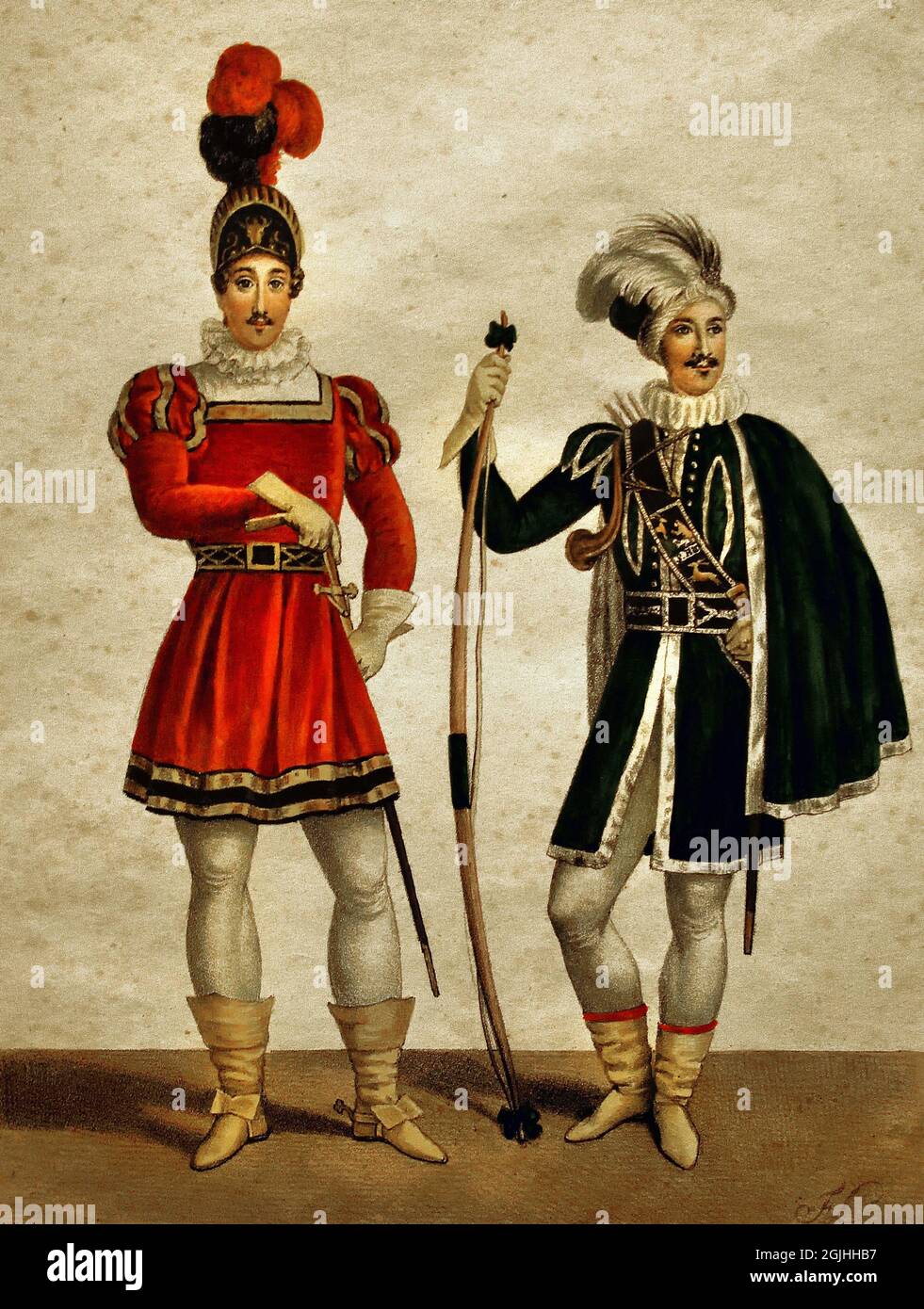 Ivanhoe's costumes at the ball given by The Prince and Princess of Orange in Brussels, Wednesday February 5, 1823. Brussels, 1823. artist. Belgium, Belgian, Stock Photohttps://www.alamy.com/image-license-details/?v=1https://www.alamy.com/ivanhoes-costumes-at-the-ball-given-by-the-prince-and-princess-of-orange-in-brussels-wednesday-february-5-1823-brussels-1823-artist-belgium-belgian-image441709835.html
Ivanhoe's costumes at the ball given by The Prince and Princess of Orange in Brussels, Wednesday February 5, 1823. Brussels, 1823. artist. Belgium, Belgian, Stock Photohttps://www.alamy.com/image-license-details/?v=1https://www.alamy.com/ivanhoes-costumes-at-the-ball-given-by-the-prince-and-princess-of-orange-in-brussels-wednesday-february-5-1823-brussels-1823-artist-belgium-belgian-image441709835.htmlRM2GJHHB7–Ivanhoe's costumes at the ball given by The Prince and Princess of Orange in Brussels, Wednesday February 5, 1823. Brussels, 1823. artist. Belgium, Belgian,
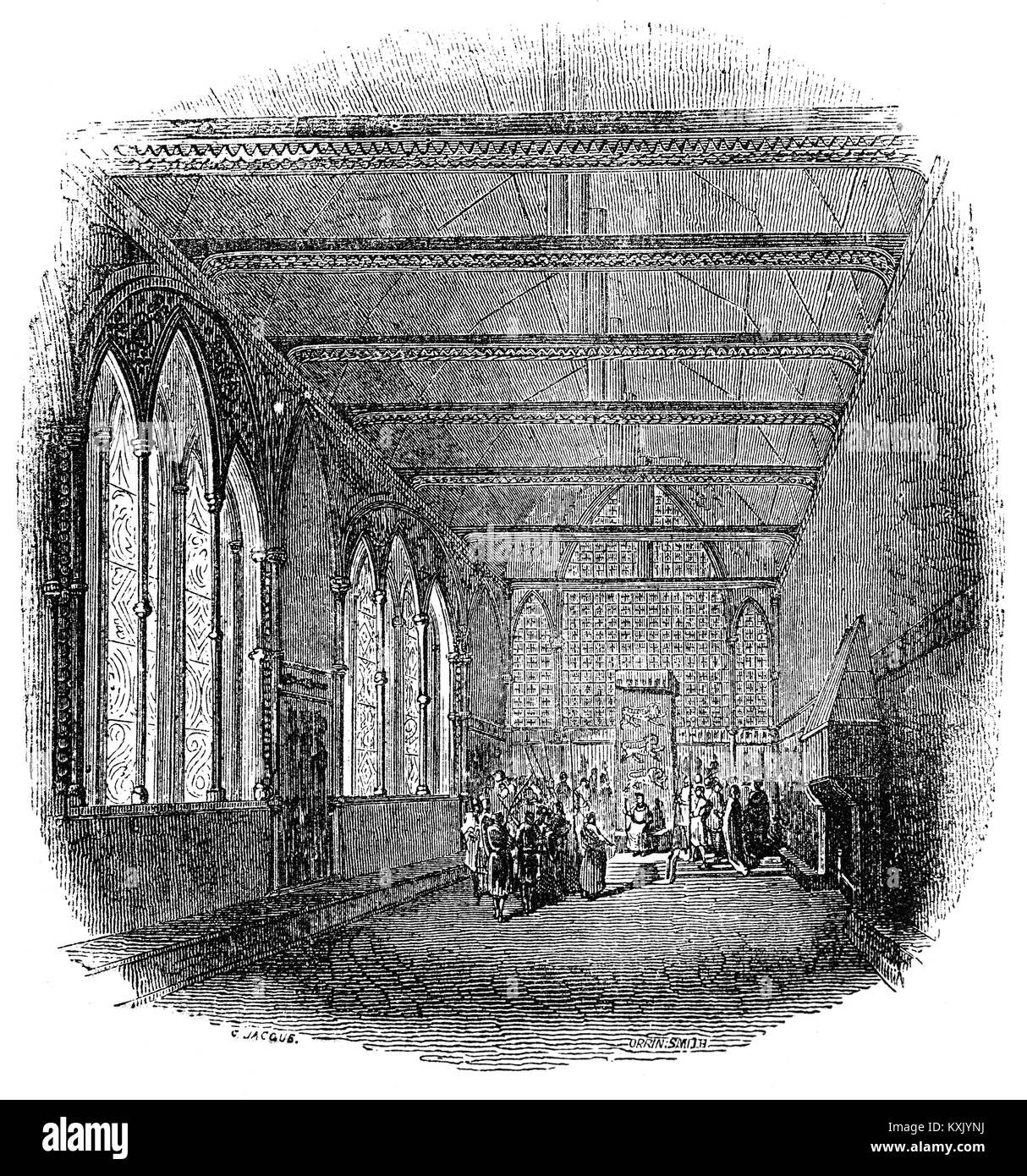 King John attending meetings in his room of state at Windsor Castle, Berkshire, England in the early 13th Century. Stock Photohttps://www.alamy.com/image-license-details/?v=1https://www.alamy.com/stock-photo-king-john-attending-meetings-in-his-room-of-state-at-windsor-castle-171291278.html
King John attending meetings in his room of state at Windsor Castle, Berkshire, England in the early 13th Century. Stock Photohttps://www.alamy.com/image-license-details/?v=1https://www.alamy.com/stock-photo-king-john-attending-meetings-in-his-room-of-state-at-windsor-castle-171291278.htmlRMKXJYNJ–King John attending meetings in his room of state at Windsor Castle, Berkshire, England in the early 13th Century.
 UK, Derbyshire, Tideswell, church Bower Chapel, effigies of Sir Thurstan and Lady Margaret de Bower Stock Photohttps://www.alamy.com/image-license-details/?v=1https://www.alamy.com/stock-photo-uk-derbyshire-tideswell-church-bower-chapel-effigies-of-sir-thurstan-84586830.html
UK, Derbyshire, Tideswell, church Bower Chapel, effigies of Sir Thurstan and Lady Margaret de Bower Stock Photohttps://www.alamy.com/image-license-details/?v=1https://www.alamy.com/stock-photo-uk-derbyshire-tideswell-church-bower-chapel-effigies-of-sir-thurstan-84586830.htmlRMEWH7A6–UK, Derbyshire, Tideswell, church Bower Chapel, effigies of Sir Thurstan and Lady Margaret de Bower
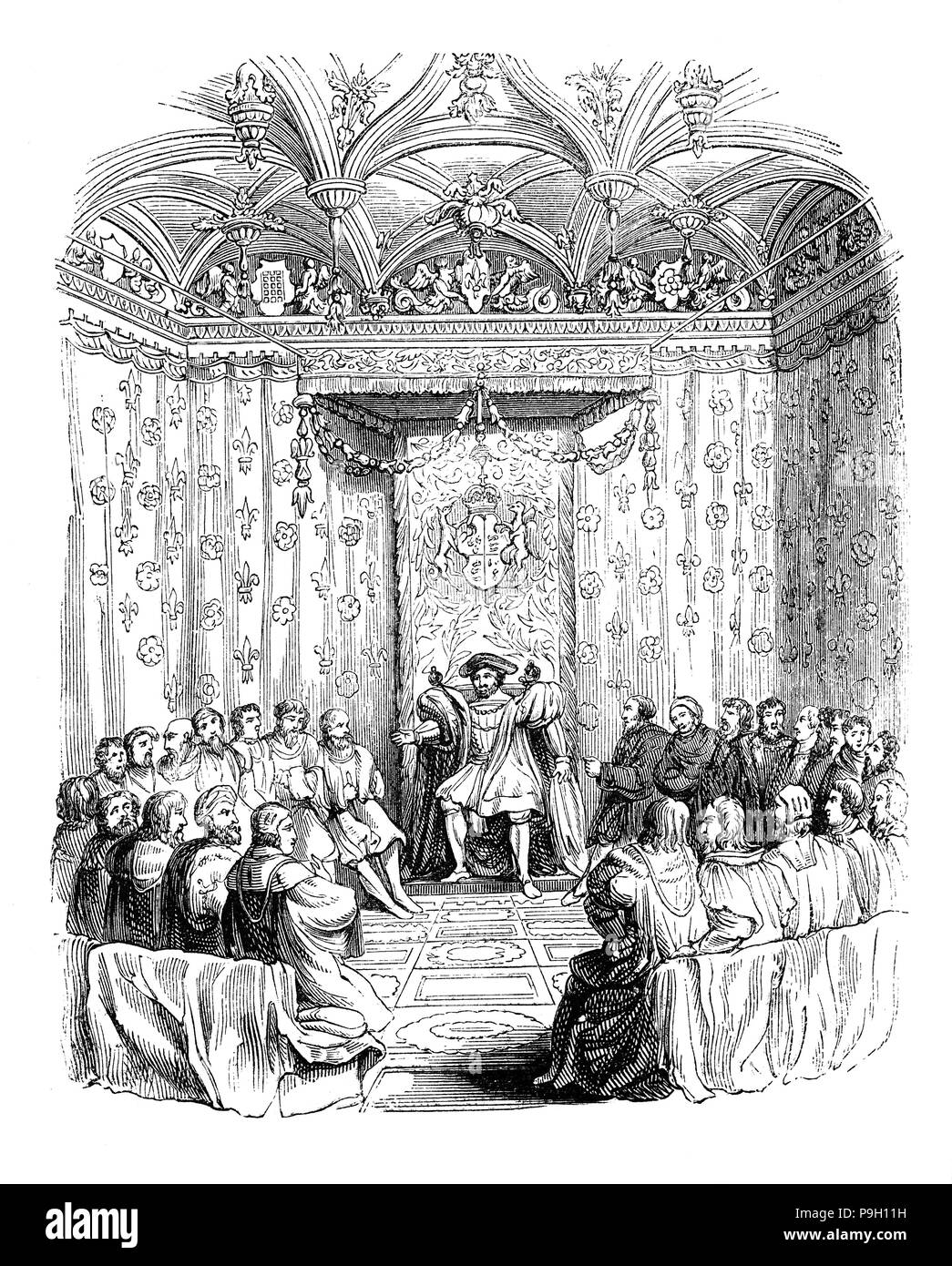 King Henry VIII at a meeting of the Privy Council, a group of men who were advisers to the King. It included a variety of men including those from the religious sector to very important state offices. After 1540 the 19 members of the Privy Council worked together as a board having letters and warrants signed collectively by them. They sat virtually every day and within it Court and State became as one, for the Privy Council met almost exclusively at Court after the reconstructions of 1536-7 and 1540. It also sat judicially as the Court of Star Chamber on Wednesdays and Fridays. Stock Photohttps://www.alamy.com/image-license-details/?v=1https://www.alamy.com/king-henry-viii-at-a-meeting-of-the-privy-council-a-group-of-men-who-were-advisers-to-the-king-it-included-a-variety-of-men-including-those-from-the-religious-sector-to-very-important-state-offices-after-1540-the-19-members-of-the-privy-council-worked-together-as-a-board-having-letters-and-warrants-signed-collectively-by-them-they-sat-virtually-every-day-and-within-it-court-and-state-became-as-one-for-the-privy-council-met-almost-exclusively-at-court-after-the-reconstructions-of-1536-7-and-1540-it-also-sat-judicially-as-the-court-of-star-chamber-on-wednesdays-and-fridays-image212430333.html
King Henry VIII at a meeting of the Privy Council, a group of men who were advisers to the King. It included a variety of men including those from the religious sector to very important state offices. After 1540 the 19 members of the Privy Council worked together as a board having letters and warrants signed collectively by them. They sat virtually every day and within it Court and State became as one, for the Privy Council met almost exclusively at Court after the reconstructions of 1536-7 and 1540. It also sat judicially as the Court of Star Chamber on Wednesdays and Fridays. Stock Photohttps://www.alamy.com/image-license-details/?v=1https://www.alamy.com/king-henry-viii-at-a-meeting-of-the-privy-council-a-group-of-men-who-were-advisers-to-the-king-it-included-a-variety-of-men-including-those-from-the-religious-sector-to-very-important-state-offices-after-1540-the-19-members-of-the-privy-council-worked-together-as-a-board-having-letters-and-warrants-signed-collectively-by-them-they-sat-virtually-every-day-and-within-it-court-and-state-became-as-one-for-the-privy-council-met-almost-exclusively-at-court-after-the-reconstructions-of-1536-7-and-1540-it-also-sat-judicially-as-the-court-of-star-chamber-on-wednesdays-and-fridays-image212430333.htmlRMP9H11H–King Henry VIII at a meeting of the Privy Council, a group of men who were advisers to the King. It included a variety of men including those from the religious sector to very important state offices. After 1540 the 19 members of the Privy Council worked together as a board having letters and warrants signed collectively by them. They sat virtually every day and within it Court and State became as one, for the Privy Council met almost exclusively at Court after the reconstructions of 1536-7 and 1540. It also sat judicially as the Court of Star Chamber on Wednesdays and Fridays.
 Aerial view of Sychrov Castle, Czech Republic Stock Photohttps://www.alamy.com/image-license-details/?v=1https://www.alamy.com/aerial-view-of-sychrov-castle-czech-republic-image473946299.html
Aerial view of Sychrov Castle, Czech Republic Stock Photohttps://www.alamy.com/image-license-details/?v=1https://www.alamy.com/aerial-view-of-sychrov-castle-czech-republic-image473946299.htmlRF2JF239F–Aerial view of Sychrov Castle, Czech Republic
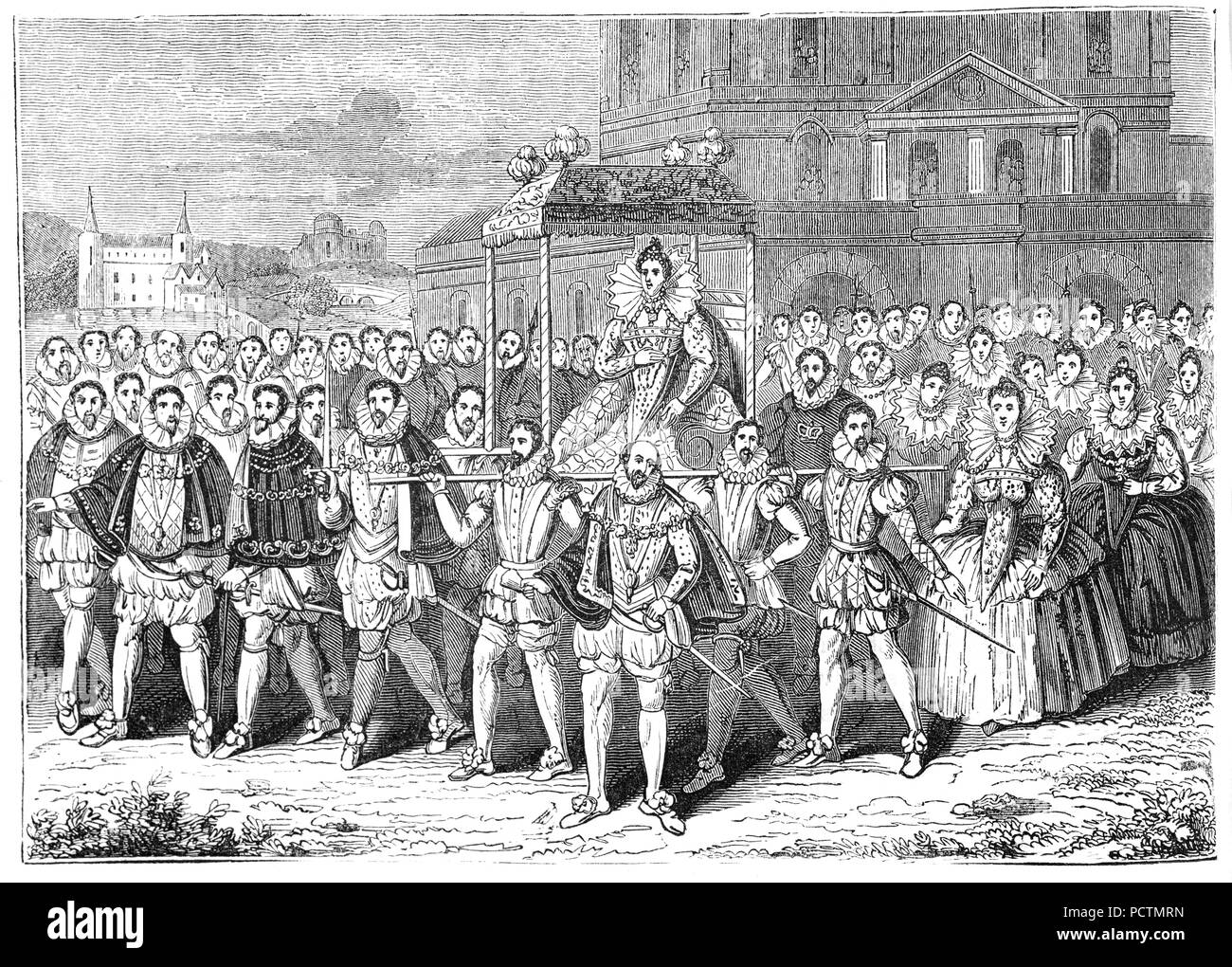 Elizabeth I (1533-1603), Queen of England and Ireland from 17 November 1558 until her death on 24 March 1603. Sometimes called The Virgin Queen, Gloriana or Good Queen Bess, Elizabeth was the last monarch of the House of Tudor. Surrounded by her court, wherever the Queen happened to be, it was made up of all those who surrounded the Queen from servants to the courtiers themselves. Once a year the Queen would go on a progress to the southern counties, but most of the time she resided in one of her great royal palaces. Stock Photohttps://www.alamy.com/image-license-details/?v=1https://www.alamy.com/elizabeth-i-1533-1603-queen-of-england-and-ireland-from-17-november-1558-until-her-death-on-24-march-1603-sometimes-called-the-virgin-queen-gloriana-or-good-queen-bess-elizabeth-was-the-last-monarch-of-the-house-of-tudor-surrounded-by-her-court-wherever-the-queen-happened-to-be-it-was-made-up-of-all-those-who-surrounded-the-queen-from-servants-to-the-courtiers-themselves-once-a-year-the-queen-would-go-on-a-progress-to-the-southern-counties-but-most-of-the-time-she-resided-in-one-of-her-great-royal-palaces-image214443481.html
Elizabeth I (1533-1603), Queen of England and Ireland from 17 November 1558 until her death on 24 March 1603. Sometimes called The Virgin Queen, Gloriana or Good Queen Bess, Elizabeth was the last monarch of the House of Tudor. Surrounded by her court, wherever the Queen happened to be, it was made up of all those who surrounded the Queen from servants to the courtiers themselves. Once a year the Queen would go on a progress to the southern counties, but most of the time she resided in one of her great royal palaces. Stock Photohttps://www.alamy.com/image-license-details/?v=1https://www.alamy.com/elizabeth-i-1533-1603-queen-of-england-and-ireland-from-17-november-1558-until-her-death-on-24-march-1603-sometimes-called-the-virgin-queen-gloriana-or-good-queen-bess-elizabeth-was-the-last-monarch-of-the-house-of-tudor-surrounded-by-her-court-wherever-the-queen-happened-to-be-it-was-made-up-of-all-those-who-surrounded-the-queen-from-servants-to-the-courtiers-themselves-once-a-year-the-queen-would-go-on-a-progress-to-the-southern-counties-but-most-of-the-time-she-resided-in-one-of-her-great-royal-palaces-image214443481.htmlRMPCTMRN–Elizabeth I (1533-1603), Queen of England and Ireland from 17 November 1558 until her death on 24 March 1603. Sometimes called The Virgin Queen, Gloriana or Good Queen Bess, Elizabeth was the last monarch of the House of Tudor. Surrounded by her court, wherever the Queen happened to be, it was made up of all those who surrounded the Queen from servants to the courtiers themselves. Once a year the Queen would go on a progress to the southern counties, but most of the time she resided in one of her great royal palaces.
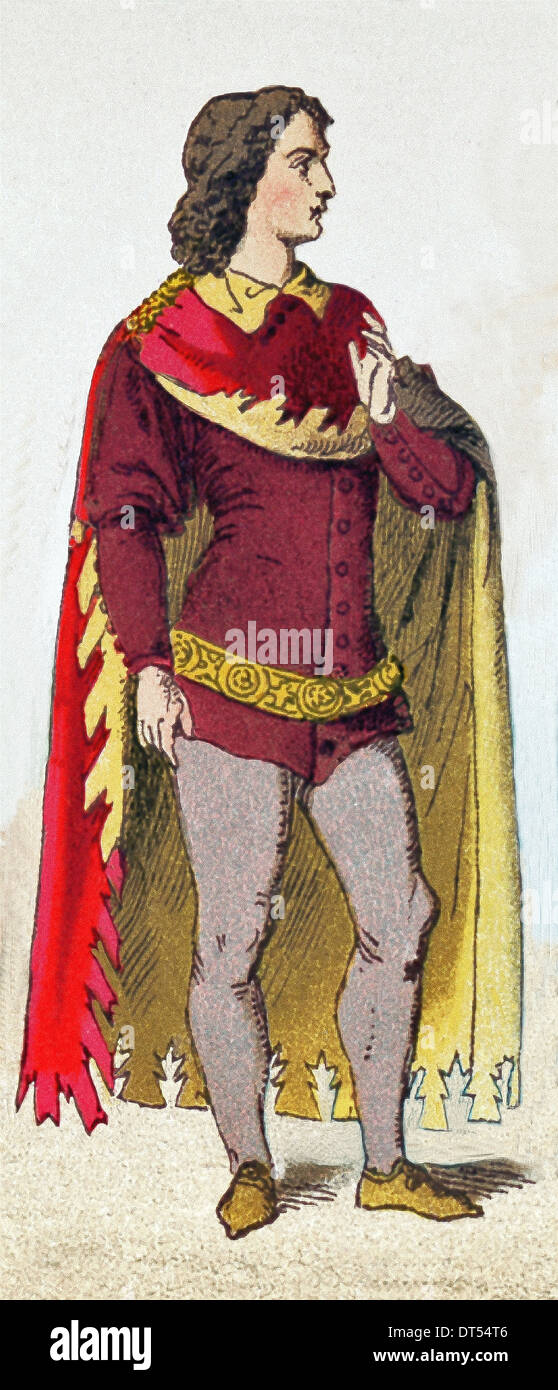 The figure represented is an Englishman between A.D. 1300 and 1400. The illustration dates to 1882. Stock Photohttps://www.alamy.com/image-license-details/?v=1https://www.alamy.com/the-figure-represented-is-an-englishman-between-ad-1300-and-1400-the-image66496422.html
The figure represented is an Englishman between A.D. 1300 and 1400. The illustration dates to 1882. Stock Photohttps://www.alamy.com/image-license-details/?v=1https://www.alamy.com/the-figure-represented-is-an-englishman-between-ad-1300-and-1400-the-image66496422.htmlRMDT54T6–The figure represented is an Englishman between A.D. 1300 and 1400. The illustration dates to 1882.
 Anthony Woodville and William Caxton presenting the first printed book in English to Edward IV, 15th century Stock Photohttps://www.alamy.com/image-license-details/?v=1https://www.alamy.com/stock-photo-anthony-woodville-and-william-caxton-presenting-the-first-printed-106428965.html
Anthony Woodville and William Caxton presenting the first printed book in English to Edward IV, 15th century Stock Photohttps://www.alamy.com/image-license-details/?v=1https://www.alamy.com/stock-photo-anthony-woodville-and-william-caxton-presenting-the-first-printed-106428965.htmlRMG5476D–Anthony Woodville and William Caxton presenting the first printed book in English to Edward IV, 15th century
 Sir William Gascoigne (1350-1419) was Chief Justice of England during the reign of King Henry IV when it is believed he committed the Prince of Wales (future Henry V) to prison. When the judge directed the punishment of one of the prince's riotous companions the prince was enraged at the sentence and grossly insulted the judge. Gascoigne immediately gave the prince a dressing-down and committed him to prison, and that caused him to acknowledge the justice of the sentence. Stock Photohttps://www.alamy.com/image-license-details/?v=1https://www.alamy.com/sir-william-gascoigne-1350-1419-was-chief-justice-of-england-during-the-reign-of-king-henry-iv-when-it-is-believed-he-committed-the-prince-of-wales-future-henry-v-to-prison-when-the-judge-directed-the-punishment-of-one-of-the-princes-riotous-companions-the-prince-was-enraged-at-the-sentence-and-grossly-insulted-the-judge-gascoigne-immediately-gave-the-prince-a-dressing-down-and-committed-him-to-prison-and-that-caused-him-to-acknowledge-the-justice-of-the-sentence-image207767547.html
Sir William Gascoigne (1350-1419) was Chief Justice of England during the reign of King Henry IV when it is believed he committed the Prince of Wales (future Henry V) to prison. When the judge directed the punishment of one of the prince's riotous companions the prince was enraged at the sentence and grossly insulted the judge. Gascoigne immediately gave the prince a dressing-down and committed him to prison, and that caused him to acknowledge the justice of the sentence. Stock Photohttps://www.alamy.com/image-license-details/?v=1https://www.alamy.com/sir-william-gascoigne-1350-1419-was-chief-justice-of-england-during-the-reign-of-king-henry-iv-when-it-is-believed-he-committed-the-prince-of-wales-future-henry-v-to-prison-when-the-judge-directed-the-punishment-of-one-of-the-princes-riotous-companions-the-prince-was-enraged-at-the-sentence-and-grossly-insulted-the-judge-gascoigne-immediately-gave-the-prince-a-dressing-down-and-committed-him-to-prison-and-that-caused-him-to-acknowledge-the-justice-of-the-sentence-image207767547.htmlRMP20HHF–Sir William Gascoigne (1350-1419) was Chief Justice of England during the reign of King Henry IV when it is believed he committed the Prince of Wales (future Henry V) to prison. When the judge directed the punishment of one of the prince's riotous companions the prince was enraged at the sentence and grossly insulted the judge. Gascoigne immediately gave the prince a dressing-down and committed him to prison, and that caused him to acknowledge the justice of the sentence.
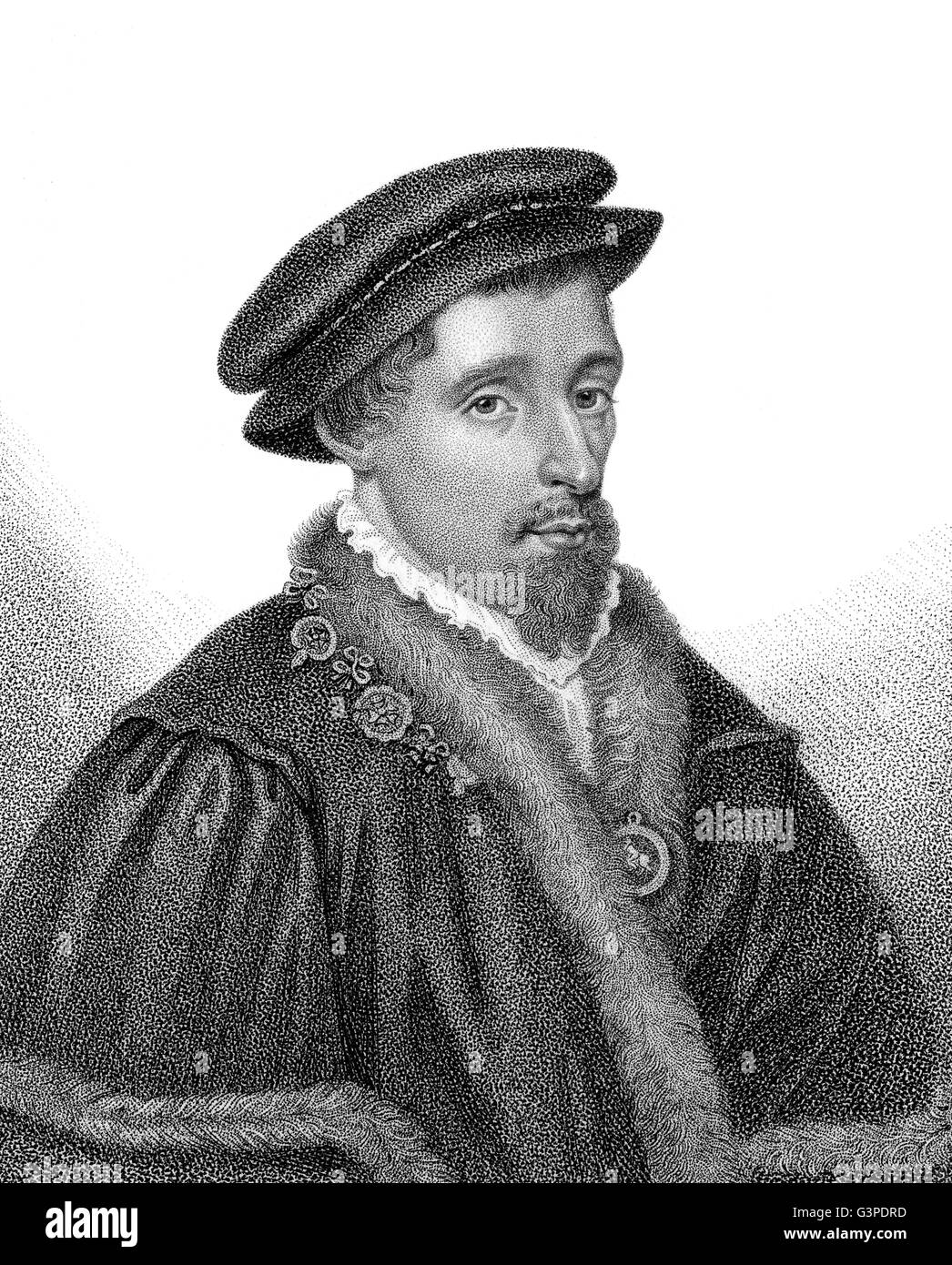 Henry Howard, Earl of Surrey, 1516 - 1547, an English poet Stock Photohttps://www.alamy.com/image-license-details/?v=1https://www.alamy.com/stock-photo-henry-howard-earl-of-surrey-1516-1547-an-english-poet-105599969.html
Henry Howard, Earl of Surrey, 1516 - 1547, an English poet Stock Photohttps://www.alamy.com/image-license-details/?v=1https://www.alamy.com/stock-photo-henry-howard-earl-of-surrey-1516-1547-an-english-poet-105599969.htmlRMG3PDRD–Henry Howard, Earl of Surrey, 1516 - 1547, an English poet
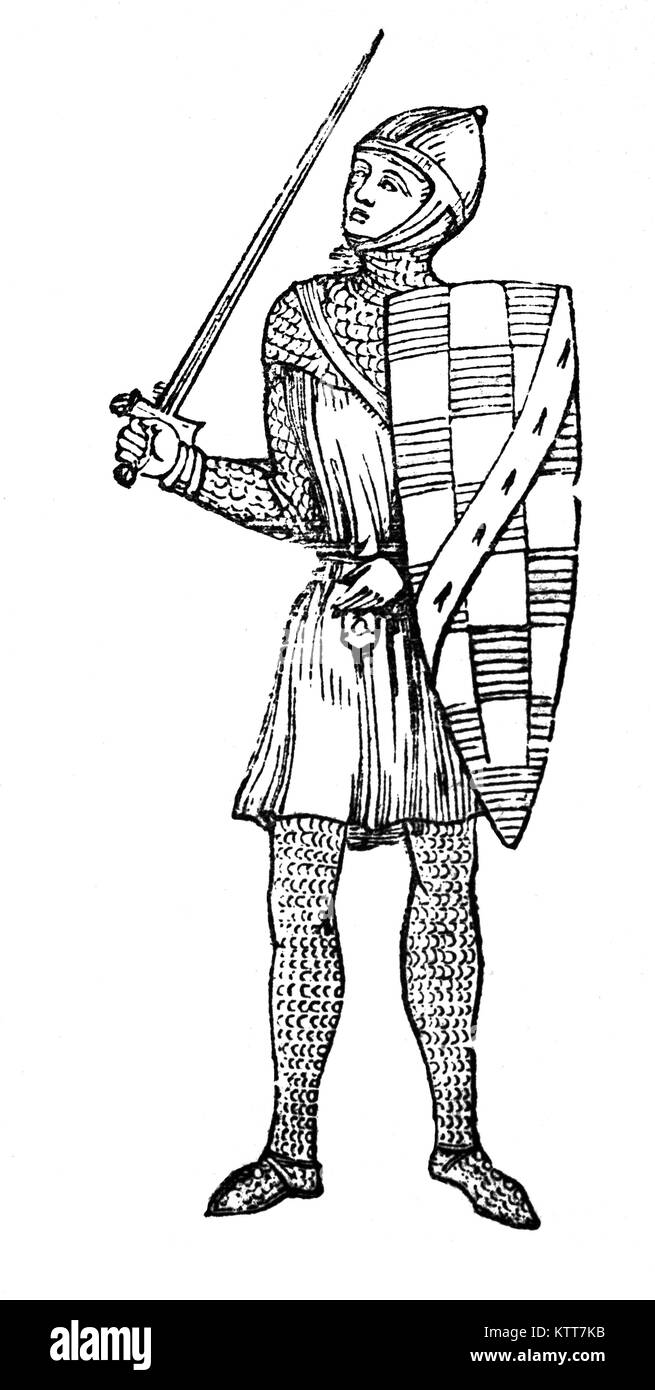 Guy de Beauchamp, 10th Earl of Warwick (c. 1272 – 1315) was a wealth Englishman and one of the principal opponents of King Edward II and his favourite, Piers Gaveston. He distinguished himself at the Battle of Falkirk and served under under King Edward I. After the succession of Edward II in 1307, he fell out with the new king and was one of the main architects behind the Ordinances of 1311, that limited the powers of the king. Stock Photohttps://www.alamy.com/image-license-details/?v=1https://www.alamy.com/stock-photo-guy-de-beauchamp-10th-earl-of-warwick-c-1272-1315-was-a-wealth-englishman-170177935.html
Guy de Beauchamp, 10th Earl of Warwick (c. 1272 – 1315) was a wealth Englishman and one of the principal opponents of King Edward II and his favourite, Piers Gaveston. He distinguished himself at the Battle of Falkirk and served under under King Edward I. After the succession of Edward II in 1307, he fell out with the new king and was one of the main architects behind the Ordinances of 1311, that limited the powers of the king. Stock Photohttps://www.alamy.com/image-license-details/?v=1https://www.alamy.com/stock-photo-guy-de-beauchamp-10th-earl-of-warwick-c-1272-1315-was-a-wealth-englishman-170177935.htmlRMKTT7KB–Guy de Beauchamp, 10th Earl of Warwick (c. 1272 – 1315) was a wealth Englishman and one of the principal opponents of King Edward II and his favourite, Piers Gaveston. He distinguished himself at the Battle of Falkirk and served under under King Edward I. After the succession of Edward II in 1307, he fell out with the new king and was one of the main architects behind the Ordinances of 1311, that limited the powers of the king.
 Engraving of a stag in a woodland setting Stock Photohttps://www.alamy.com/image-license-details/?v=1https://www.alamy.com/engraving-of-a-stag-in-a-woodland-setting-image610857600.html
Engraving of a stag in a woodland setting Stock Photohttps://www.alamy.com/image-license-details/?v=1https://www.alamy.com/engraving-of-a-stag-in-a-woodland-setting-image610857600.htmlRM2XDPY2T–Engraving of a stag in a woodland setting
 The reconciliation between Robert Devereux, 2nd Earl of Essex, (1565 - 1601) was an English nobleman and a favourite of Queen Elizabeth I in 1601. Stock Photohttps://www.alamy.com/image-license-details/?v=1https://www.alamy.com/stock-photo-the-reconciliation-between-robert-devereux-2nd-earl-of-essex-1565-87359281.html
The reconciliation between Robert Devereux, 2nd Earl of Essex, (1565 - 1601) was an English nobleman and a favourite of Queen Elizabeth I in 1601. Stock Photohttps://www.alamy.com/image-license-details/?v=1https://www.alamy.com/stock-photo-the-reconciliation-between-robert-devereux-2nd-earl-of-essex-1565-87359281.htmlRMF23FJ9–The reconciliation between Robert Devereux, 2nd Earl of Essex, (1565 - 1601) was an English nobleman and a favourite of Queen Elizabeth I in 1601.
 Halftone of Edward IV entertained by William Canynges in 1461, from an educational publication in 1927. Stock Photohttps://www.alamy.com/image-license-details/?v=1https://www.alamy.com/halftone-of-edward-iv-entertained-by-william-canynges-in-1461-from-an-educational-publication-in-1927-image501871945.html
Halftone of Edward IV entertained by William Canynges in 1461, from an educational publication in 1927. Stock Photohttps://www.alamy.com/image-license-details/?v=1https://www.alamy.com/halftone-of-edward-iv-entertained-by-william-canynges-in-1461-from-an-educational-publication-in-1927-image501871945.htmlRM2M4E6P1–Halftone of Edward IV entertained by William Canynges in 1461, from an educational publication in 1927.
 Costume of Dutch and English politicians, 1586. Elizabethan exile SIr Thomas Copely 158, James Fernay 159, Gilpin Master of Request 161 and Jacob van Zuylen van Nyevelt 160. Handcoloured lithograph by Pieter Willem Marius Trap after an illustration by Gerardus Johannes Bos in Maskerade, Leiden 1870, (Masquerade by Leiden Students 1870), a historical re-enactment of the visit by Robert Lord Dudley, Baron von Denbigh, Earl of Leicester, and others to Leiden University in 1586, published by Jac. Hazenberg Cornsz, Leiden, 1870. Stock Photohttps://www.alamy.com/image-license-details/?v=1https://www.alamy.com/costume-of-dutch-and-english-politicians-1586-elizabethan-exile-sir-thomas-copely-158-james-fernay-159-gilpin-master-of-request-161-and-jacob-van-zuylen-van-nyevelt-160-handcoloured-lithograph-by-pieter-willem-marius-trap-after-an-illustration-by-gerardus-johannes-bos-in-maskerade-leiden-1870-masquerade-by-leiden-students-1870-a-historical-re-enactment-of-the-visit-by-robert-lord-dudley-baron-von-denbigh-earl-of-leicester-and-others-to-leiden-university-in-1586-published-by-jac-hazenberg-cornsz-leiden-1870-image595202350.html
Costume of Dutch and English politicians, 1586. Elizabethan exile SIr Thomas Copely 158, James Fernay 159, Gilpin Master of Request 161 and Jacob van Zuylen van Nyevelt 160. Handcoloured lithograph by Pieter Willem Marius Trap after an illustration by Gerardus Johannes Bos in Maskerade, Leiden 1870, (Masquerade by Leiden Students 1870), a historical re-enactment of the visit by Robert Lord Dudley, Baron von Denbigh, Earl of Leicester, and others to Leiden University in 1586, published by Jac. Hazenberg Cornsz, Leiden, 1870. Stock Photohttps://www.alamy.com/image-license-details/?v=1https://www.alamy.com/costume-of-dutch-and-english-politicians-1586-elizabethan-exile-sir-thomas-copely-158-james-fernay-159-gilpin-master-of-request-161-and-jacob-van-zuylen-van-nyevelt-160-handcoloured-lithograph-by-pieter-willem-marius-trap-after-an-illustration-by-gerardus-johannes-bos-in-maskerade-leiden-1870-masquerade-by-leiden-students-1870-a-historical-re-enactment-of-the-visit-by-robert-lord-dudley-baron-von-denbigh-earl-of-leicester-and-others-to-leiden-university-in-1586-published-by-jac-hazenberg-cornsz-leiden-1870-image595202350.htmlRM2WG9PJP–Costume of Dutch and English politicians, 1586. Elizabethan exile SIr Thomas Copely 158, James Fernay 159, Gilpin Master of Request 161 and Jacob van Zuylen van Nyevelt 160. Handcoloured lithograph by Pieter Willem Marius Trap after an illustration by Gerardus Johannes Bos in Maskerade, Leiden 1870, (Masquerade by Leiden Students 1870), a historical re-enactment of the visit by Robert Lord Dudley, Baron von Denbigh, Earl of Leicester, and others to Leiden University in 1586, published by Jac. Hazenberg Cornsz, Leiden, 1870.